- Resume Templates Simple Professional Modern Creative View all
- Resume Examples Nurse Student Internship Teacher Accountant View all
- Resume Builder
- Cover Letter Templates Simple Professional Modern Creative View all
- Cover Letter Examples Nursing Administrative Assistant Internship Graduate Teacher View all
- Cover Letter Builder
- Resume Help

How to Write Work Experience on a Resume
Writing the work experience section
Writing the resume work experience section is one of the most influential and often trickiest resume sections to get right. Some employers will even cut right past the summary at the top of a resume and scan the employers, job titles and work dates to see if the resume is worth reading in detail. How much text you include for each section will also create a significant first impression. A lot can be understood during that mythical 6-second scan.
The work experience/job history on a resume is where past job descriptions and professional experiences give credibility to an application or interview. All the other information and sections on a resume, from hobbies to the personal statement , frame the list of relevant work experience over the last 10 - 15 years. So, how do I describe my work experience on a resume?
This guide will show you everything you need to know about including work experience on a resume, including:
- Why the work experience in cv matters
- What to include (and not include) in work experience on a resume
- The best format to follow for describing your work history
- Examples of work experience in cv across industries
- Practical tips for resume work experience
- How to list your current job and previous positions
The five-word rule. Think about five words that would be sum up your career. How would you describe your experience? Those five words should then come across incredibly strongly in the work experience on a resume. A hiring manager is not going to remember the sentences that you write, but if they stop reading with those five words (or more) in their minds, your resume will have done its job.
Why is work experience on your resume so important?
Before we jump in to the ins and outs of writing work experience on a resume, here is why it matters. A hiring manager or employer looks at a resume to answer one question:
Does this person’s work experience qualify them for this job?
The work experience section of your resume is the foundation that either qualifies you or disqualifies you for an interview or the next step in the hiring process. This resume section uses the last 10 - 15 years of relevant career history to tell a prospective employer whether you have the work experience in your cv that will fit the requirements of the role. The work experience section gives credibility to your application and should compliment every other aspect of your application materials (other sections in the resume, cover letter, portfolio, etc).
Be careful not to write your work experience section like a list of job responsibilities , though. The hiring manager knows what they want you to do. They are far more interested in evidence from your previous work experiences that you have what it takes to perform and take your next employer forward. Focus on offering compelling accomplishments, plenty of context and quantifiable results that your competition will not be able to match.
How do I add experience to my resume: What to include
In most cases, choosing which jobs to include on your resume should depend on your work history and the type of job you’re applying for. In general, work in a backward chronological order (in a resume format often known as reverse chronological format ) starting with your most recent position at the top of the page and include the last 10-15 years of employment history. The backward chronological order works best for most job seekers.
If you have a scattered work history, don’t stress. Job hopping is both more common and more widely accepted today, especially among the younger workforce. Including short part-time stints and side projects is good if those professional experiences directly relate to the job or feature skills that overlap with the position. Be prepared to answer questions about your career choices while considering work experience in cv, have a confident answer about your career path, and be forthcoming about the level of commitment you’re looking for. Once you’ve chosen the positions, let’s dive into the specific bullet points about work experience in a cv. Each one should include:
- Results-focused facts: The hiring manager already knows the basics. These bullet points should focus on how you specifically managed the position with innovation.
- Action Verbs: Strong action verbs hook in the reader. Negotiated! Pioneered! Transformed! This also keeps you away from falling down the adjective rabbit hole.
- Quantitative information: Numbers stand out to a hiring manager. They are specific and tangible. You grew a client’s reader base by 300% or managed 200 silent auction items. Let your accomplishments shine!
- On-Site Training: Weave skills and certifications gained on the job. This shows initiative and otherwise overlooked abilities.
- Awards and honors: If you were called out on the job for great work, go ahead and brag. Your work experience resume examples should be designed to impress.
Ideally, each position should include a mix of free-flowing text and achievement-led bullet points. The bullets will catch the eye, but you can only really tell a deeper story when you are not constrained by the width of the page.
How do I write a student CV? A student CV for a first job should contain full details on your education (as that will testify to your ability to focus and achieve) and ideally also contain details on any student jobs or volunteer work that you have done while you were studying. It doesn't matter how menial this work was, the most important thing is that you understand the responsibility of doing a paid day's work.

Volunteer work can be a wonderful way to feature a variety of valuable skills, Here's a list of how to add volunteer work to your resume.
Work experience on a resume: what to avoid
Always assume that your reader — in this case, the hiring manager — doesn’t need anything explained. You also have very little room to ramble on your resume. They will assume more about you than you think - especially if you have worked for a while in their industry.
Free up some space by not including:
- What the organization does: your resume is about you. The hiring manager doesn’t need to hear about the company.
- The basic requirements of your position: this is implied in your job title and will shine through your result-focused bullet points.
- Filler words: For the most part, save space by cutting out words like “I” and “the.”
- Anything irrelevant: If you have smaller responsibilities in a position that do not relate to the new job, leave them out. Every bullet point and every word takes up precious real estate on your resume - make them count.
- Chaired a project team through a change process, trimming 5% of our cost base.
- Outperformed sales team in quarterly new business attraction by 67%.
- Executed the software rollout to twelve departments within two months.
- Resolved a company-record 150 customer complaints a week.
- Rectified a list of outstanding issues that had been dormant for more than a year.
If you are a recent graduate with little or no work experience , you can consider adding your GPA or cum laude on your resume. As you acquire work experience over the years, you should replace your GPA or cum laude with relevant work experience.
What is the most effective format for work experience on a resume?
On a basic level, the work experience layout typically includes:
- Job title, company name, location of employment
- Month and year started and left the position
- Between three and six bullet points briefly outlining your impact at the company
Work experience/job history on a resume should also include:
- Clear and concise bullet points that demonstrate the positive results of your work
- Powerful verbs
- Clear numbers and facts
- Growth between positions
- Specific keywords pulled from job description
Examples of work experience on a resume
Here are a few examples of work experience on a resume to see the differences between a first draft and the final draft. How do you describe your experience in the most succinct way possible?
Example #1: Work Experience in CV for a Teacher . Let’s say you’re applying to be a middle school science teacher at a popular independent school. The new job description emphasizes the importance of involvement outside the classroom. They specified that they’re looking for teachers looking to grow through professional development throughout their time there.
First Draft:
- I taught 5th-grade science classes
- I advised students outside of class
- I attended a conference on social-emotional learning
Final Draft:
- Developed and carried out a student-driven curriculum in three sections of Earth Science
- Annually advised 20 students to track growth and address individual challenges and strengths
- Invited to attend NAIS annual conference to develop modern social-emotional learning classroom tactics
Example #2: Work Experience in CV for Content Marketing Manager . Content Marketing Managers encompass a very wide range of responsibilities. The recruiter will have a general sense of your job experience — no need to start from scratch — but results-based, specific bullet points will thrive here.
- I manage a team of freelance copywriters at a major NYC marketing agency and ensure they got their work in on time
- I talked to clients and figured out what would be best for their brand
- Before everything was published, I proofread it all
- Oversaw a team of 25 freelance writers and streamlined content pipeline from ideation to publication
- Advised clients on both short- and long-term content strategy tactics while clarifying their personalized brand voice
- Edited and polished copy to maintain content consistency across multiple channels

When you have moved up the career ladder at a previous employer, you should be proud to showcase it on a resume. But how can you display multiple positions for the same company?
Example #3: Work Experience on a Resume for a Waiter . Food service moves quickly. Anything that cut a manager’s search time in half is more likely to land you the job. Be sure to look for keywords in the job posting such as “craft cocktail bartending experience” or “fine dining.” Sure, you can learn — and will learn — on the job, but restaurants have minimal time to train you on the basics. Be confident and clear about your background.
- I waited tables at a busy NYC Midtown restaurant
- Most of the time, I tended bar on nights and weekends
- Trained a few hosts
- Served lunch and dinner for four years in a Michelin-star-rated Midtown brasserie
- Acted as primary bartender during peak weekend and evening hours, specializing in craft cocktail creation
- Managed and streamlined training methods for new hosts and servers
Example #4: Work Experience Resume Example for an Executive Assistant . Personality plays such a large role in calmly managing a busy executive’s schedule and lifestyle. The tone of your resume should be both level-headed and confident in what is expected of an EA. Try to always be a step ahead of what your boss needs before you even begin the job.
- I made travel plans on behalf of executive team
- Budgeted for the office and managed expenses
- I trained other assistants and helped with hiring
- Managed complex domestic and international travel for five, C-level executives
- Decreased expense management costs by 35% and perfected expense tracking system for all office management accounts
- Hired, trained, and guided a team of five team assistants including a seasonal team of sales interns
Example #5: Work Experience Resume Sample for Sales Rep . Provable facts and figures are your largest asset as a sales representative. Did your last position measure your personal or team sales growth? Dig up these numbers to work them into your work experience section. Then, explain the methods you applied in the job itself to make it happen. This work experience resume example offers some ideas:
- Grew sales revenue every month
- I signed several new clients
- I changed the way we talked about our product
- Exponentially increased monthly sales revenue, surpassing 150% growth for the department after just 6 months
- Developed and signed 10 new key clients by researching previously undiscovered corners of our industry
- Redeveloped brand voice and sale representative script for efficient and personalized customer care
What skills do I put on a resume? when you are considering the work experience in a resume, you should aim to make the best possible use of space. There will always be a separate skills section where you can list one-word hard and soft skills , so make sure that this is related to the experience that you have mentioned with each employer, but it should add to the overall picture rather than simple repeat it. If you add an interesting skill that you have not mentioned in the work experience section, an employer is bound to ask about it at interview.
Grammar tips for listing job history on a resume
Do you write sentences? Phrases? Declarations? Writing resumes for first job? Here are some nitty-gritty grammar rules for writing your work experience bullet points.
- Write in phrases, often beginning with a strong verb. No need to write “I” to start off the sentence — that is implied and work experience in a CV is often conveyed in the third person as this is more professional.
- Tense : If you are still at your current position completing the work described, use present tense. For past positions or completed projects, choose past tense.
- Don’t be afraid to break out the thesaurus — especially for synonyms of “lead, managed and trained” — but stick to words you’d use yourself. No need to ace the SAT verbal section.

Filling your resume with exclusively truthful statements about your career is harder than you might think. Lying on a resume can take many forms. Don’t give in to temptation.
Tailoring job history on a resume for each application
Instead of mass applying to every job ad on the internet with the same resume, take the time to tailor it. The work experience section might require the least tailoring (as it will tick the boxes of most jobs if you are targeted in your approach), but there may be a few accomplishments that you may want to include for certain roles and exclude for others. View yourself as a meticulous editor cutting and pasting your career story to make it as attractive as possible.
Besides the fact that 36% of hiring managers throw out resumes that don’t seem personalized for a particular role, a tailored resume and application:
- Shows the hiring manager you took the time to apply and their job wasn’t one of 50 different places you sent your resume.
- Get past the automatic keyword filtering larger companies might use to automatically screen candidates in their Applicant Tracking System (ATS) . Your work experience samples need to be scanned by the machines first.
- Tweak diverse experiences to focus on the most relevant experience for a particular job. For example if you’ve ever had a job “wearing many hats” unless you’re applying for another “many hats” position, this strategy gives you a chance to focus your work experience on the hats that are most relevant for the new role.
Restarting this process every time you apply for a new job may seem excessive. Ideally, the more time you put into tailoring your resume, the less jobs you’ll need to apply to.
- Ignited a fire under the management team to deliver an extra $950k sales.
- Scrutinized the market and doubled market share by launching a new product.
- Implemented a new software solution that shrunk build time by 34%
- Initiated a recruitment drive that hired fifteen people within three months.
- Minimized surgery wait times by 15 mins, increasing patient satisfaction by 25%
How far back should your resume work experience go?
Your resume work experience should contain every piece of information that is relevant to you securing the role. This will dictate the amount of work experience in a CV that you might include.
If you have a 30-year career, you might choose simply to list the employers for the first 10-15 years and use your precious resume space to describe the most recent resume experiences. However, if your career is 15 years or less, you should definitely include resume work experience about everything.
In terms of the amount of work experience on your resume, try to give more information on the more recent roles. Make use of bullet points and solid text after your have listed the employer and date details - as you can see in our many resume samples .
Including a list of roles that were more than 15 years old might be possible, but only include the headlines. It is interesting for some business leaders to see where a senior manager spent their early career, so while you may not be asked about this much during an interview, it does add a certain depth to your application.
Should I put seminars on my CV? Typically, a one or two-day seminar would not be included on work experience in a CV. If the training or educational event has a certain prestige or lasts more than a week, then you might consider including it in the education section, but as anyone can attend a seminar, it will not give a huge indication as to your individual level of suitability for the role. You will certainly have more important information to share.

Your transition out of the military requires a resume that expresses your talents in a way that civilian employers will understand. The blog below offers tips for making the most of your service in your post-military resume.
Key takeaways
- Focus on results of your job history in the past. Only list work experience on a resume that is relevant to the job you’re applying to.
- Stand out with strong action verbs
- Get specific: use numbers, facts, and figures
- Speak in the past tense when the job is complete, present when you’re still doing the work.
- Cut out unnecessary filler words or adjectives.
- Align your job history bullet points to match the job description.
- Make sure that the work experience in CV goes back an appropriate amount of time
Work experience on a great resume helps employers know in 10 seconds or less if you are qualified for the job. It should sound a lot like the description in the job post. If the work experience in CV doesn’t sound like the job description or follow these rules, be prepared to pull out some creativity to get noticed. For example, use a resume builder to build a perfect resume in the exact format potential employers are looking for.

Every other Tuesday, you’ll get actionable tips to land your dream job. Subscribe
Work Experience on a Resume: 20+ Examples of How to List It

Your work experience is the resume section hiring managers look at first. And if they’re busy, it’s often the only part they review. To get the interview, you need to pay extra attention to your resume work history section. In practice, this means you should spend roughly 80% of the total time spent on your resume on the work experience section. As with other resume sections, there are some simple rules to follow. In this guide, we’ll unpack them for you and help you create a resume that stands out every single time.
Here’s what you’ll master today:
- How to describe your work experience on a resume (plus how to format it)
- Extra tips on how to make your work history super-memorable
- How to sell yourself on a resume in different situations
- How to draft your work experience section based on real examples for the most common scenarios and jobs
Let’s dive in!
How to List Your Experience on Your Resume
- Put it under a clear, legible heading
- Place it right after the resume summary or objective
- List your most recent experience first
- Include relevant experience
- Be clear, concise, and consistent with your formatting
- Use bullet points to describe your responsibilities and achievements
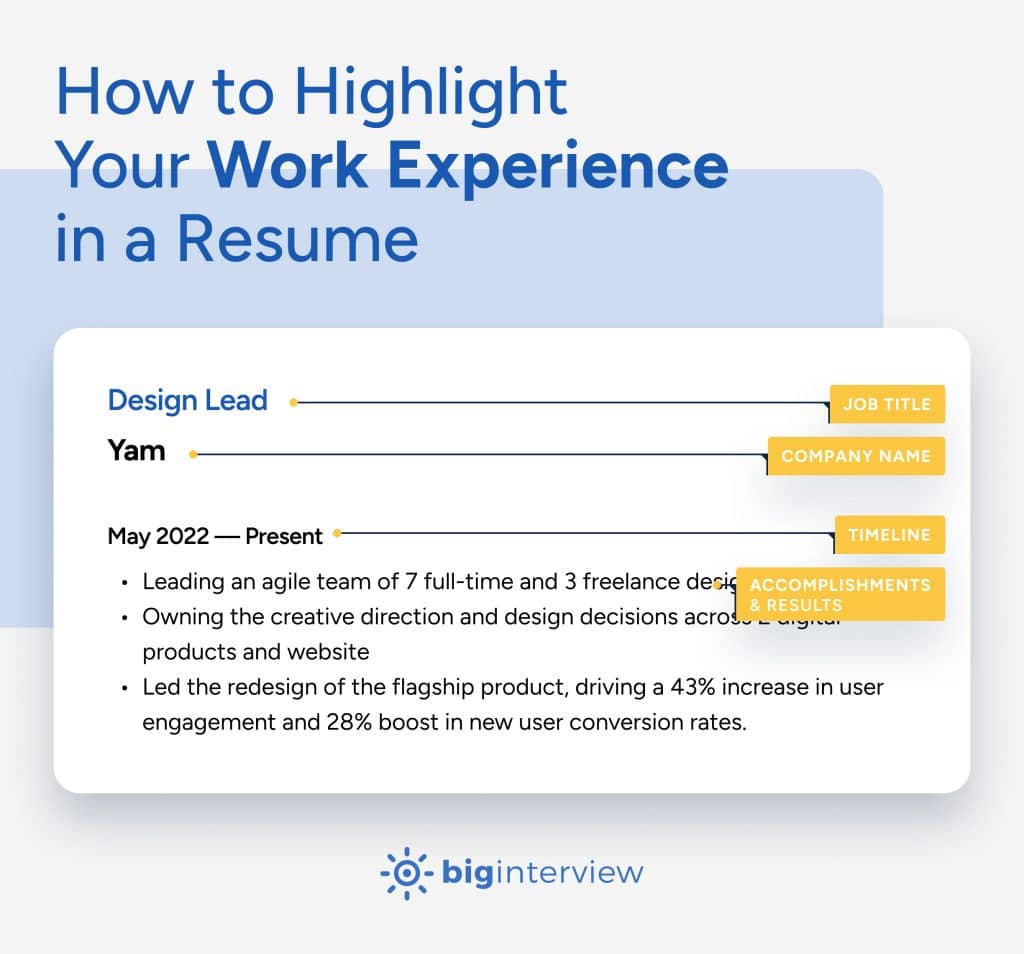
1. Put it under a clear, legible heading
Make sure your work experience section is clearly visible and has its own heading. You can name this section “Work Experience”, “Experience” or “Employment History”.
2. Place it right under the resume summary or objective
It’s best to place the experience section right under your resume summary or a resume objective. However, if you’re fresh out of college and have little or no work experience, you can fit the work history under your education section.
3. List your most recent experience first
You typically list your work experience in reverse chronological order — put your current or most recent gig at the top, followed by the previous one, then the one before that, and so on.
This is effective because it gives the hiring team the most relevant information instantly. If you’re a UX designer looking for a new opportunity, the hiring manager will want to know about your most recent accomplishments to see how you progressed, where your expertise lies, and how your latest experience can translate into success in your new role.
4. Include relevant experience
Do you need to put all your past experience on a resume? By no means. Professional resume writers and career coaches advise that you include up to 15 years of relevant work experience. Including every single job you’ve done (like that pizza delivery summer gig when you were 16) can actually work against you.
Remember, this is just a general rule that can be broken in certain situations.
For instance, if you’re looking for a job in tech, where skills, frameworks, and tech stacks change often, your experience from 13 years ago may not be truly relevant today.
Also, if you’ve had a major career change, e.g. switched from teaching to copywriting 10 years ago, you could omit your teaching roles. However, if working in that position gave you relevant skills and experience that you still consider useful and valuable (e.g. clear communication, time management, or presentations), you can definitely include it in your resume.
Read on if you’re changing careers, switching from the military, or are freshly graduated (we’ll cover those scenarios in a bit).
5. Be clear, concise, and consistent with your formatting
This is a big one. It’s crucial to format your entries properly so that the information is easy to spot and read. Also, consistency is hugely important. Maintain the same order of information in each entry for a polished, organized, and harmonious look.
Here’s how you can order the items in a single work experience entry:
- Your position (usually written in bigger font or in bold)
- Company name
- Dates worked
- Bullet points highlighting your responsibilities and achievements
6. Use bullet points to describe your responsibilities and achievements
Instead of writing a paragraph or description explaining your role in detail, make sure to use a bulleted list (it’s way clearer, better organized, and memorable).
Next, it’s always wise to focus on your most important accomplishments and achievements, rather than simply listing your everyday responsibilities. After all, the point of this section is to gently persuade the hiring team that you’re equipped to do the job and that you have an excellent track record.
In other words, this is where it pays to take a moment to think back to your biggest career wins and corroborate that with some data (more about this later).
Finally, make sure to limit the number of bullets as you go back in time. While it’s perfectly fine to have 5–8 points for your latest job, 3–4 will be enough for older entries.
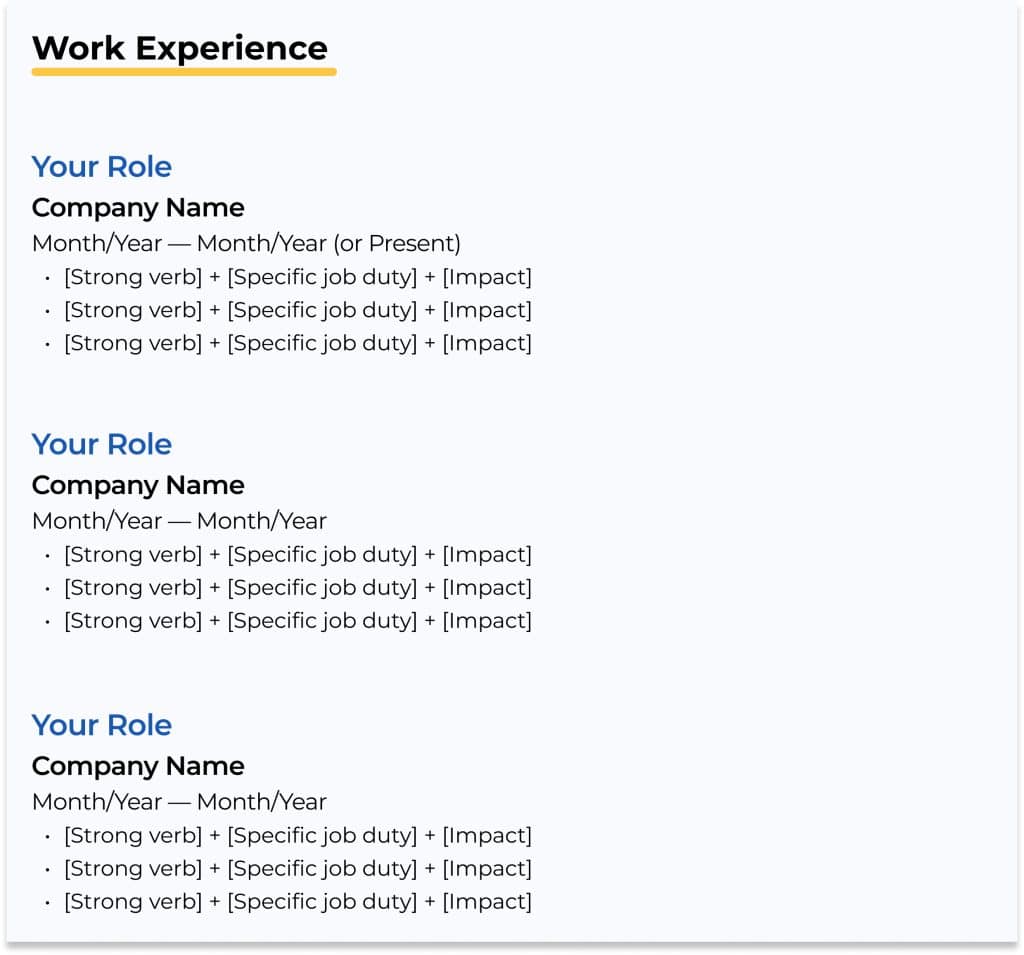
Now let’s put theory into practice and look at two great examples of work history on a resume that follow the steps we discussed above.
Sample resume work experience section (senior candidate)
Vice President of Marketing Vue 03/2017 – Present
- Helmed website overhaul, resulting in increase of organic traffic by over 300%
- Spearheaded the team of 7 full-time employees and 12 contractors
- Tracked email, PPC and display marketing performance to optimize cost per lead
- Hit 541% and 137% return on marketing investment for organic and email, respectively
Sample resume work experience section (junior to mid-level candidate)
- Responded to up to 20 tickets a day, resulting in 97% first touch resolution score
- Maintained a >9.0 monthly average satisfaction rating each of last 12 months
- Resolved 7 escalations with the IT/SysDev teams in the last 3 months
- Wrote 24 knowledge base articles to reduce ticket resolution times by 1.3 minutes
How to Take Your Resume Work Experience Section from Standard to Job-Winning
Now let’s zoom in on your work experience section even closer and help you take those bullet points from average to outstanding. To sell yourself on your resume, just follow these simple tips.
1. Focus on achievements over day-to-day duties and quantify wherever possible
This is precisely where most candidates get stuck. A lot of you are probably thinking: yes, I’ve heard this piece of advice many times. But I don’t have any stellar achievements. I just do my job well .
Precisely. That’s enough to be sure you do have achievements. You might not even know it. And the best way to showcase those is by hard numbers.
Again, don’t freak out. You don’t have to be in the data and numbers game to be able to come up with quantifiable results and statistics. There are simple strategies to present tangible results to back up your accomplishments. And just so you realize how miserably bad people are at showcasing their accomplishments —
Here’s a real-life story that a resume-writing consultant friend told me.
He was hired to revamp a spacecraft engineer’s resume (btw, how cool is that!). When she walked him through her resume and explained what each item meant, one caught his attention — ” Optimized and automated the procurement and invoicing flow. ” Optimizing and automating? That always means something cool.
She eventually explained how she made a highly complex process fully automatic, and in doing so, saved around 18 work hours a month for 7 people each. These people were paid an average of $200/hr. That’s $1.3 million a year saved for the company. And that was not on her resume.
Why am I telling you this?
Because this is proof that you’re not alone in being horrible at framing duties as achievements. Apparently, even the most extraordinary candidates are. Bottom line: you will most definitely stand out if you know how to do it!
So here are a few tips on how to really stand out from the crowd:
Mention the scale , e.g. how many people you managed, or the size of the budgets you handled
- Provided consultations for 120 students a year over 7 consecutive years
- Managed a shift of 70 workers in a 250.000 square foot facility
- Standardized the Sales process in a 2000-employee company averaging 300M annual ARR
- Controlled an annual marketing budget of $30K
Mention the frequency , e.g. how many tasks you performed within a time frame
- Wrote 14 new SEO-optimized articles in the last quarter
- Onboarded 17 Fortune 2000 clients in 2021
- Performed 13 weekly technical website audits and resolved 25 issues
- Hosted 5 company webinars attracting a total of 790 B2B leads
Mention specific results , e.g. money and time saved
- Reduced the employee turnover rate by 5% in 2021
- Tripled the number of Instagram sales since 2019
- Reduced cost per sale from 3.8K to 2.7K in two years’ time
- Attracted 2.6 new LinkedIn followers in the last quarter
Pro tip: Record your accomplishments as they happen. This is how I do it. Every time something cool happens (e.g. 89% of email subscribers click on the CTA button in an email and read my article or 5 product demos were booked on a blog page that I wrote), I take a note in a Google document. Even if I’m not actively looking for a job. (Or not even thinking about it.) In time, you’ll have a killer list of accomplishments to add to your resume, cutting your writing time in half. Otherwise, you’ll either forget the details or spend hours digging through your old projects to find the right info.
2. Use action verbs at the beginning of your bullet points
If you take a closer look at all the examples we listed in this guide so far, you’ll notice a few common themes — none of the bullets start with “I” and they sound super descriptive although we used zero adjectives.
The secret lies in action verbs, the powerful verbs that are used at the beginning of each bullet to draw the reader in and show your impact.
Take a look at these examples again:
- Responded to an average of 20 tickets a day, resulting in 97% first touch resolution score
- Received 9.1 satisfaction rating in the last 365 days
- Resolved 7 escalations in the last 3 months with the IT/SysDev teams
Combined with numbers and specific results, these verbs show the recruiting team exactly how you accomplished things and attained goals at work.
There are extensive lists of power/action verbs you can find on the web, but here’s a short list of our favorite ones to get you started.
Top 50 action verbs to use in your resume work experience section:
- Coordinated
- Established
- Facilitated
- Implemented
- Standardized
- Streamlined
- Strengthened
Expert tip: Vary your power verbs to avoid repetition. Keep your bullet points as short as possible and avoid the use of pronouns, articles, and adjectives.
Here’s an example of a bland work experience section turned amazing and catchy by applying the 3 tips above.
- Responsible for all content marketing activities in the company
- I was in charge of the link-building project
- Proofreading of the copy before publishing.
Why we think it sucks:
Let’s dissect this Frankenstein.
- Consistency issues: Although the candidate uses the bulleted list to provide more information about their recent role, they are not consistent. The first bullet starts with an adjective, the second uses a pronoun (“I”) and looks like an actual sentence, while the third one starts with an -ing form. All in all, it’s a mess.
- No details or real info: The candidate uses overused phrases like “responsible” and “in charge of” combined with little other info. All in all, super bland and nonspecific.
Now let’s see how you can transform this meh work history section into an unforgettable one by using action verbs and quantifiers.
- Designed annual content marketing strategy, resulting in 247 SQLs (500+ employees)
- Oversaw a team of 10 writers, resulting in 60 do-follow links in the last 90 days
- Increased content downloads website-wide by 78%
- Conducted quality assurance for 100% of content
Why we love this version:
First, it’s super specific and it tells us exactly what this Content Marketing Manager did. Next, they listed the results of their efforts in a consistent and persuasive way. Finally, a nice mix of power verbs (designed, oversaw, increased, and conducted) leaves the reader with the impression that this person knows what they’re doing.
3. Customize your employment history section to the job description at hand
We’ve been saying this forever and we’ll say it again: don’t expect to have a single resume that can win you endless jobs. Heck. Don’t expect a generic, all-purpose resume to land you more than 1 interview out of 50 applications.
That’s not how the pros do it.
Instead, you’ll need multiple versions that you’ll then further customize by tailoring your work experience section to the exact position you’re targeting.
The easiest way to do this is to peruse the job description, identify which skills and requirements matter to the employer and then have your resume prove that you possess those very skills.
Here’s how it works in practice.
Let’s say a MarTech company is looking for someone to join the Billing Customer Support Team.
Here is a sample job ad and some of the requirements and duties listed in the description:
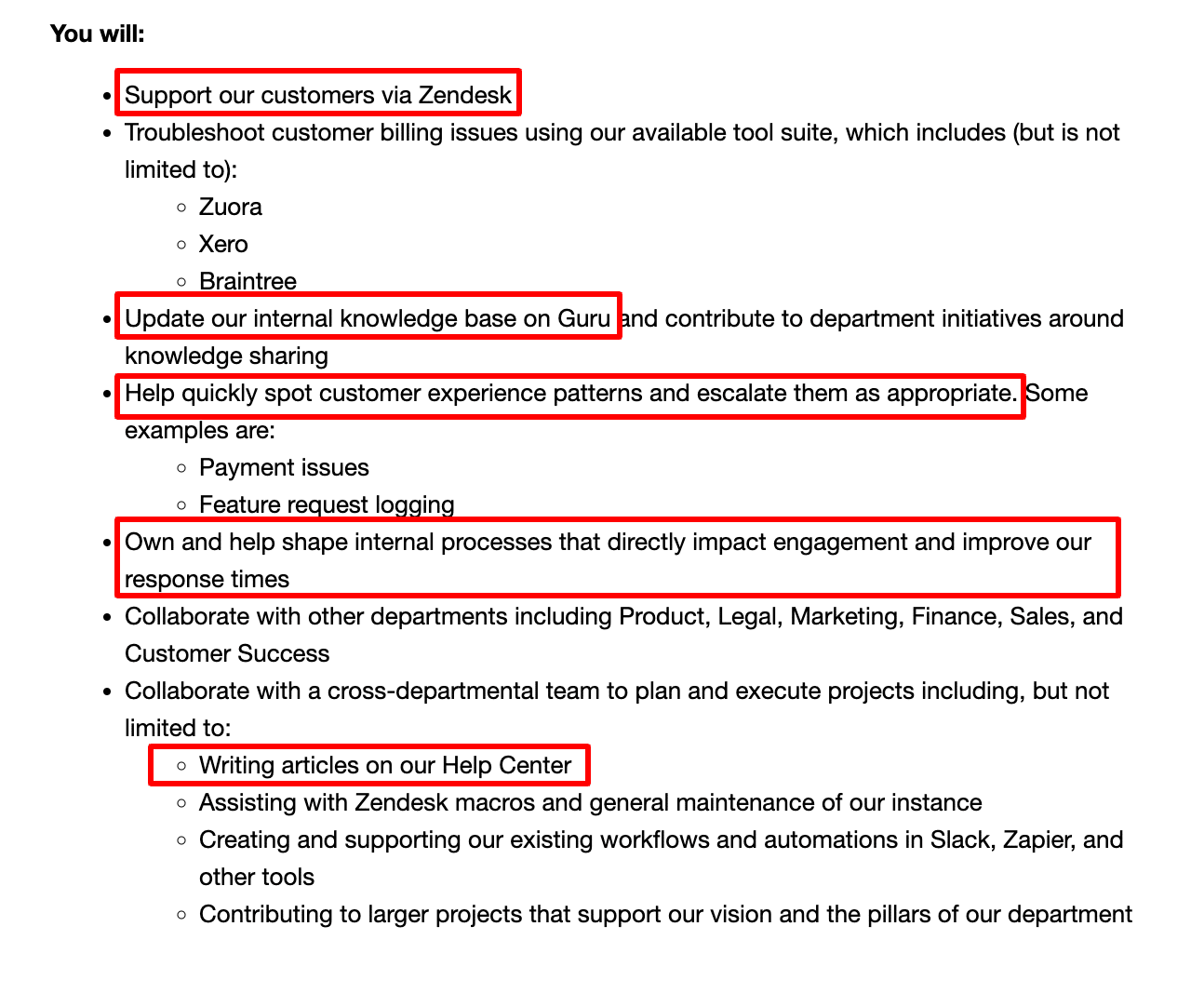
After carefully reading the job description details, this candidate found 5 points they have previously excelled in. Next, they’ll use them as guidelines to tailor their work experience resume section to match the requirements 100%.
Customer Support Engineer Omnis
- Solved a daily average of 20 Zendesk tickets over a 3-year period
- Maintained the internal knowledge base 100% clean and up to date
- Prioritized feature requests and worked with AppDev and PO until implementation
- Hit company-record ticket response times (11 hours Zendesk; 2 minutes live chat)
- Authored a total of 56 technical articles in the Help Center
Why we like this answer: The candidate relied on the information from the job ad to highlight their accomplishments in a clear and convincing way. They showed their familiarity with Zendesk, their dedication to keeping the internal company wiki updated, and proved that they are independent and proficient enough to write technical documentation. Finally, they illustrated most of their efforts with relevant metrics and KPIs and used power verbs to convey authority and skill.
How to List Work Experience on a Resume for Different Scenarios
This may make perfect sense to someone who’s had 10+ years of experience and few job gaps. But what if you’re applying for a job outside your industry or aren’t sure whether to include your volunteer experience? Here are all your questions answered.
How to show a promotion on your resume?
If you’ve held multiple positions in the same company or if you’d like to highlight your growth and change in roles, you can approach this in two different ways.
1) List them as a single entry if similar and if the career path is clear. Start with the company name, dates worked, and then list your positions together with the from-to period when you held them. Like this:
Acme Technologies Inc. 03/2017 – Present
Content Marketing Manager (01/2021 – Present) (a bullet-pointed list of accomplishments)
Content Writer (03/2017 – 01/2021) (note the promotion, followed by a bulleted list of responsibilities and achievements)
2) List them as two separate entries if you made a bigger shift or changed departments (e.g. started in a call center, then switched to Business Development).
A note of caution: When using stacked entries (1), there’s a chance that the ATS software won’t recognize your promotion as such, and may list your skills and experience under the earlier position. To ensure your resume will be well-parsed by the ATS and look good, it’s safer to stick to the format shown in (2) and list your promotions as two separate entries.
How to put freelance work on a resume?
Absolutely include your freelance work in your employment history, as it shows your versatility, skill set, and soft skills like client management, negotiation, and independence. Here’s an example of how a writer and illustrator listed their freelancing experience.
Content Writing Consultant (alternatively, you can use Contractor ) Freelance
- Contributed original blog content to businesses (include most notable clients)
- Increased organic traffic by 250% with a 6-month blog project
- Helped generate 14 Fortune 2000 leads through Google AdWords over a 6-month period
- Illustrated for both web and printed media
- Provided 50+ illustrations for clients such as NewYorker Magazine, CondeNast, Monocle
- Won Best Book Cover Award (Illustration Category) in 2021
- Collaborated with 20+ teams with an average UpWork score of 4.8
Should I include volunteer work on my resume?
If you can supply at least 5 years of paid work experience, you can skip your volunteering experience altogether or add them to other resume sections.
If your employment history is short or if you’re just starting your job search after being a stay-at-home parent or a student, then definitely include the volunteering gigs in your main work history section. After all, recruiters love seeing this type of experience — it tells a lot about who you are as a person, what you’re passionate about, and that you’re not entirely motivated by money.
How to list part-time jobs on a resume?
When adding your part-time jobs to your resume work history, treat it like any other entry. However, make sure to add that you worked part-time. A simple note next to your position works just fine. Like this:
Online Marketing Specialist (part-time) Forwa
- Posted 5 blog posts weekly in WordPress over a 2-year period
- Set up an average of 10 email marketing campaigns/week
- Assisted 2 Lead Gen Specialists to clean 14 lists over a 2-year period
How to put internships on a resume?
You can include your internship just as you would with any other work experience, no matter if it was paid or not. Add your official role, the company name, and then provide a bulleted list of your responsibilities and accomplishments. Here’s how one candidate did it:
- Used javascript, HTML, and bootstrap to build UI pages
- Worked closely with frontend developers to solve more complex issues
- Collaborated with backend developers and UX/UI designer to assess requirements
How to explain employment gaps on a resume?
I’ll start with a general note here: people freak out about their employment gaps way more than they should. Yes, employment gaps on your resume can be considered red flags, but not by default.
As a matter of fact, a recent study published in the American Economic Review reveals that “long-term unemployment spells in the past do not matter for employers’ hiring decisions.” The study also found that all subsequent experiences canceled out the gaps in employment, as well as that employers didn’t treat short-term and long-term unemployment much differently.
So no reason to panic, okay?
You’d normally have the chance to explain the gaps in your employment in an interview. To get there, it’s wise to address them in your resume work experience section and provide a bit of information and context.
This is especially valid if the gaps are bigger and happened for a good reason like getting a degree, being a full-time parent or caregiver, or for medical reasons.
And here’s how you can integrate that smartly into your resume employment history.
- Took time off from professional career to provide care for a baby and a toddler and manage the household
- Used the gap years to complete 3 B2B Sales courses
(In case you need more inspo, here’s what else you can put on a resume .)
Resume Work Experience Examples for Different Careers
Here you’ll find some of the best resume experience examples for the most common professions.
Customer service and tech support
- Assisted customers and troubleshot technical issues on 30+ calls/day on average
- Resolved 90% of issues without transfers or escalations
- Decreased cancellations by 11% over a one year period
- Ran regular customer satisfaction surveys resulting in 9.6/10 satisfaction rating
- Built close relationships with CIOs and CTOs from prospective companies
- Provided software demonstrations to 52 companies in the last quarter
- Closed 36 new deals, hitting a 69% closing rate in the last quarter
Software engineering
- Worked with PO team to update and rearchitect 50+ page web app
- Built 5 additional features in the last 12 months
- Cooperated with a team of 8 agile developers to prioritize biggest impact features
Office administration
- Provided reliable administrative assistance to the Regional Manager
- Organized 2 conferences for 2000+ attendees
- Managed 7 workshops and 10 local events over a two-year period
- Interviewed 6 potential new candidates and trained 3 new team members
Digital marketing
- Posted daily on 5 company social media profiles
- Interacted with 10 LinkedIn HR influencers every day
- Grew the LinkedIn account by 525% over a six-month period
- Provided emergency health care to 20 patient per shift on average
- Participated in 300+ emergency procedures over a one-year period
- Exceeded standards of care to hit 9.7 patient satisfaction rating in an anonymous survey
- Prepared and delivered 100% of lessons to second year students (<20 students/class)
- Coordinated 30+ extra study sessions to prepare students for state exams
- Increased assignment completion by 40% via technology-based learning during Covid19
Business analysis & data science
- Reduced the cost of IT infrastructure by 24% via alternative software solutions
- Relocated budget from social to organic for 30% increase in ROI
- Restructured the Sales department, resulting in 45K of new revenue
Find out how to write a next-level resume work experience section for 100+ other professions in this free resume library .
Need a bit more guidance?
You can hop over to Big Interview’s Resume Builder, where you’ll get to enter your information section by section (basic info and contact details, summary, work experience, education, certifications, skills), choose the design and then have the tool create a resume for you. Here’s what you’ll find inside:
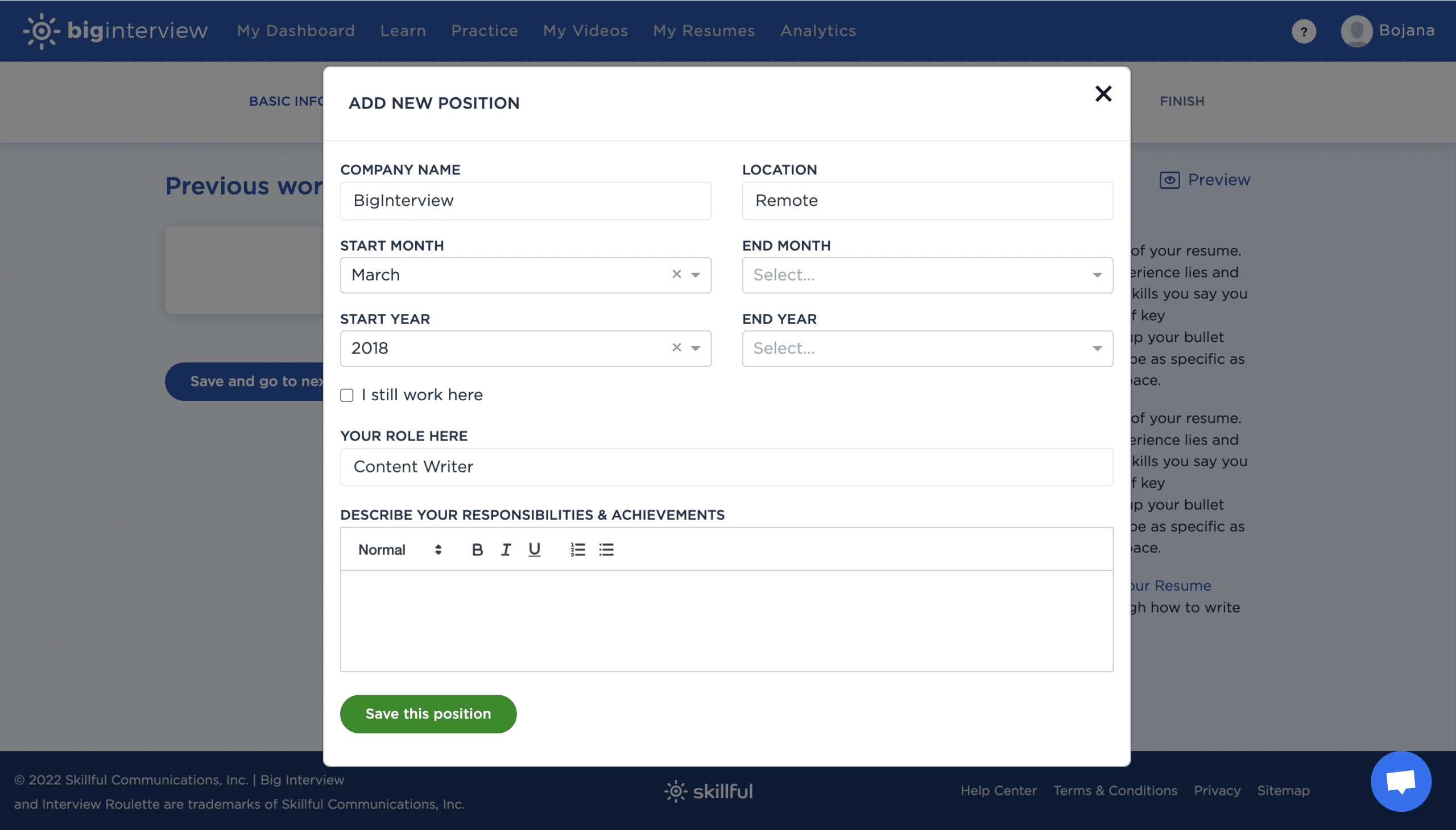
This is super useful because you can easily create many iterations (for different job ads) and save a bunch of time in the process.
Once that’s done, you can also use ResumeAI , a new feature that assesses your resume for various criteria hiring teams use in real life – how easy it is on the eye, how you used action words to convey experience and skills, and whether it’s ATS-friendly Basically, you’ll get a rating based on how effective you were in showcasing your skills and experience.
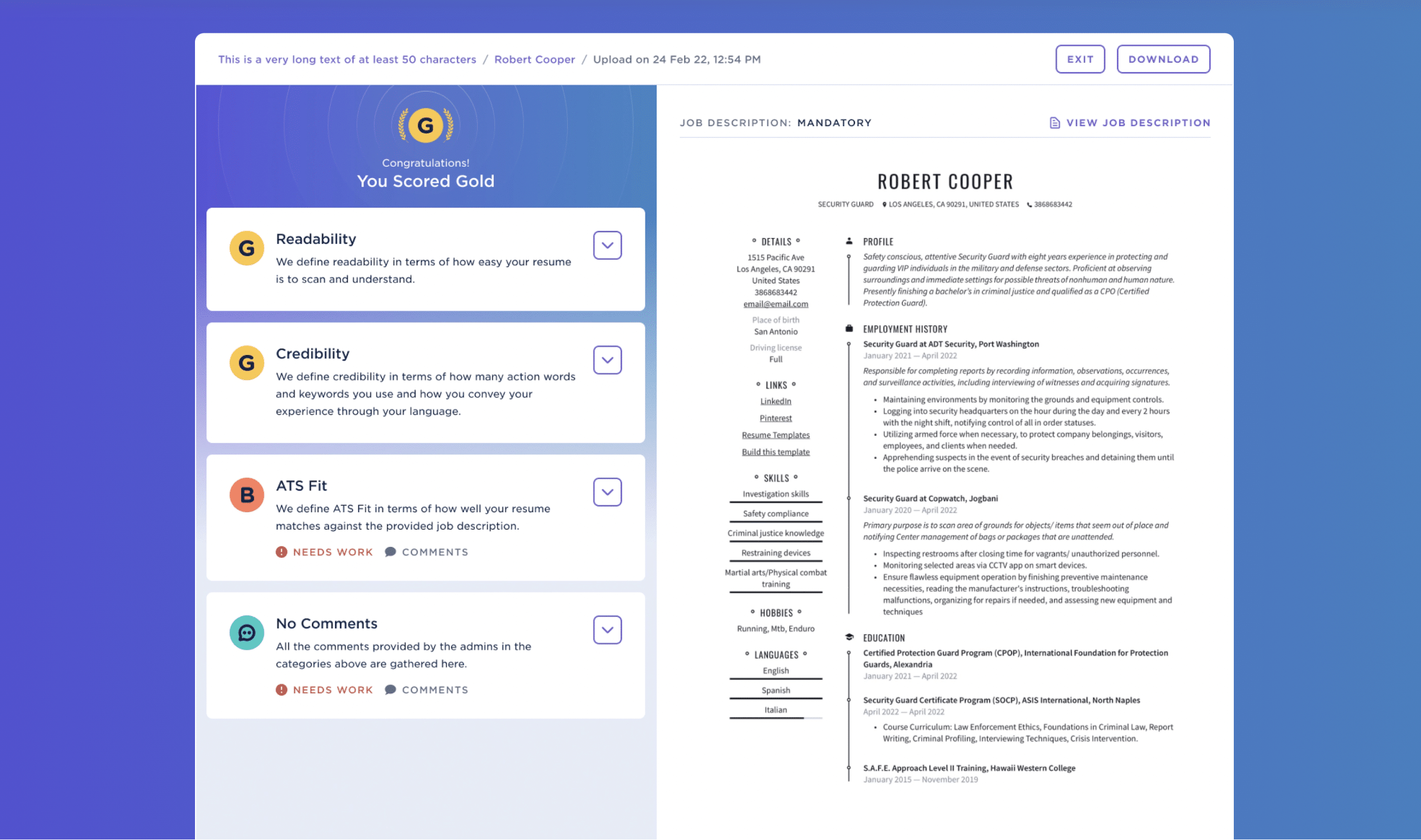
And if you need a bit more support, we created a short course on resume writing, designed and led by our own co-founder, Pamela Skillings (aka *the resume and job interview guru*). In this curriculum, you get 8 video lessons with Pam (with a transcript), after which you’ll be 100% sure to crush that resume.
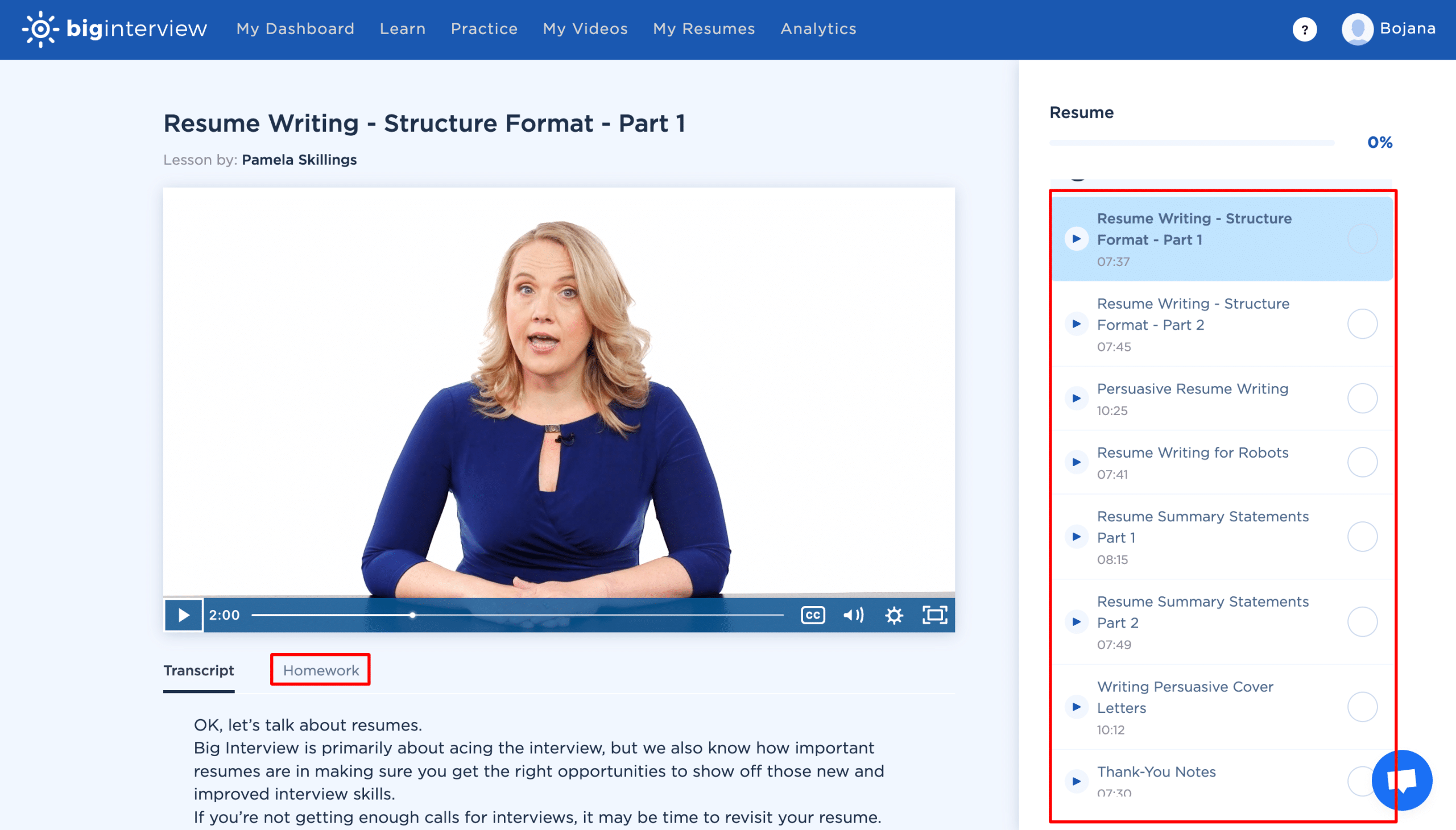
Key Points Summarized
TL; DR? Here’s the essence of a killer resume work experience section that you can copy in no time.
- A well-written employment history section directly impacts your chances of being shortlisted. Take some extra time to do it right.
- Always present your work experience in a clearly separated section and place it under your resume summary.
- Begin with your current (or most recent) job and work backward from there.
- Include the following information, in this order: your position, company name, and dates worked.
- Back up this information with a bulleted list of up to 5 achievements and responsibilities. Forget false modesty and show your excellent track record. Quantify and provide tangible results wherever possible. Use power verbs to convey authority and entice the hiring team.
- When applying for multiple jobs in different companies, custom-tailor your work experience section to each job opening. Browse the job requirements and duties and match them with examples from past experience.
- Bonus tip: Keep the high standards in other resume sections too. Learn how to best showcase your skills on a resume.
How many years of work history should I describe on a resume?
List 10–15 years of experience, depending on your individual circumstances. The key thing here is to include only relevant work experience, so if you’ve been in the job market for 10 years, but only 6 are relevant to the job you’re applying for, focus on those 6 years. You can still list the previous experience, but there’s no need to go into great detail.
How many bullet points should I use per entry in the work history section?
A common guideline is to have 3–8 bullet points per entry. This way you can give plenty of relevant information about your achievements and responsibilities without overwhelming the reader with excessive detail. You can use 5–8 for your most recent and penultimate positions. As you work your way backwards, 3 bullet points is usually enough. Remember to aim for quality over quantity — if you can fit your best accomplishments into 3 bullet points, there’s no need to write 2 additional weak ones. Make sure to refer to your “strongest” qualities in the first 2 bullets.
What work experience should I not include in my resume?
Here are some examples of work experience that should not be included in your resume: irrelevant experience, experience from over 15 years ago, high school jobs, or volunteer work. However, this all depends on where you are in the career journey. For example, for first-time job seekers, school jobs, part-time jobs, and volunteer experience will matter.
What should I do if I have little to no work experience?
If you have no or little formal work experience, include other types of experience and focus on your qualifications and results. Some ideas to consider: internships, volunteer work, academic projects, freelance or contract work, leadership roles in student associations or sport clubs, and community work. Don’t worry about your title or if it was a formal experience. Instead, focus on the relevant skills and tangible results you accomplished in these roles.
Should I put volunteer experience in my work history section?
You can include it if you have little to no relevant professional experience. Otherwise, you can put it in a separate resume section or omit it if your resume is already full.
How to address gaps in employment in my work experience section?
If there’s a significant gap in your resume, address it proactively in the document and don’t wait for it to come up at the interview (imagine you miss out on one because of that gap!). This way, your potential employers will know you have nothing to hide. Briefly explain the reasons for the gap, keep your language positive, and mention if you did any coursework or upskilling during that time. If you took a sabbatical to travel, take care of a family, or get degrees to prepare for a career change, say it proudly.
When should I take a job off my resume?
A general rule is to remove a job from your resume if it’s no longer relevant to the position you’re applying for. For example, if you’re applying for a marketing role, already had 4 marketing roles, but had initially worked as a history teacher for 1 year, it’s safe to assume your history teacher experience can be taken off. The point is to not overwhelm the resume with unrelated experience. You can also remove some short-term jobs or jobs you had a long time ago, especially if your resume is already getting longer than 2 pages.
Should I include a job I was fired from on my resume?
That depends on several factors. If this was a recent position you held for a long time, you should include it. Otherwise, there would be a big employment gap that you’d still have to address (and it may come up anyway during a background check). If you can come up with a tactful, honest explanation behind the termination, and especially if you’ve gained new relevant skills in the meantime, don’t hesitate to include that position. On the other hand, if the job was a long time ago or if it’s unrelated to the position you’re currently applying for, feel free to omit it.
Pamela Skillings
Fact Checked By:
Turn interviews into offers
Share this article
- Big Interview
- Plans & Pricing
- Higher Education
- Editorial Process
- Resume Templates
- Interview Preparation
- Interview Q&A
- Career Advice
- Create an Account
- Knowledge Base
©️ 2024 Skillful Communications, Inc. | Big Interview is a trademark of Skillful Communications, Inc.
Terms | Privacy Policy
10+ Resume Template for 10 Years Experienced Professionals
Extremely professional 10+ resume templates for those who want to show their 10 years of experience and stand out from the crowd.
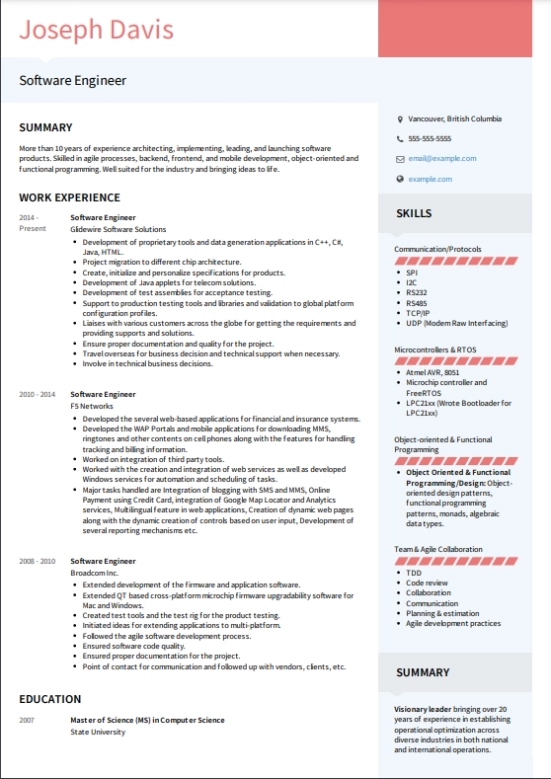
Administration Resume Template for 10 Years of Experience
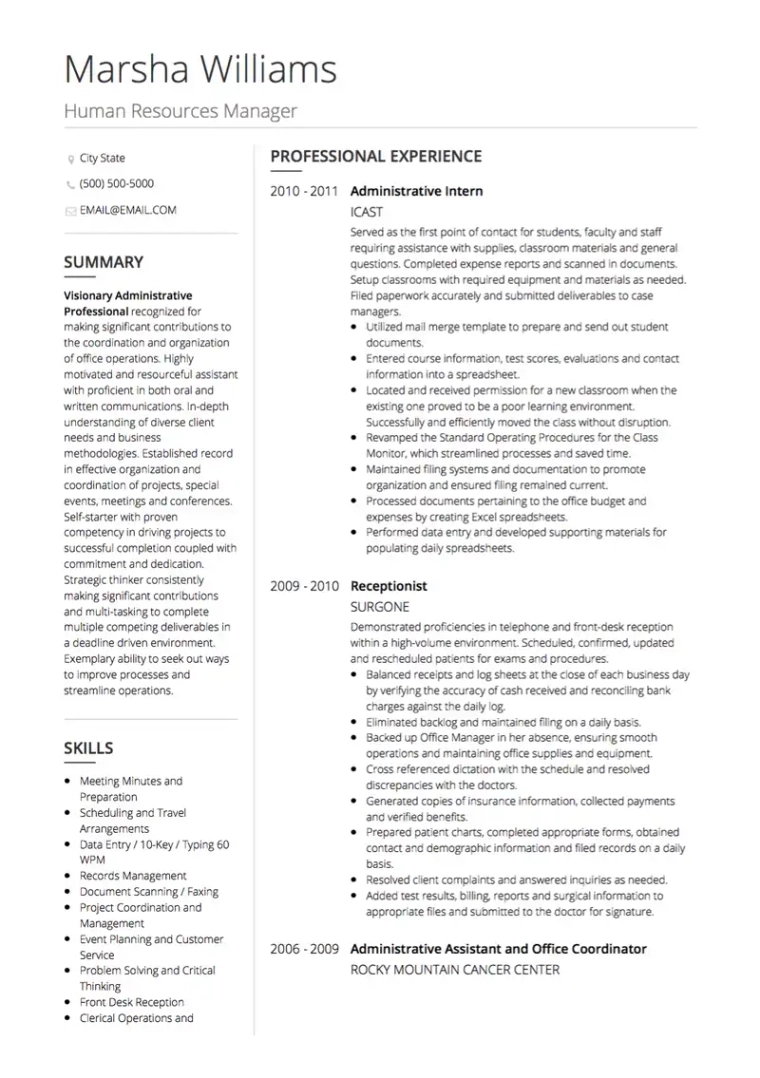
Professional Resume Template for 10 Years Experience
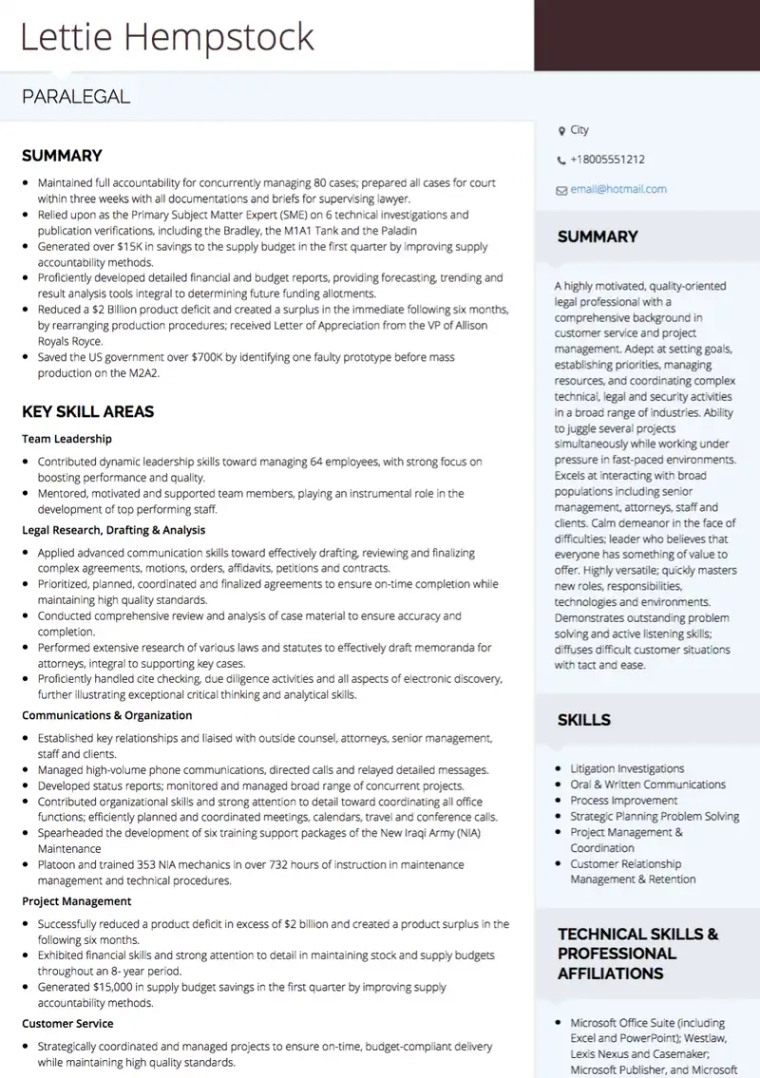
Manager Resume Template for 10 Years Experience
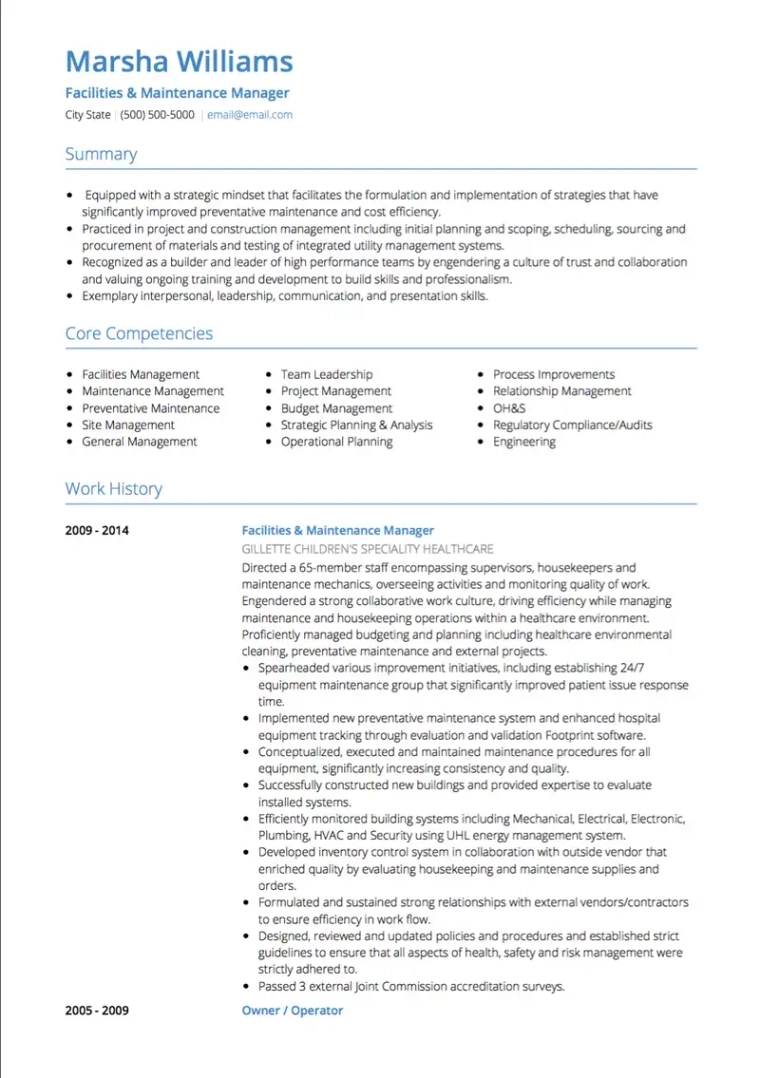
Marketing Resume Template for 10 Years Experience
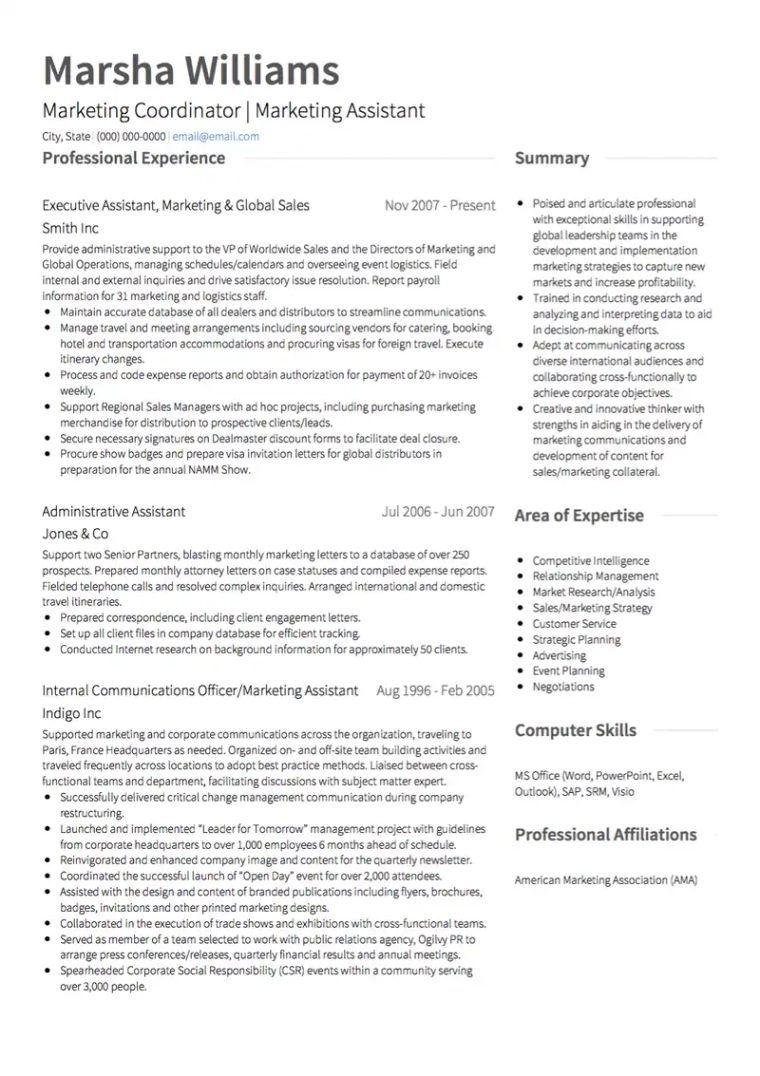
Software Engineering Resume Template for 10 Years of Experience
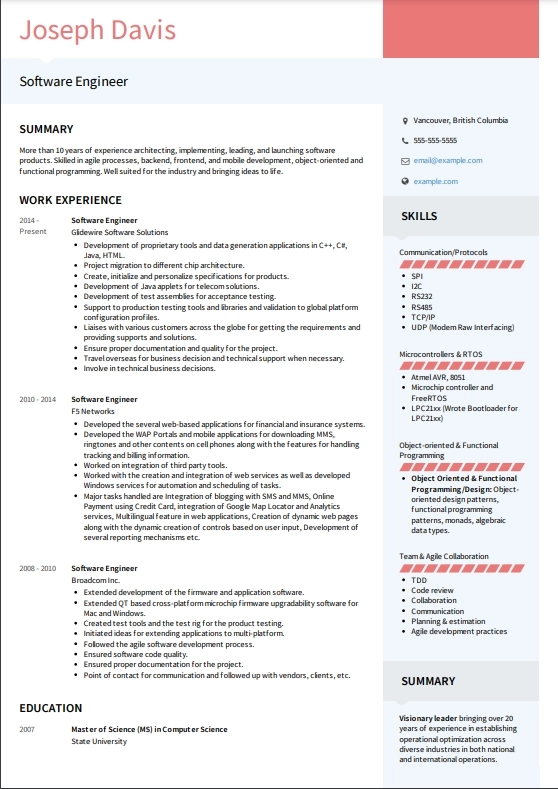
Resume Template for 10 Years Experienced Executives
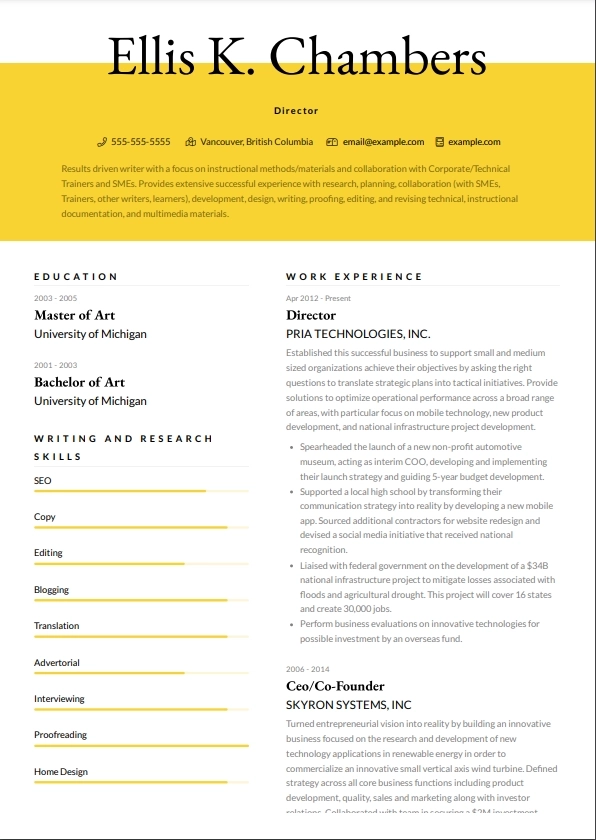
Writing/Editing Resume Template for 10 Years of Experience
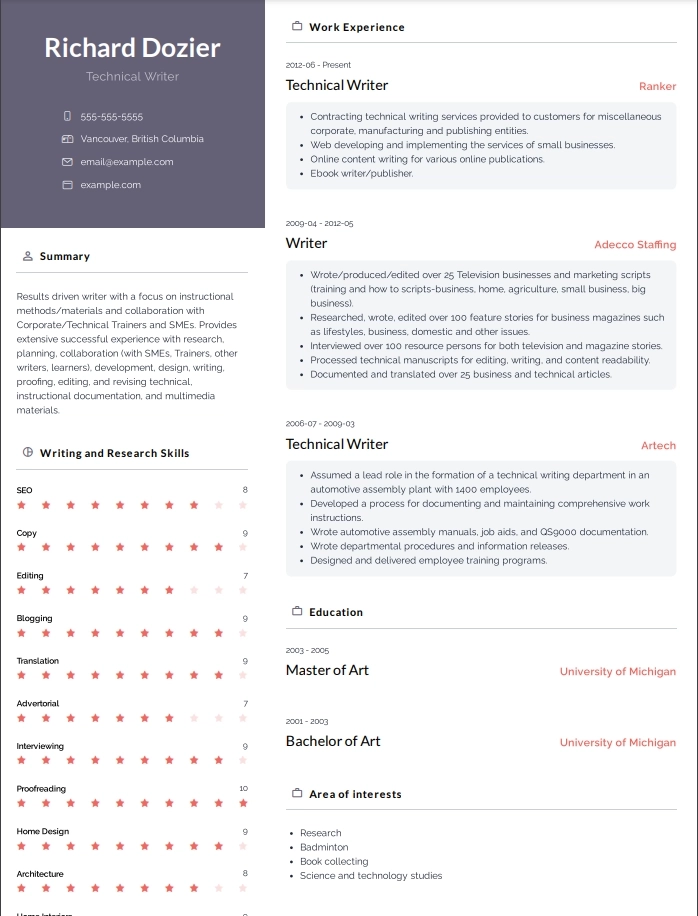
Resume Template for 10 Years of Sales Experience
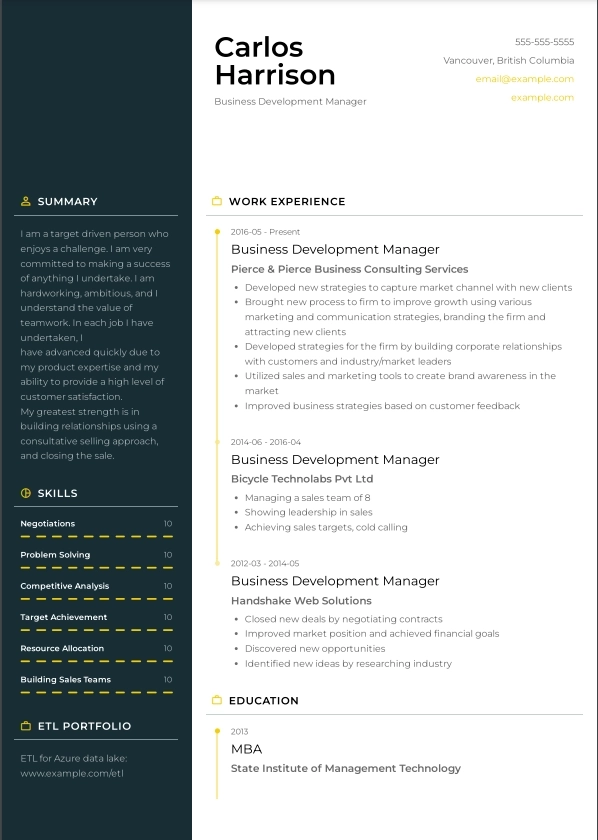
Resume Template for 10 Years Experienced Candidate
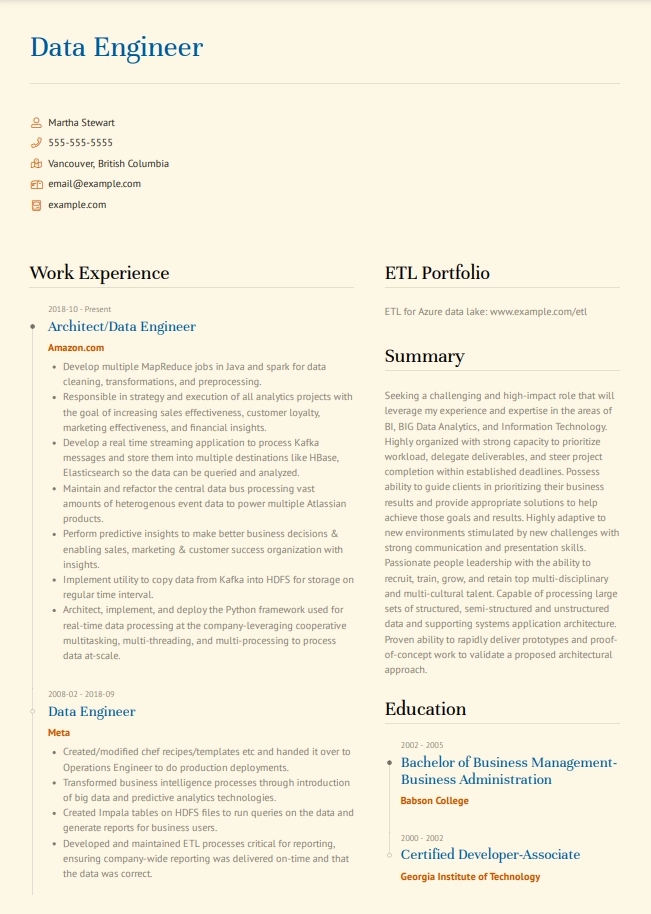
Finance Resume Template for 10 Years of Experience
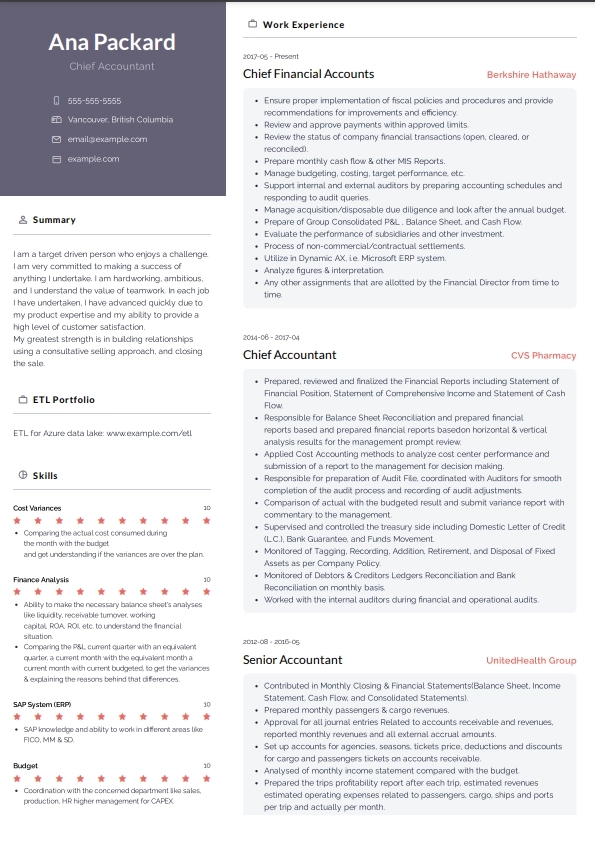
Which Resume Format is Best for Someone With 10 Years of Experience
For any professional with 10 years of relevant work experience, we recommend using a reverse chronological resume format.
For any professional with 10 years of experience trying to apply for jobs to make career transitions, we recommend a functional resume or a combination resume to stand out.
Here are the criterias on when to use either of the three resume formats to show a 10 year experience.
Reverse Chronological Resume Format for 10 Years of Experience
- Consistent career progression over 10 years.
- Highlights recent experience and career growth.
- Easy for recruiters to follow and understand.
- Preferred in industries favoring traditional formats.
- Limited flexibility for emphasizing specific skills or downplaying career gaps.
Functional Resume Format for 10 Years of Experience
- Diverse skills but non-linear career paths.
- Emphasizes skills and accomplishments over specific job titles.
- Downplays career gaps or transitions.
- Less common in some industries.
- High flexibility for showcasing relevant skills but may be less compatible with Applicant Tracking Systems (ATS).
Combination Resume Format for 10 Years of Experience
- Balances chronological and functional formats.
- Highlights both career progression and key skills.
- Increasingly accepted in various industries.
- Offers flexibility for tailoring the resume to job requirements.
- High compatibility with ATS, suitable for online job applications.
Here’s a matrix that simplifies how to select the best resume format if you have 10 years of experience:
| Factor | Chronological Resume | Functional Resume | Combination Resume |
|---|---|---|---|
| Career Progression | ✓ | ✗ | ✓ |
| Recent Experience | ✓ | ✓ | ✓ |
| Easy to Follow | ✓ | ✗ | ✓ |
| Stability | ✓ | ✗ | ✓ |
| Longevity | ✓ | ✗ | ✓ |
| Skills Emphasis | Moderate | High | High |
| Career Gaps | Highlighted | Downplayed | Highlighted |
| Industry Standards | Common | Less common | Becoming common |
| Flexibility | Limited | High | High |
| ATS Compatibility | High | Moderate | High |
| Personalization Options | Limited | Moderate | High |
Tips To Write the Best 10 Years Experience Resume
- Summary : Ensure your resume kicks off with a robust summary or profile, encapsulating your decade-long expertise. Highlight significant achievements, leadership roles, and career aspirations within your industry. You don’t need an objective unless you are making a career transition.
- Work experience : Prioritize recent and relevant experiences from the past 10 years. Ensure alignment with the job you're targeting, showcasing your depth of knowledge and accomplishments gained over the years.
- Format : Use the right resume format from reverse chronological, functional or a combination resume format.
- Achievements : Quantify achievements with specific numbers and metrics to showcase the tangible impact of your work. Highlight milestones like revenue generated, cost savings, project completions, or team successes.
- Skills : Spotlight advanced technical skills and expertise developed over 10 years, emphasizing proficiency in industry-specific tools, software, programming languages, and emerging technologies.
- Certifications and credentials : Demonstrate commitment to continuous learning and professional development by listing relevant certifications, advanced training programs, industry conferences, or specialized workshops completed throughout your career.
- Customization : Tailor your resume for each job application by strategically selecting and emphasizing experiences and skills that closely match the job requirements and align with the employer's needs and expectations.
- Clean and consistent : Present your resume in a clean, professional format that's easy to read and visually appealing. Ensure consistency in formatting, font styles, and layout throughout the document to maintain a polished appearance.
- Proofread : Thoroughly proofread your resume to eliminate any typos, grammatical errors, or formatting inconsistencies. Given your extensive experience, pay particular attention to detail and accuracy to present yourself as a meticulous and reliable professional.
- Add a cover letter : Accompany your resume with a customized cover letter that complements your career narrative, expands on key achievements and experiences from the past decade, and articulates your enthusiasm for the specific role and company. Use the cover letter to further showcase your fit for the position and your value proposition as a seasoned professional.
How Long Should Your 10 Years Experience Resume Should be?
Your 10 years of experience resume should typically be one page long. Keeping your resume to one page ensures that you present a concise and focused document that quickly grabs the attention of hiring managers.
There are some situations where someone with an experience of 10 years would have more than a one page resume and it is acceptable. Some of these situations are:
- Holding multiple leadership positions, such as Vice President of Sales and Director of Marketing, within the same company or across different organizations.
- Demonstrating diverse experiences across industries, such as working in finance, healthcare, and technology sectors, each requiring distinct skill sets and expertise.
- Accumulating a substantial list of certifications, such as Project Management Professional (PMP), Certified Public Accountant (CPA), and Six Sigma Black Belt, relevant to your field.
- Receiving numerous awards and recognitions, such as "Salesperson of the Year" or "Top Performer" accolades, highlighting your exceptional achievements.
- Publishing articles or research papers in reputable journals or presenting at industry conferences, showcasing your thought leadership and expertise in your field.
- Targeting industries or positions that require a more comprehensive understanding of your professional background, such as executive roles in finance, where detailed financial analysis and strategic planning experience are crucial.
- Applying for senior-level positions where employers expect a thorough overview of your qualifications, including extensive work history, leadership experience, and specialized skills.
- Seeking roles in academia or research institutions, where a detailed curriculum vitae (CV) is typically required to document academic achievements, publications, presentations, and professional affiliations.
Copyright © 2024 Workstory Inc.
Select Your Language:

- Resume Templates
Choose a free Resume Template and build your resume. Use our intuitive drag-and-drop resume builder and save it as a PDF in minutes. Start building your resume right now.
Double Column
Free, Two Column resume template. The most popular choice for most roles, including programming & marketing.

The classic Harvard template, updated for the 21st century with a refined design that recruiters love and an optimized structure for improved ATS performance.

Elegant template with a beautiful design and compact, easy-to-read layout that highlights your strengths and achievements.
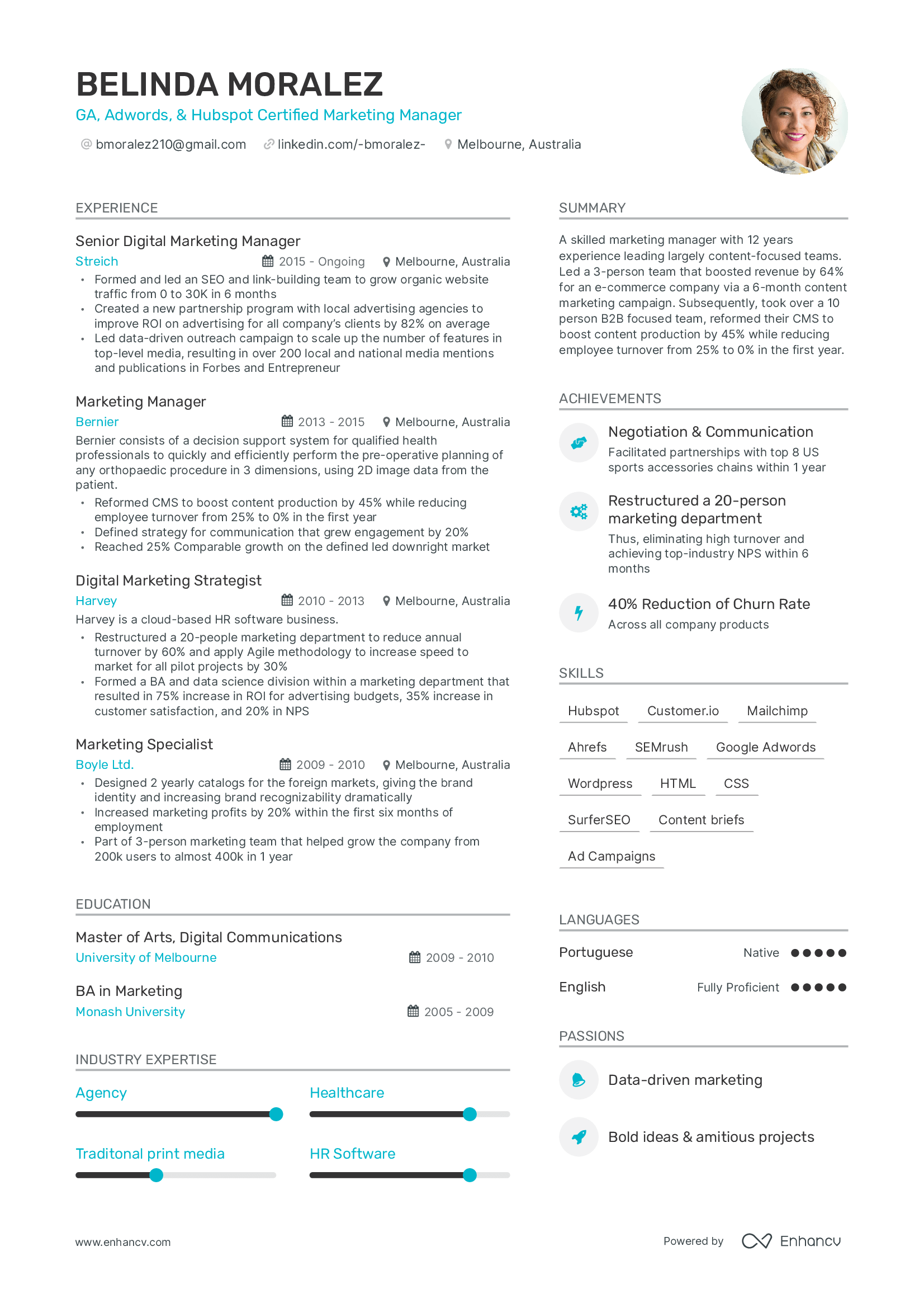
The most popular template for upper management roles, project managers and product owners.
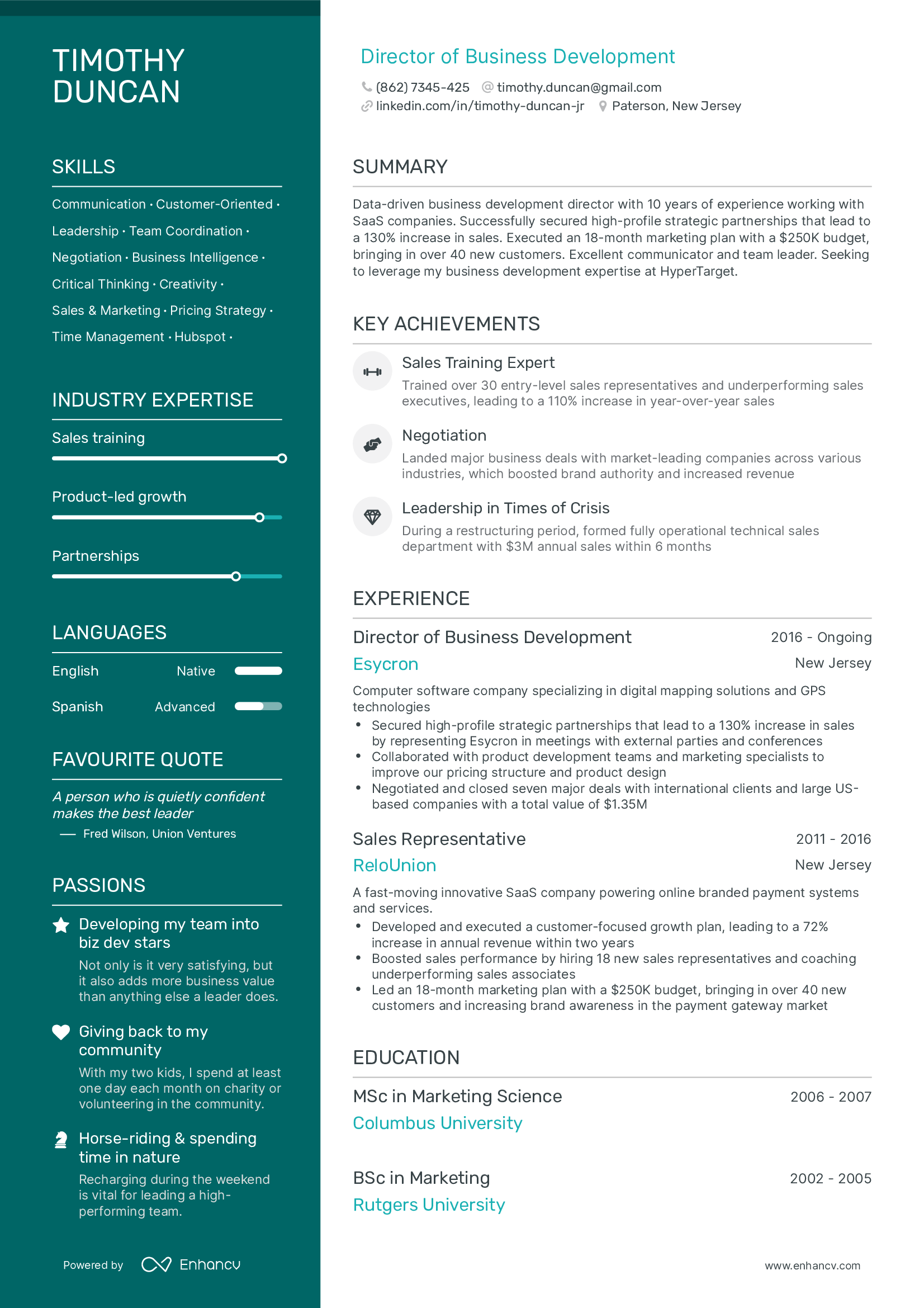
A refined template, especially great for positions where presentation is paramount: business development managers, sales leaders & other customer-facing roles.

A creative template that accents your header and makes recruiters want to read the rest. Built for any industry.

A timeline resume template. Organized neatly with a Timeline to show your career progress. For experienced professionals.

Are you a software engineer or a data scientist with a lot of skills & projects to list on your resume? This template allows you to create a perfect one-page resume.
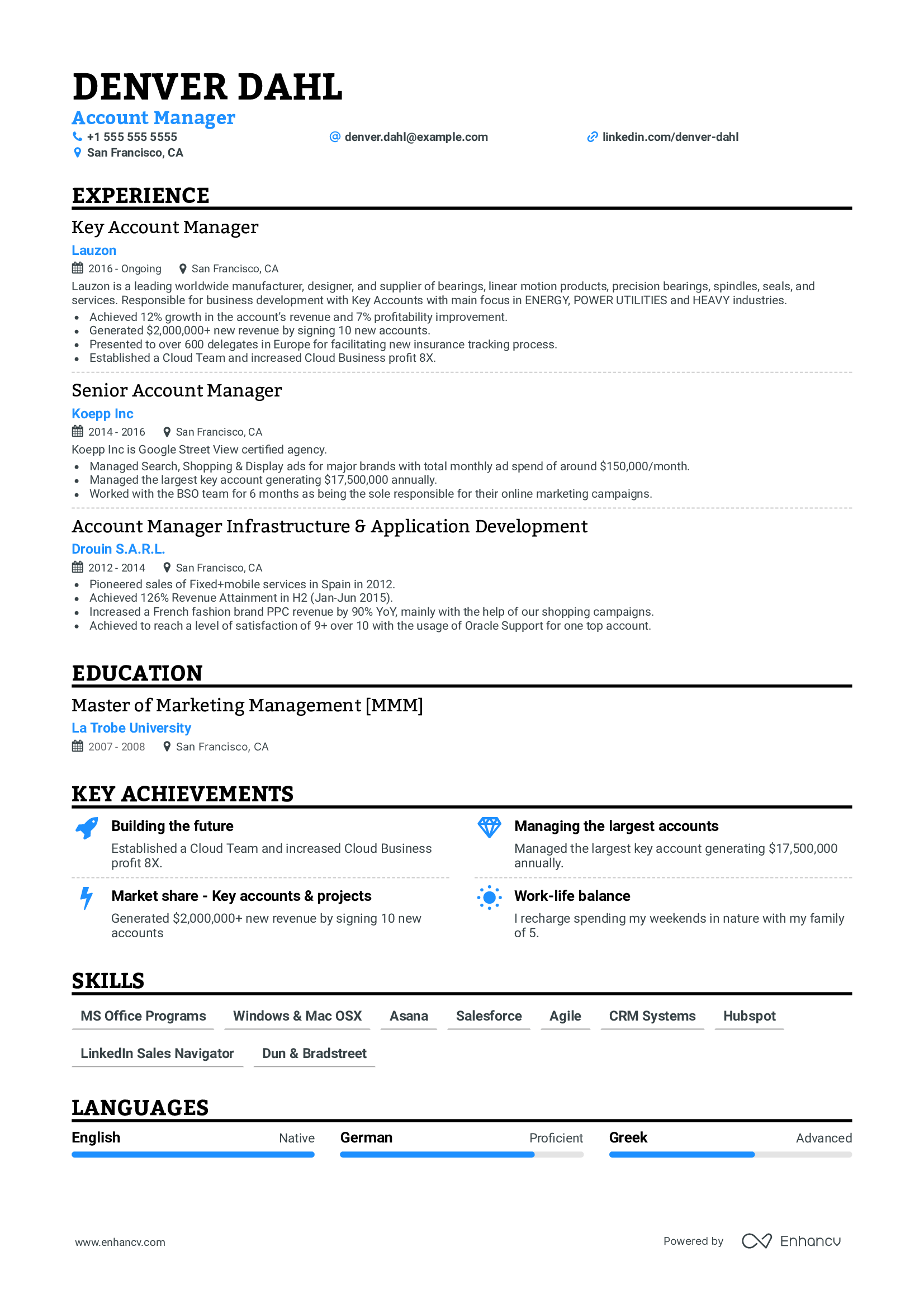
Single Column
Free, simple resume template. Easily readable by both humans and ATS bots.
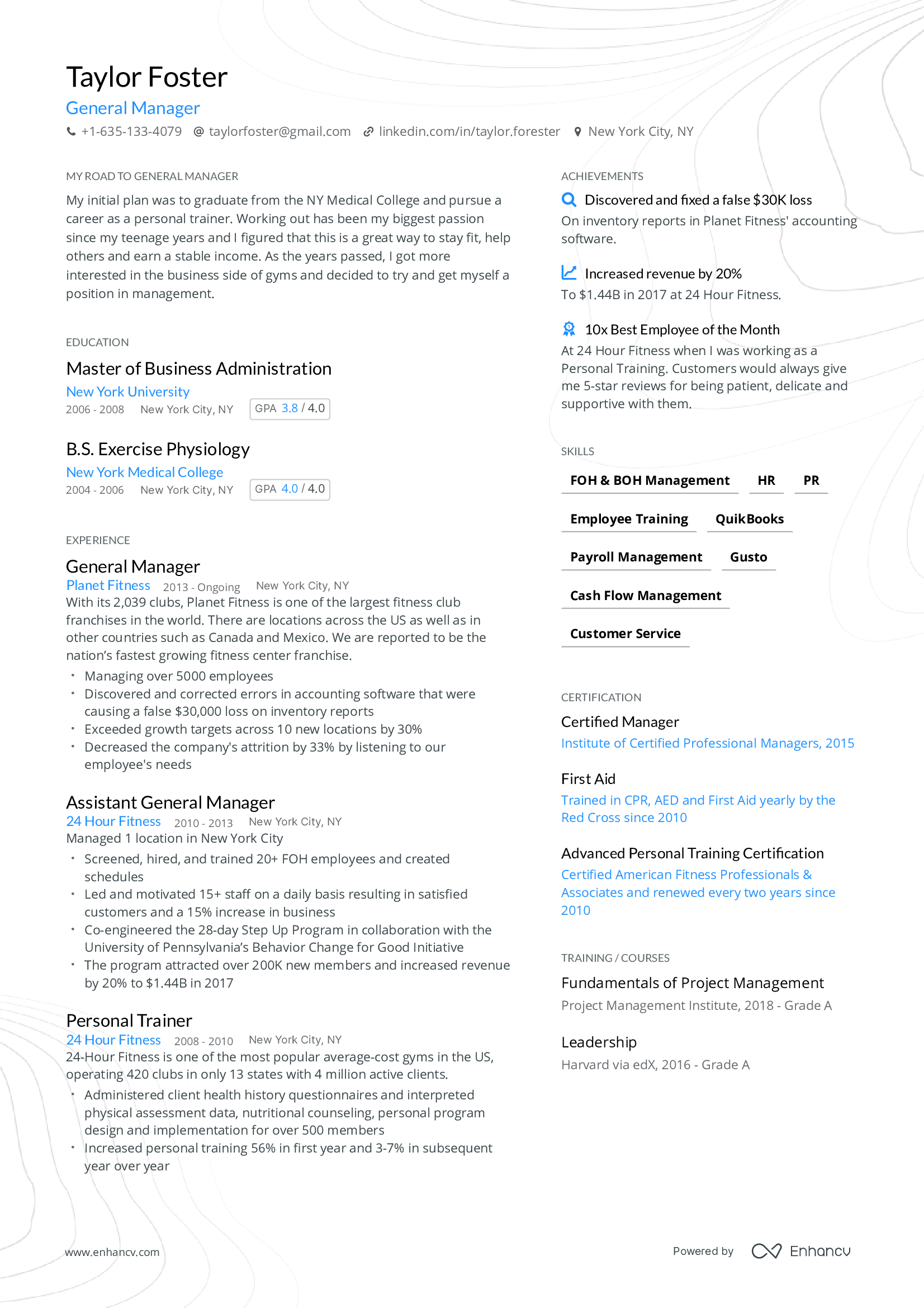
Designed as a one-page resume template for mid-level roles with 3-10 years of experience.
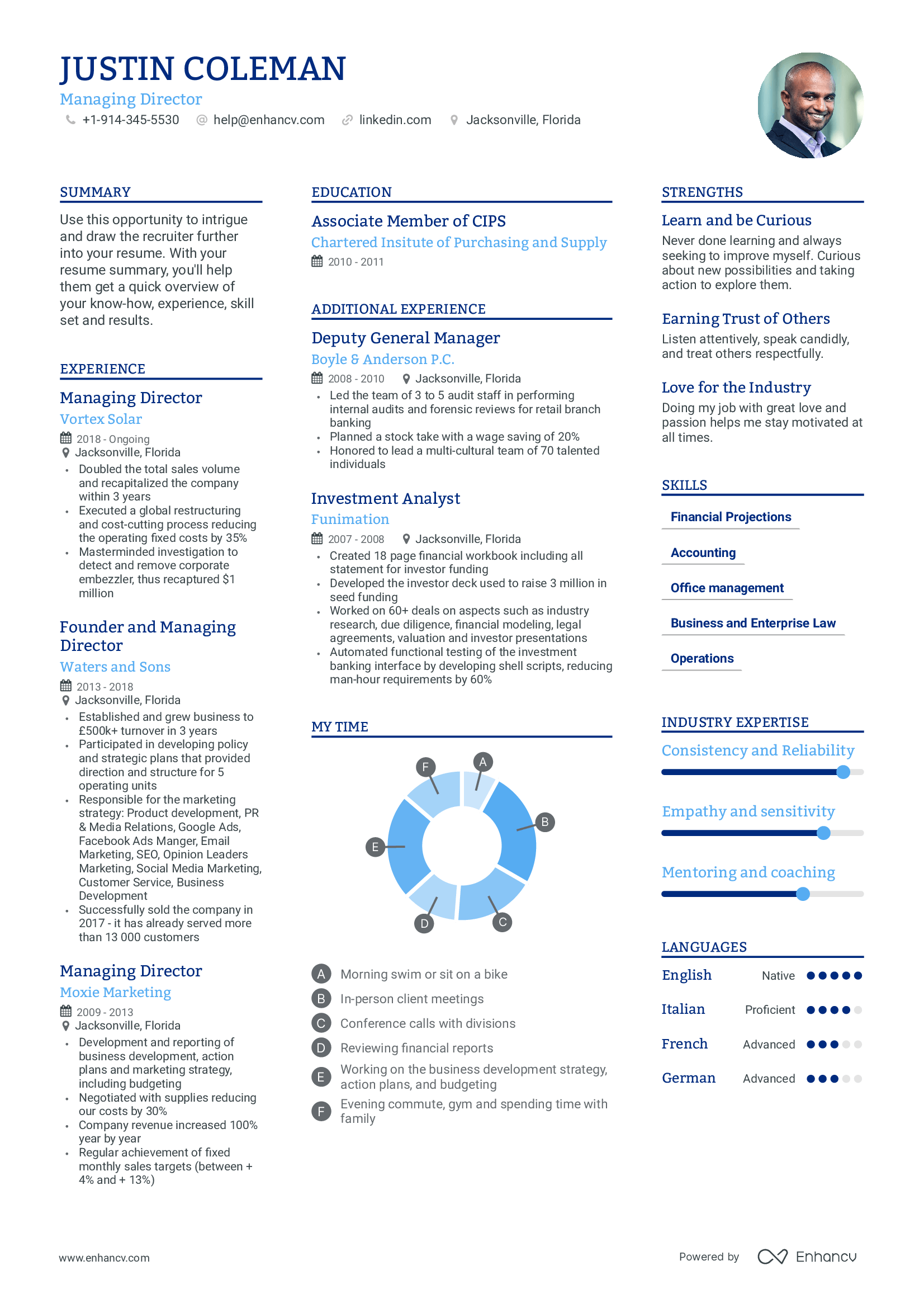
Multicolumn
Multicolumn resume template. Made for executives to fit additional info in a third column.
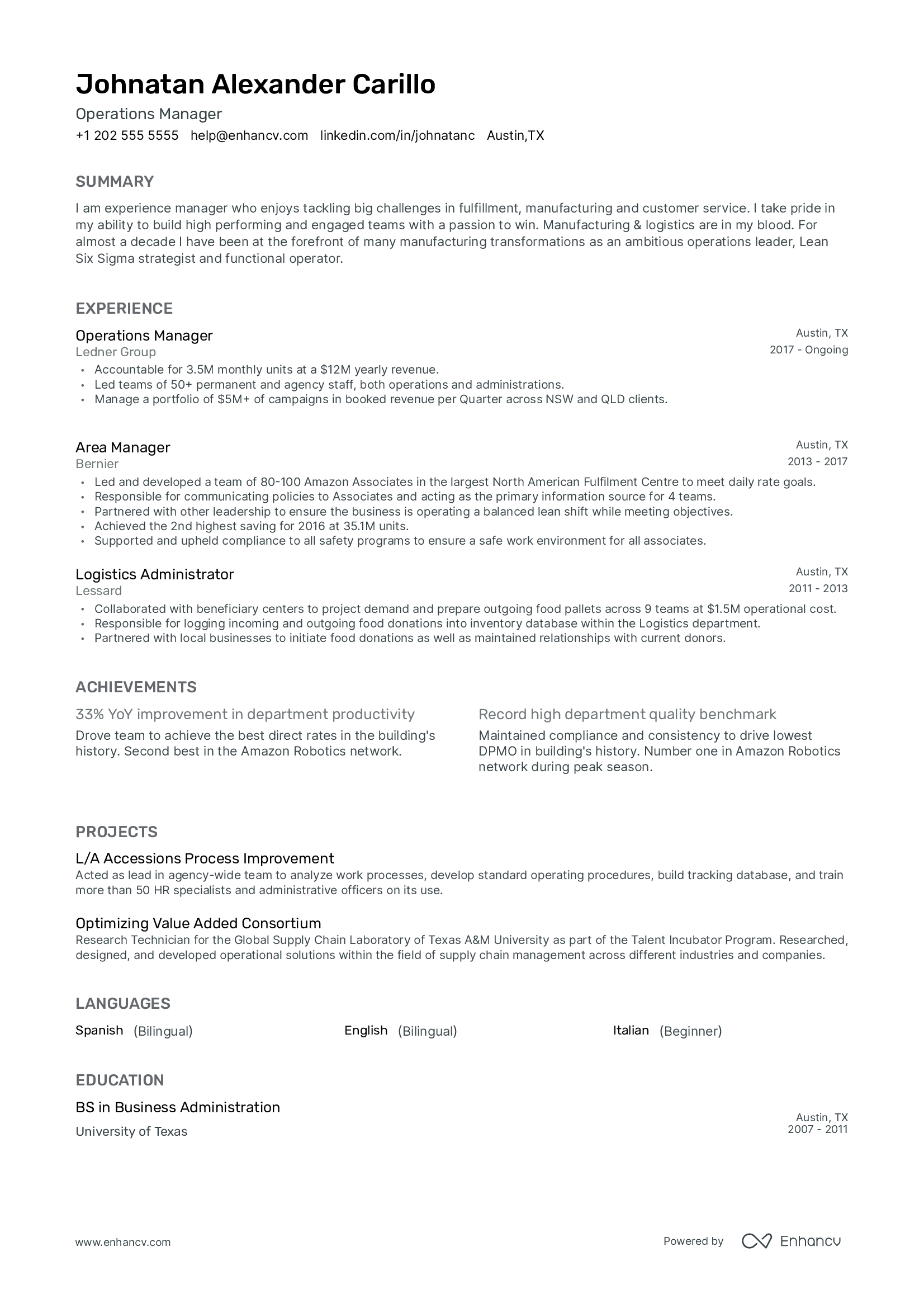
Traditional resume template. Fitting for conservative industries.
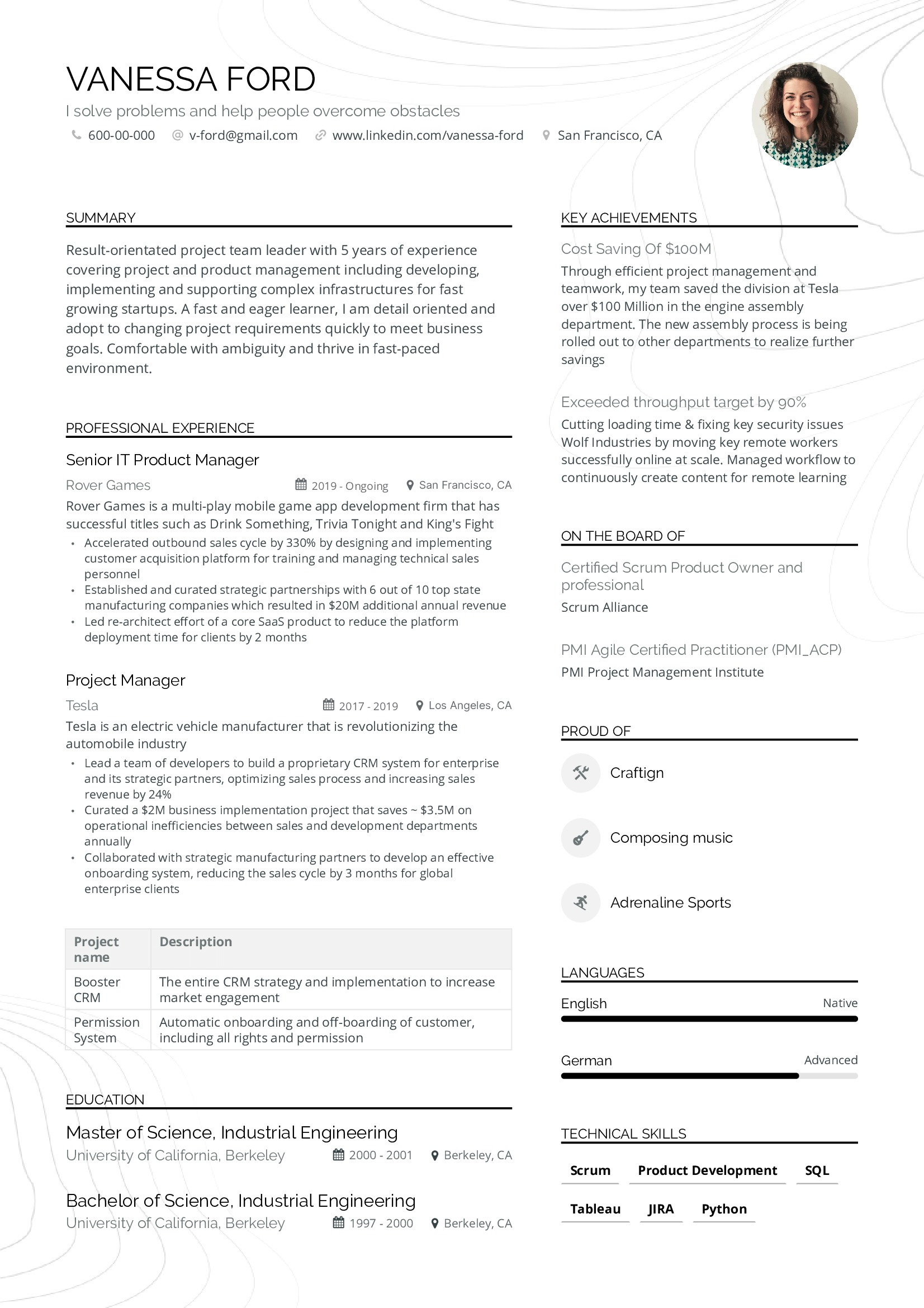
High Performer
Data-focused resume template. Perfect for project and product managers.

Minimalistic resume template. Blends whitespace and content, without clutter.
How It Works

Select a template.

Fill in your details.
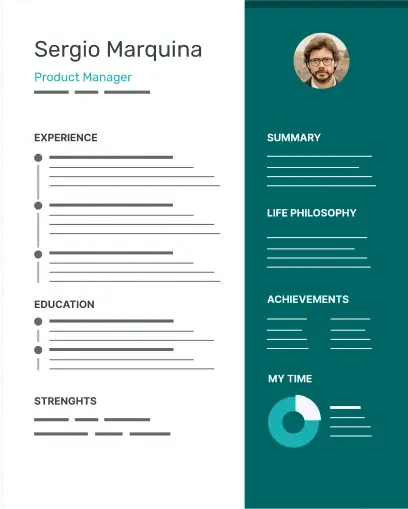
Customize your design.
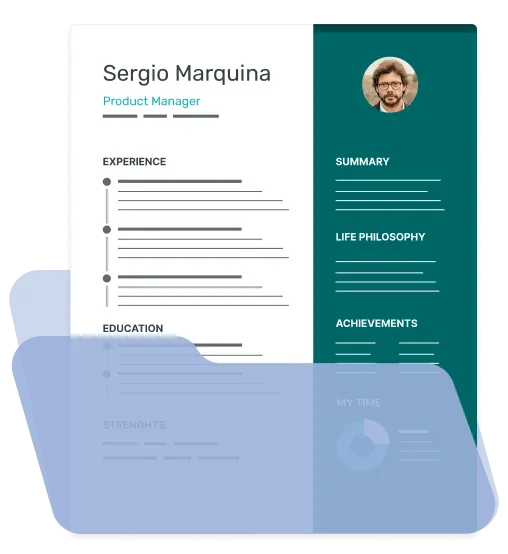
Tailor, Check for Errors, and Download.
Resume Templates by job
Unleash the full potential of your career with professionally vetted resume templates. Take a look at samples from real resumes that helped people get hired at top companies in your field, and build a job-winning resume yourself.
Search more resume examples by job
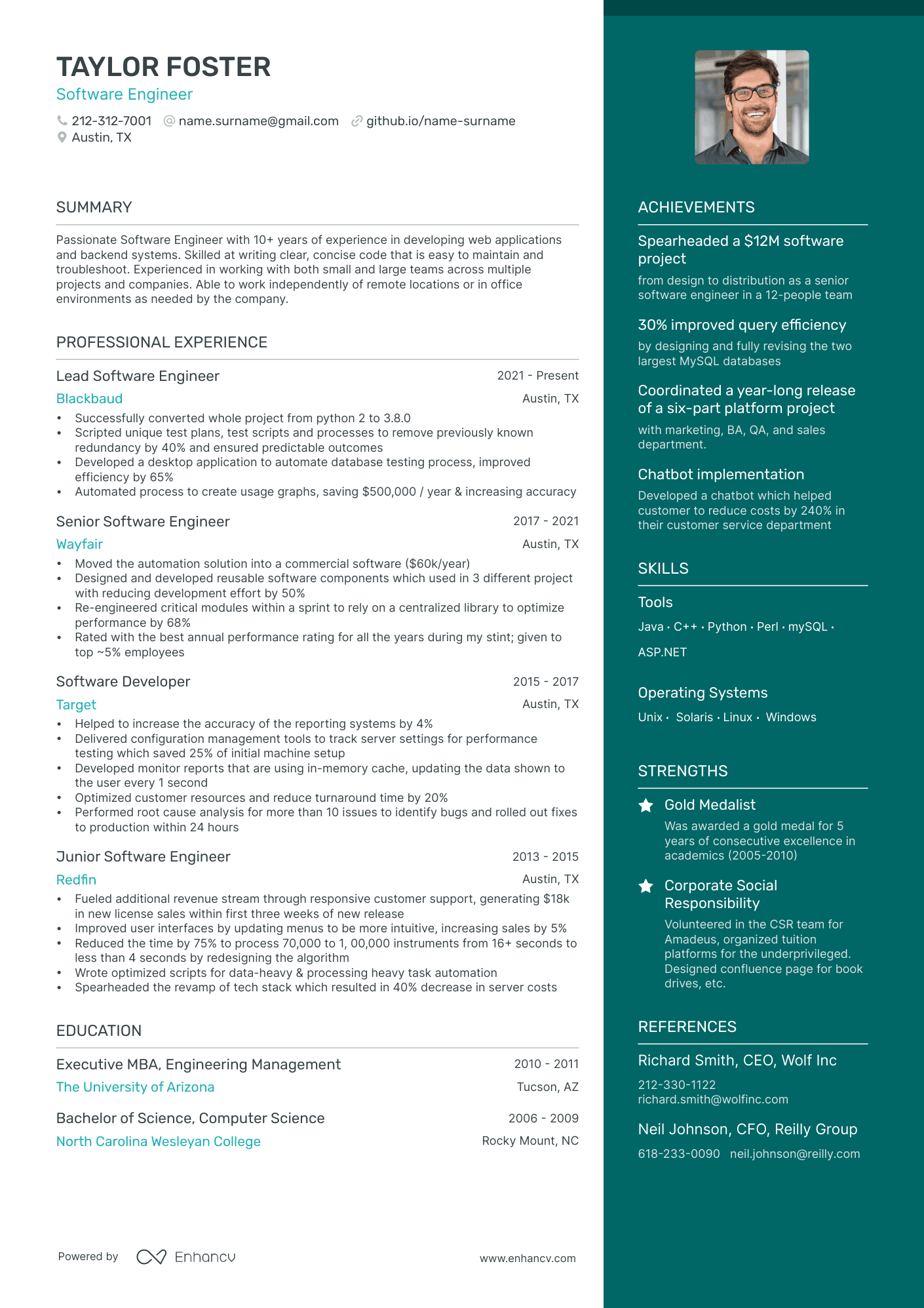
Software Engineer
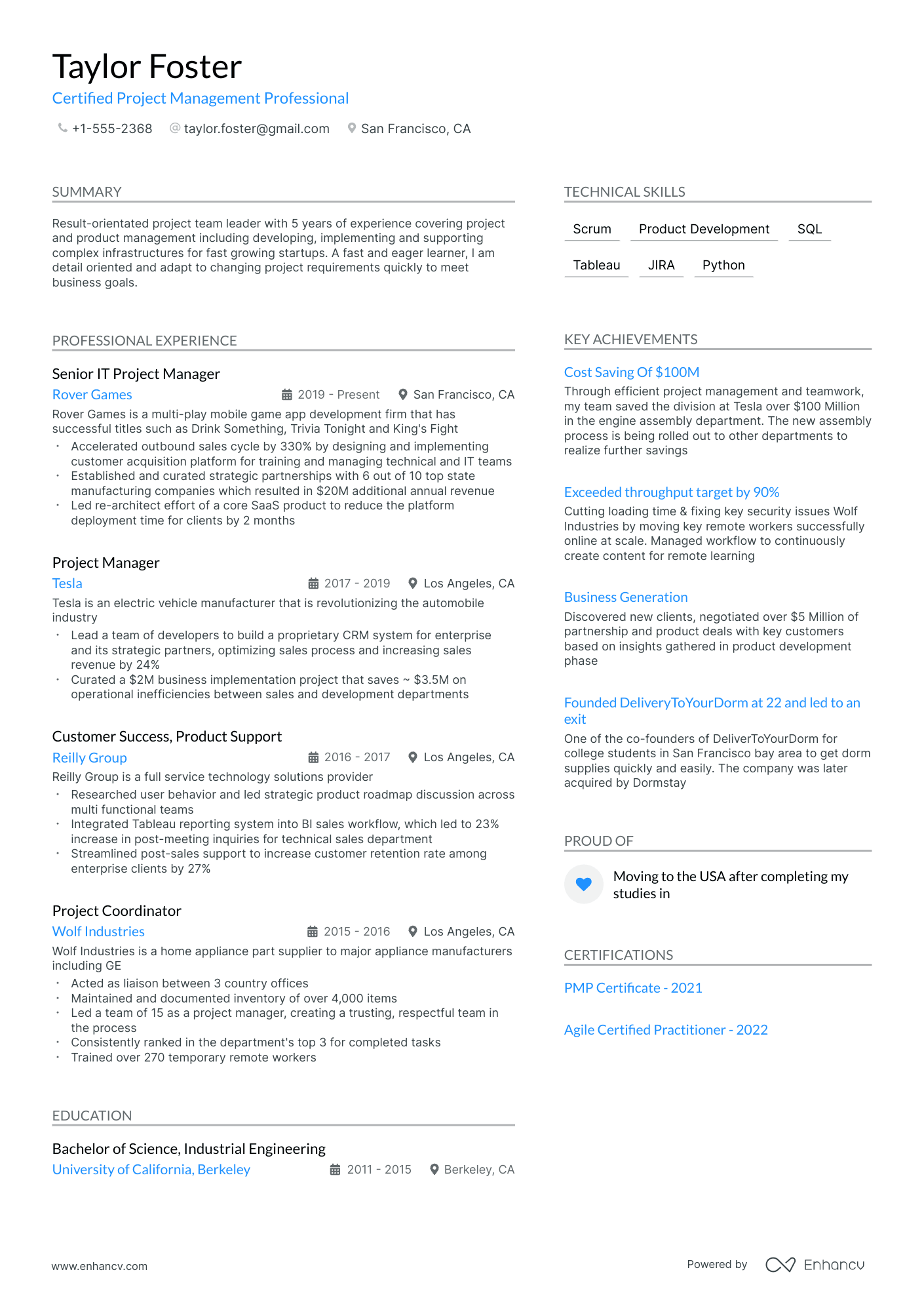
Project Manager

Product Manager

Account Manager
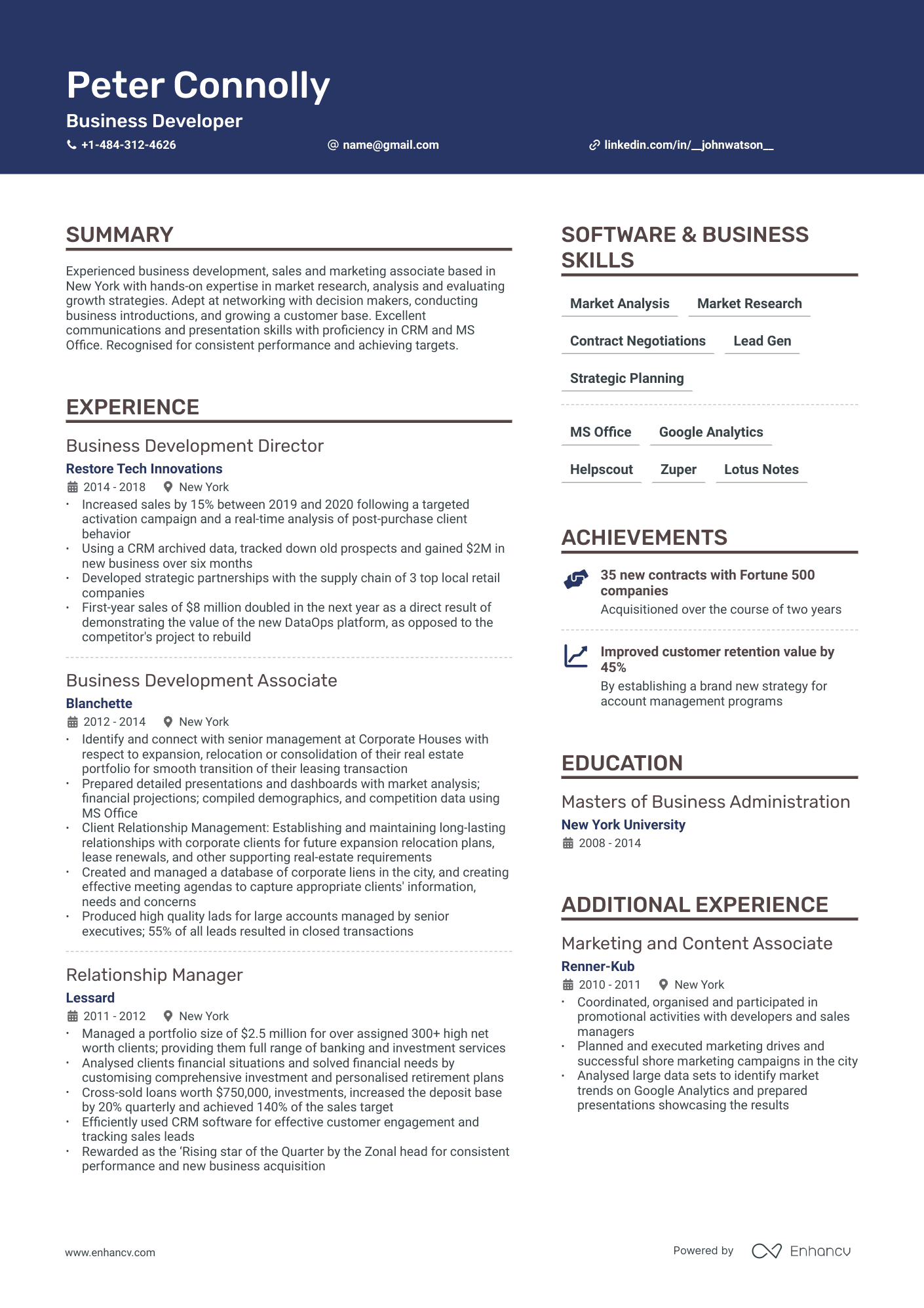
Business Development
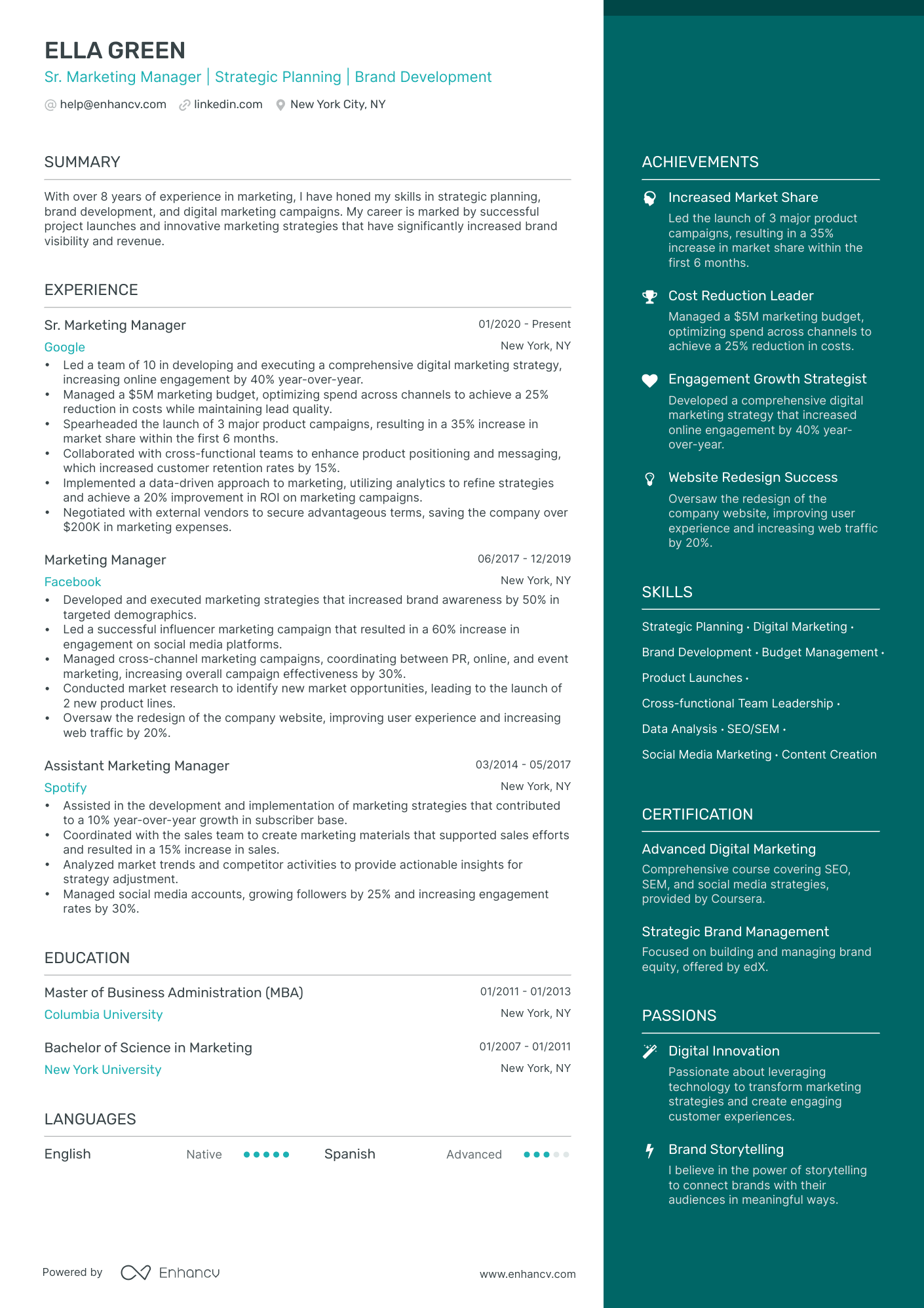
Marketing Manager

General Manager
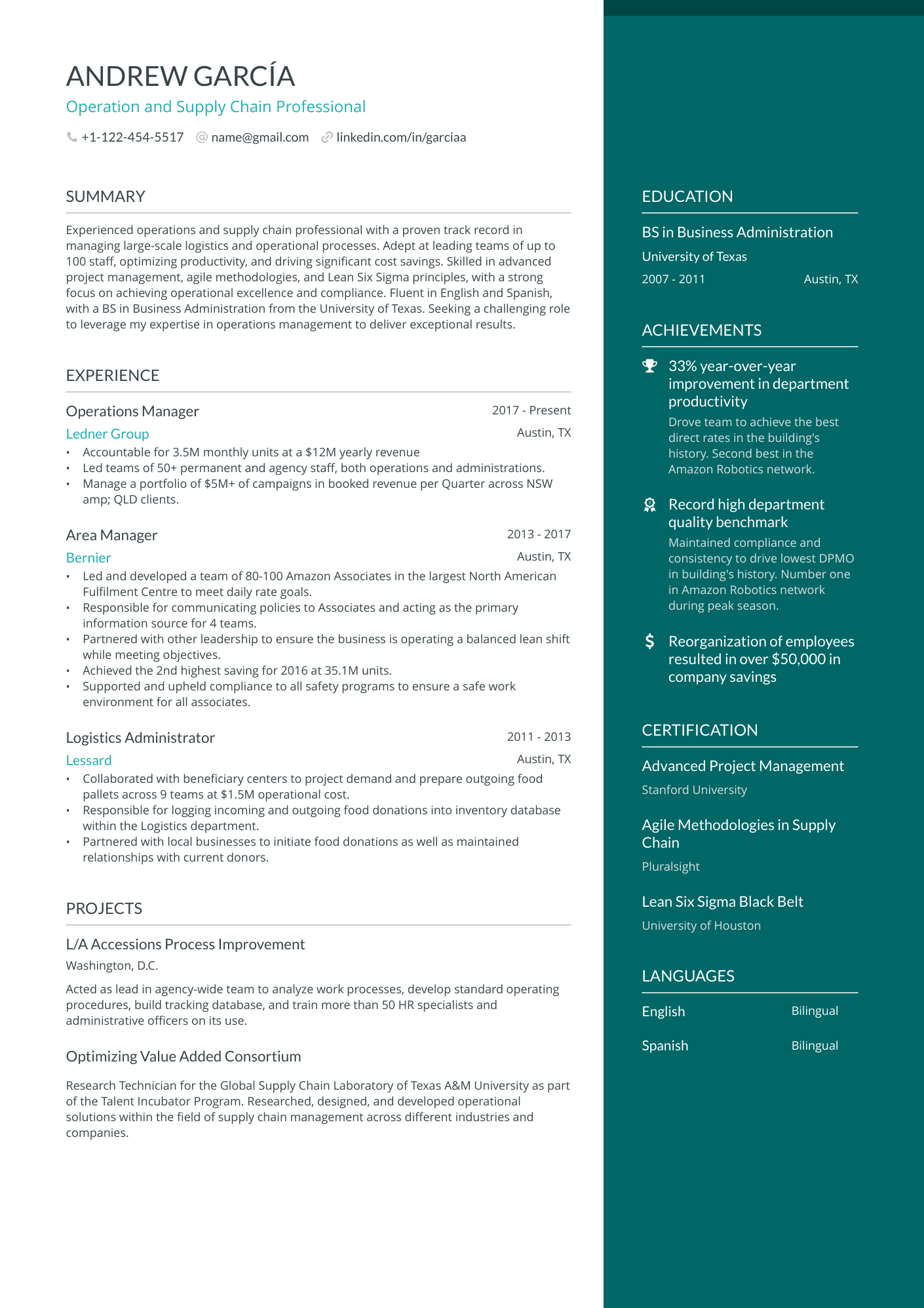
Operations Manager
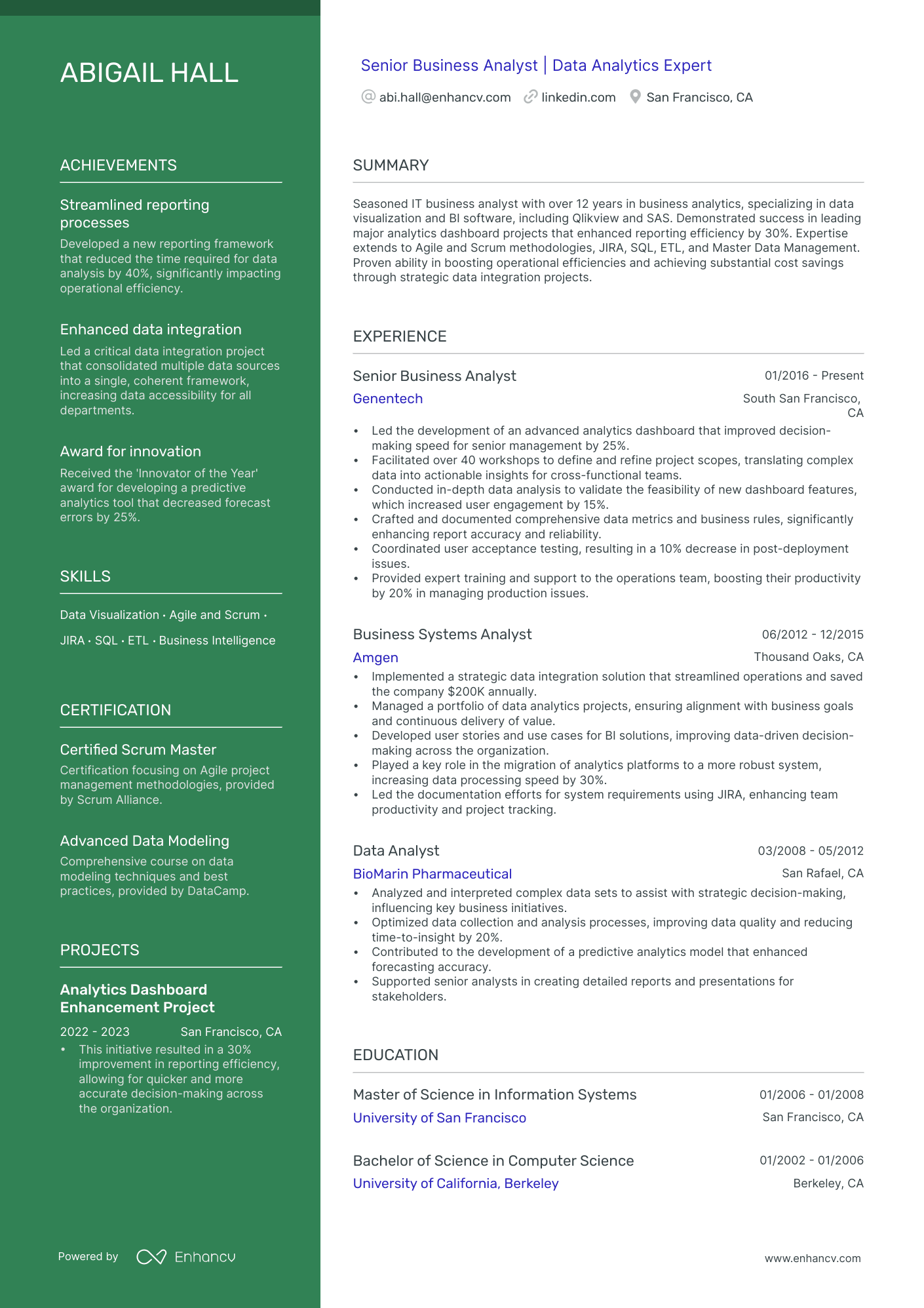
Business Analyst
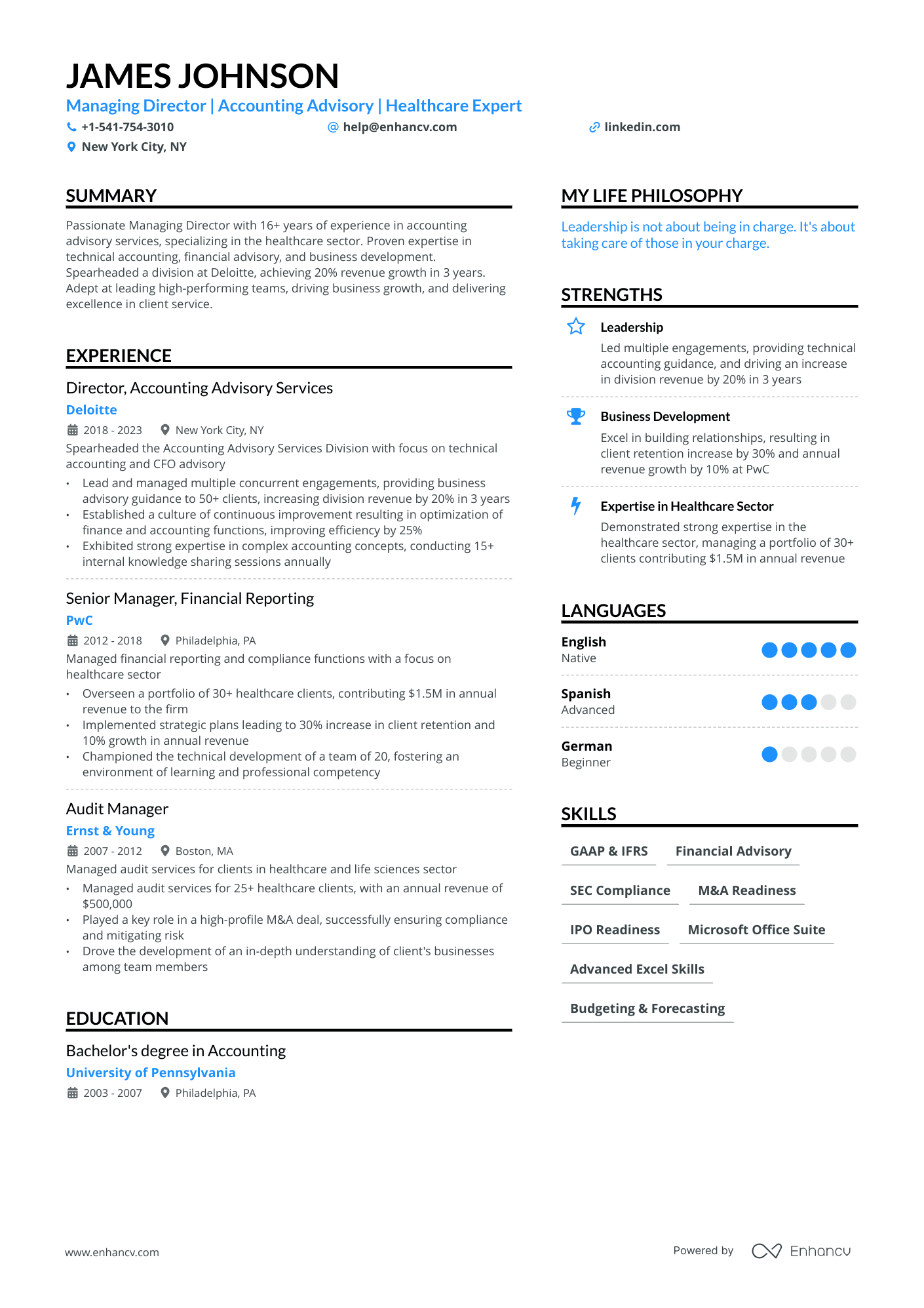
Managing Director
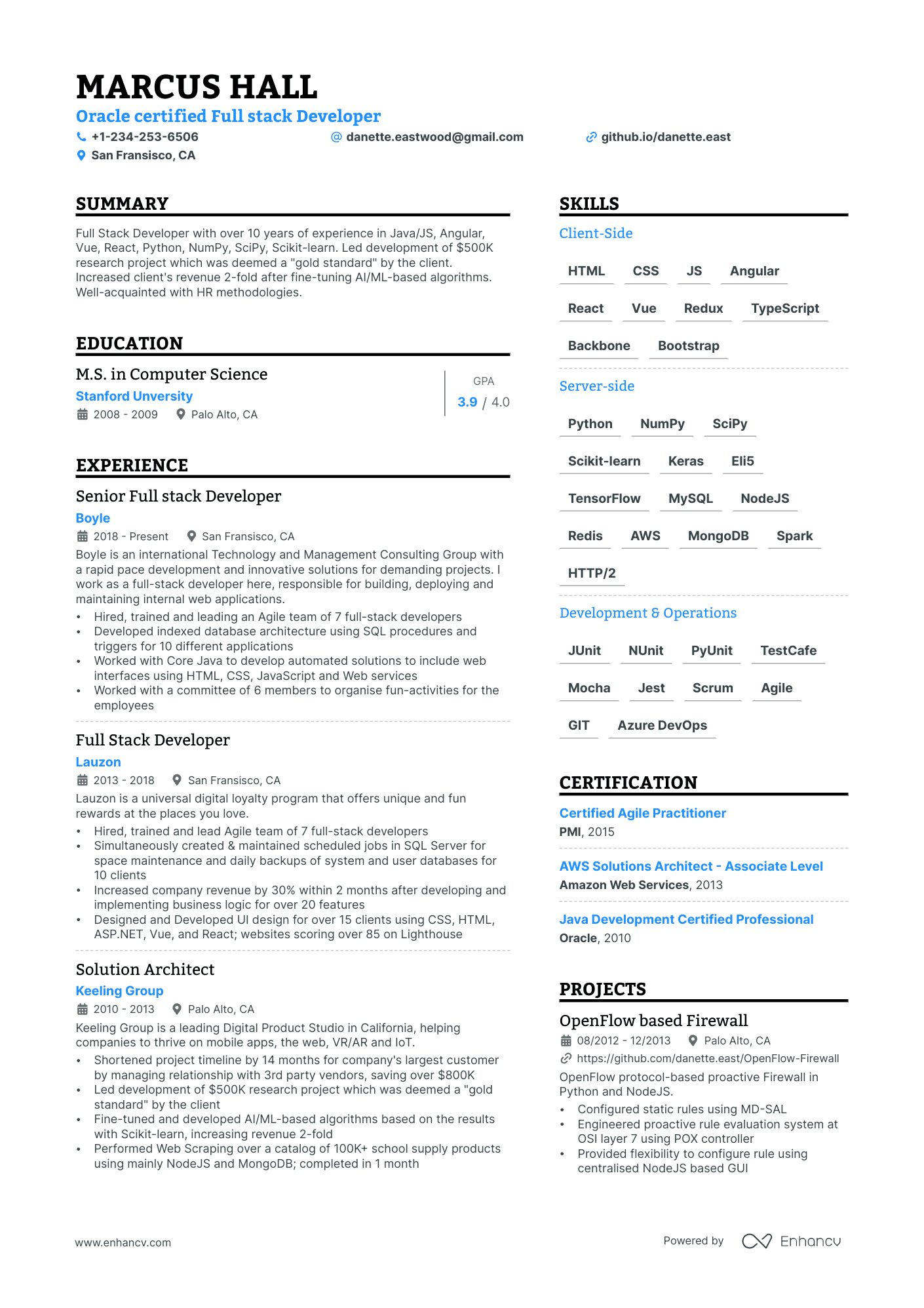
Full-Stack Developer
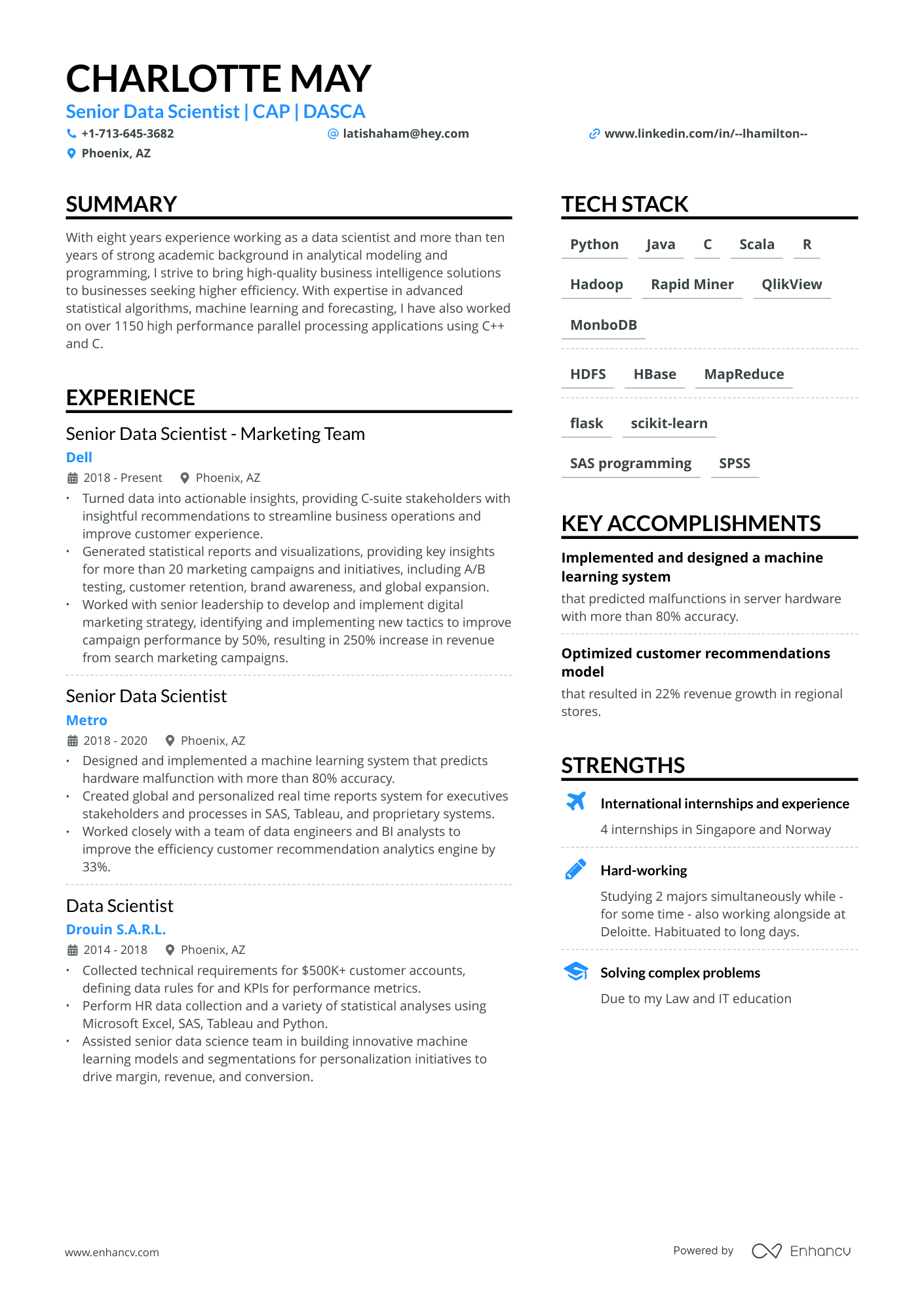
Data Scientist
Resume templates by experience.
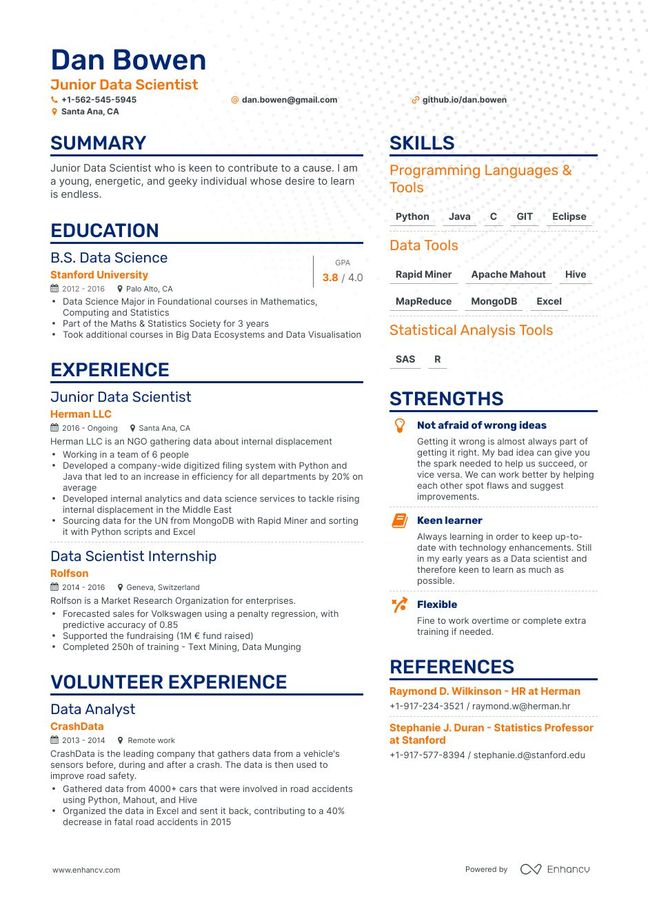
(1-3 years of experience)
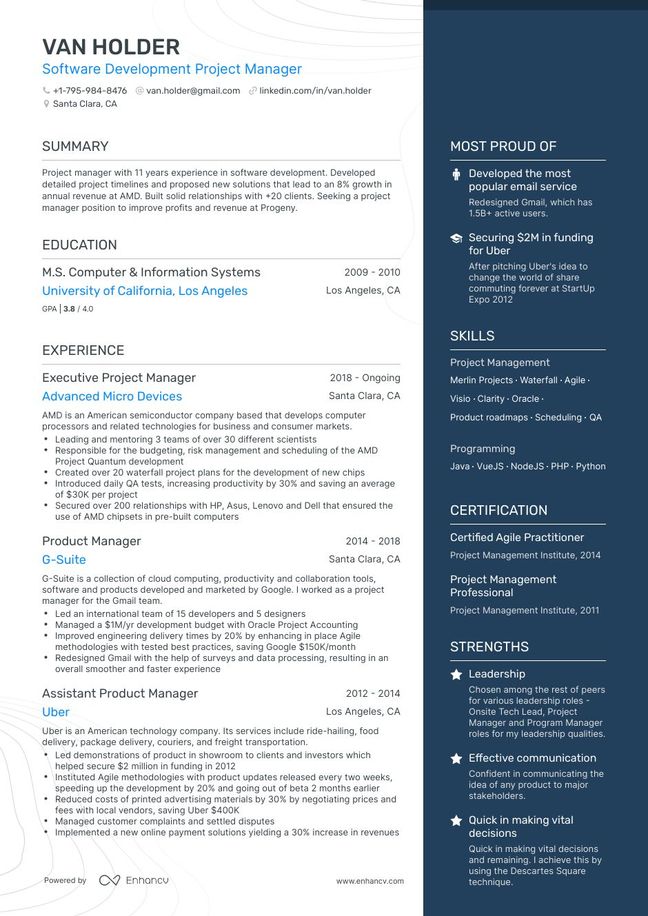
(3-7+ years of experience)
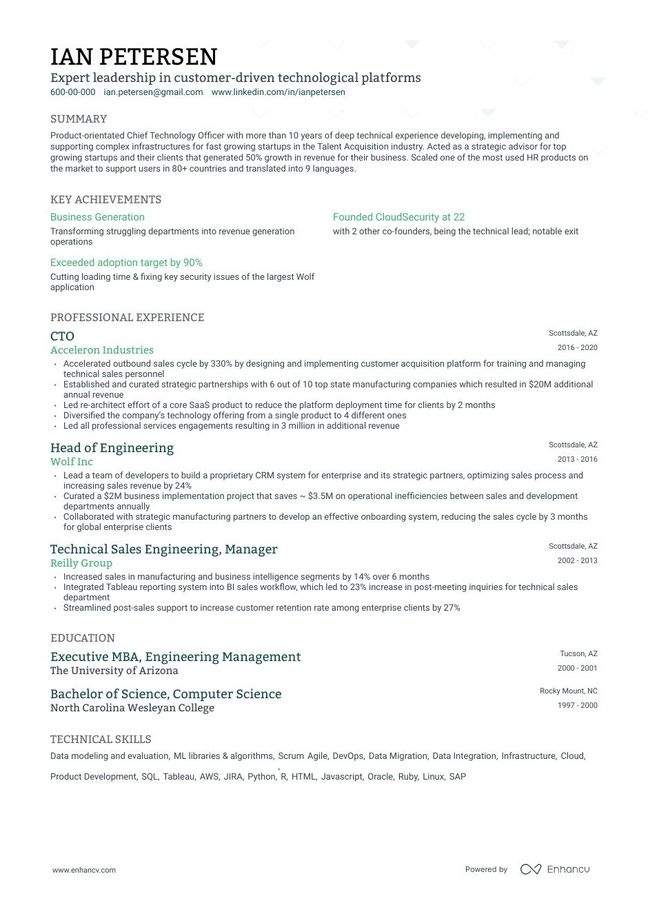
10+ years of experience)
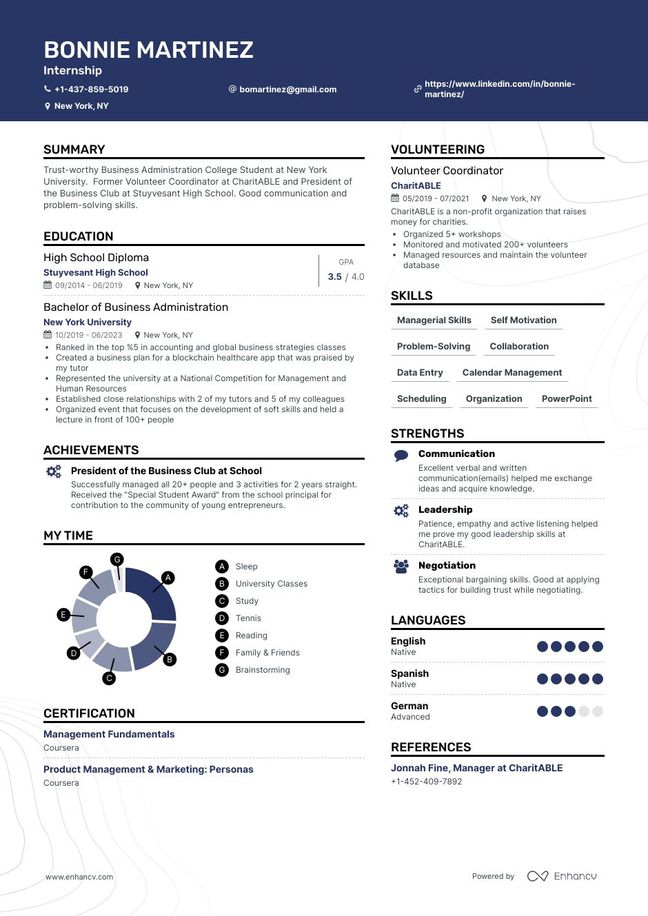
Entry Level
(no prior experience)
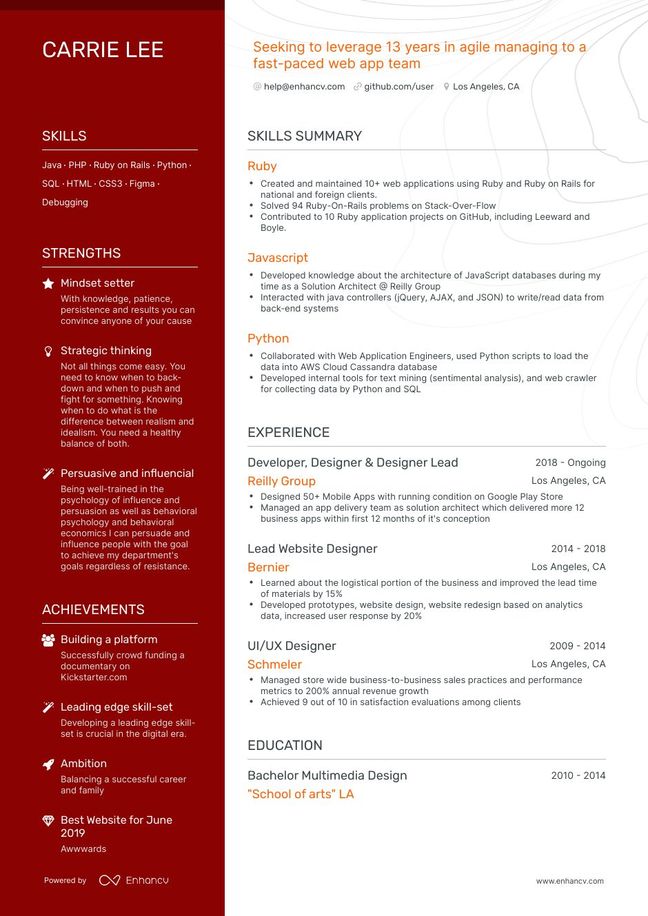
Career Change
Resume templates by format.
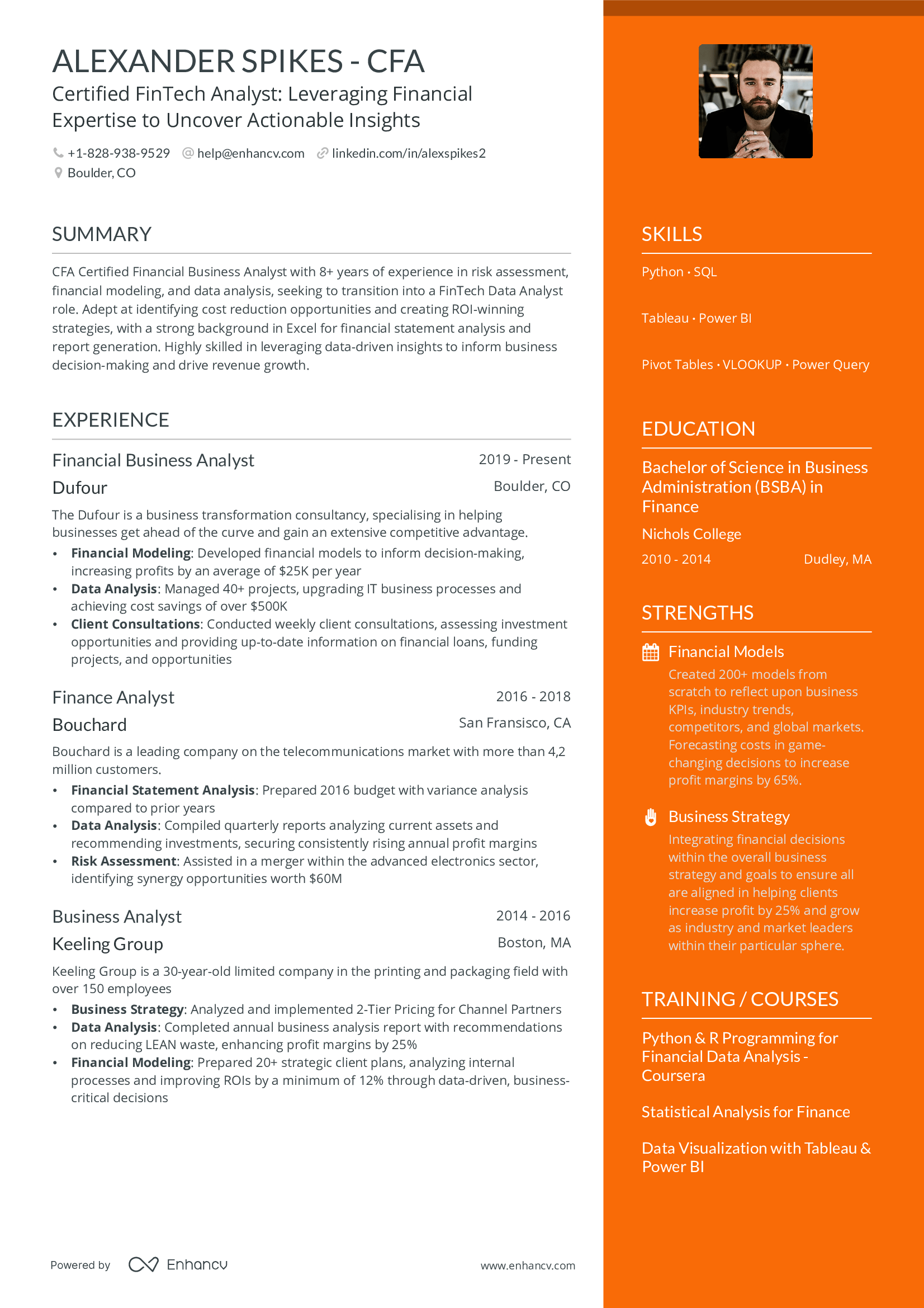
Combination Resume Templates
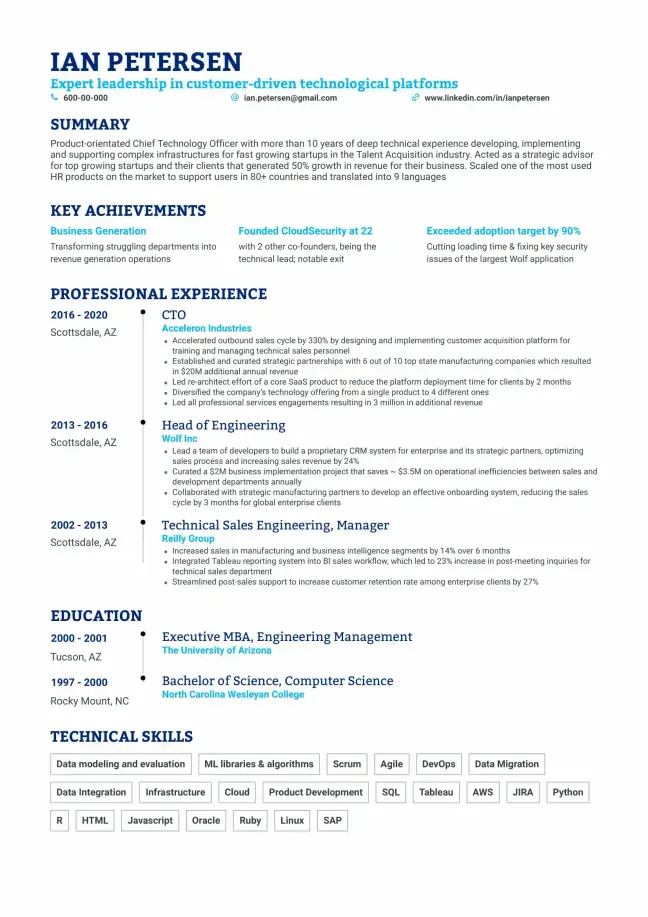
Corporate Resume Templates
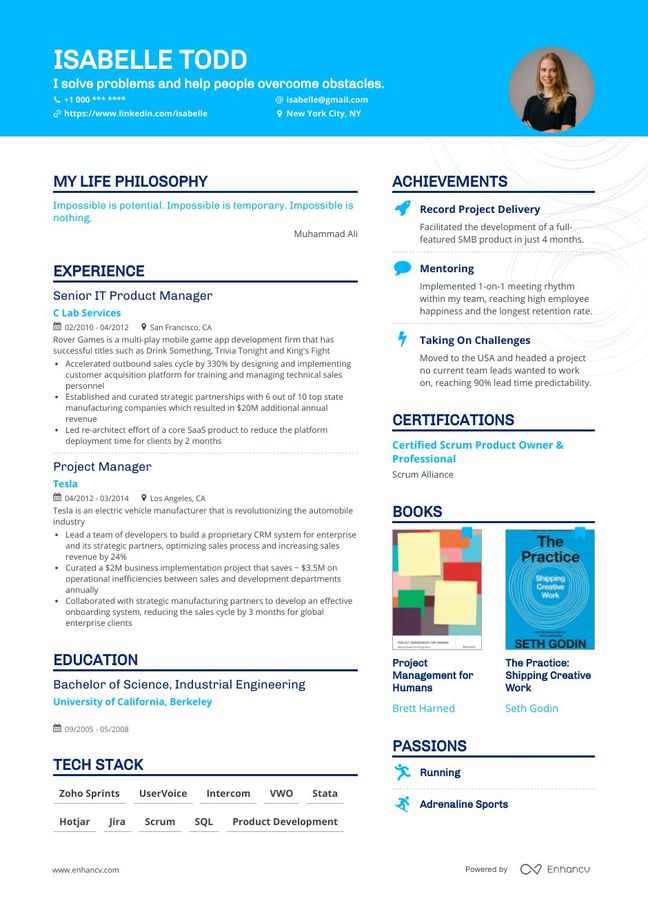
Infographic Resume Templates
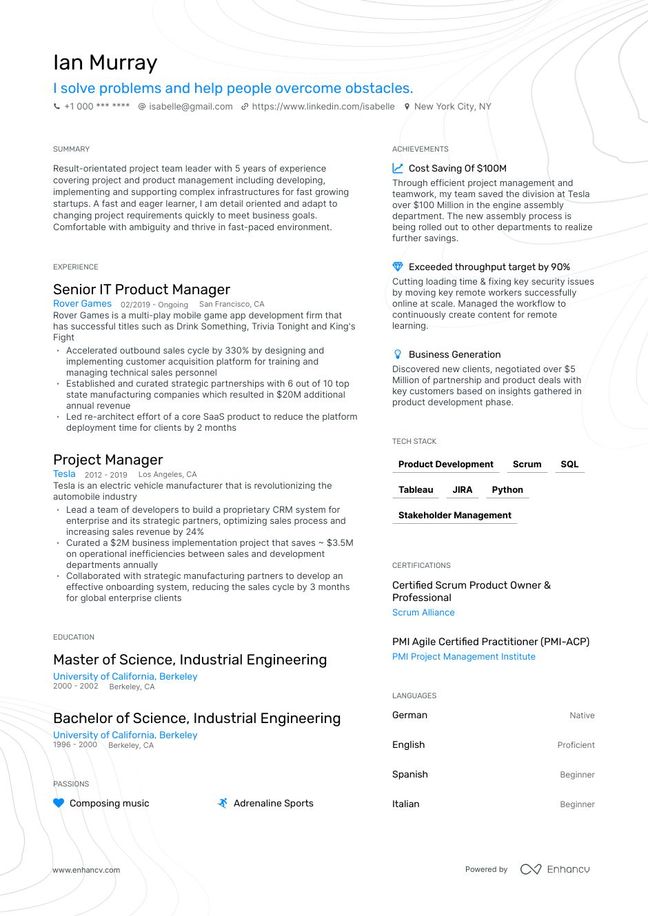
One Page Resume Templates
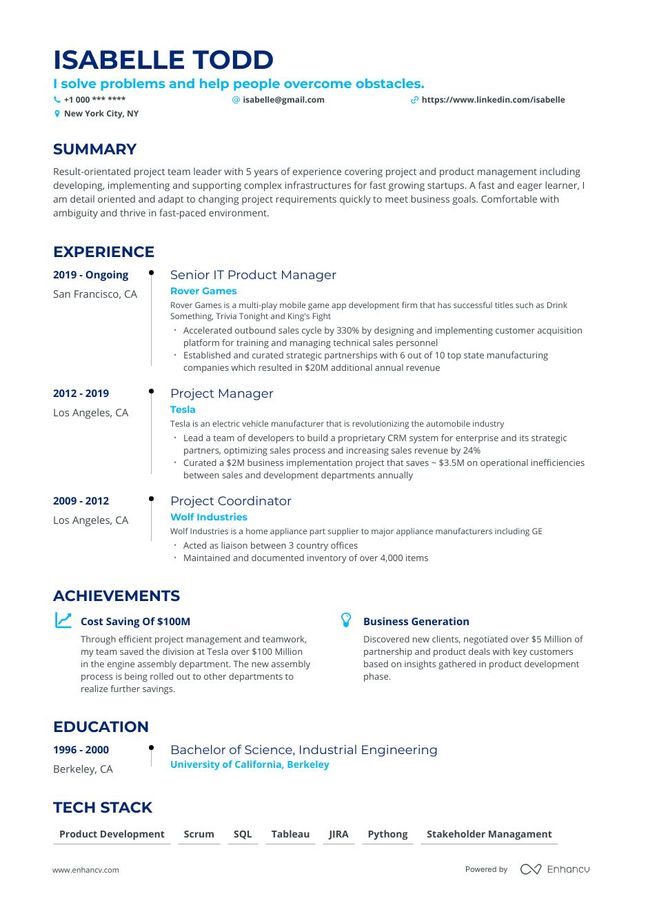
Timeline Resume Templates

Chronological Resume Templates

Functional Resume Templates

Minimalist Resume Templates
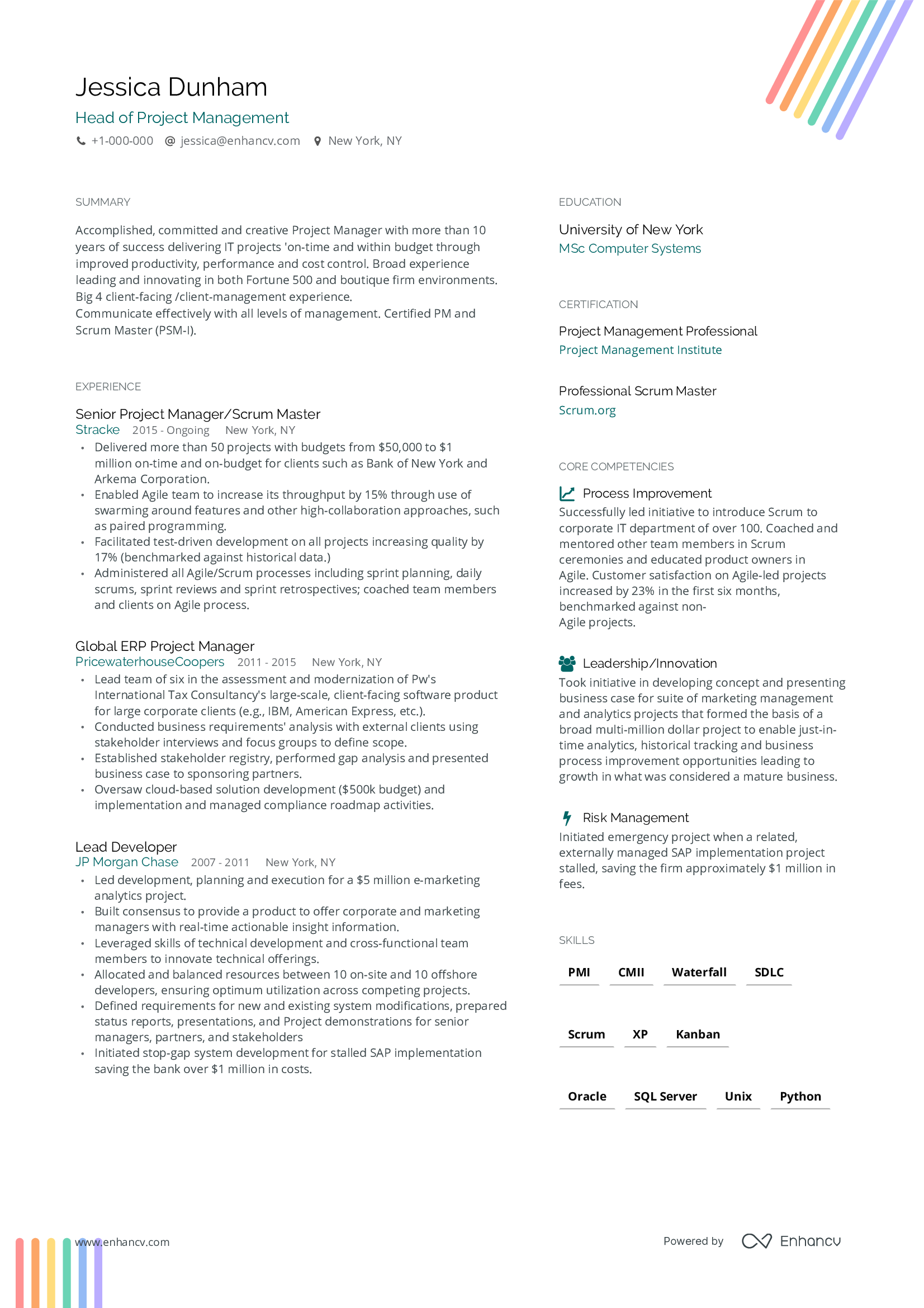
Two Column Resume Templates
- Modern Resume Templates
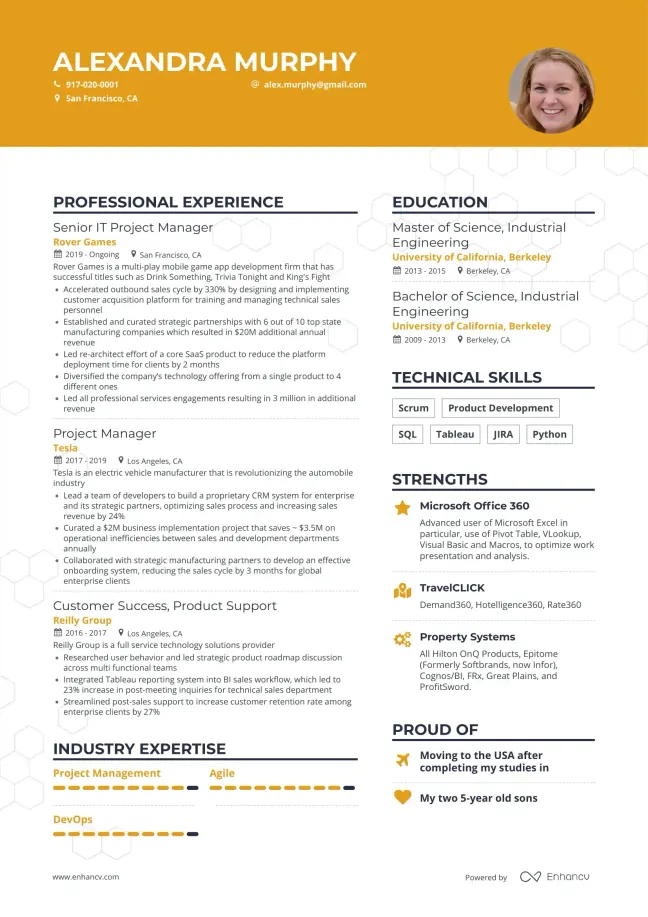
- Simple Resume Templates
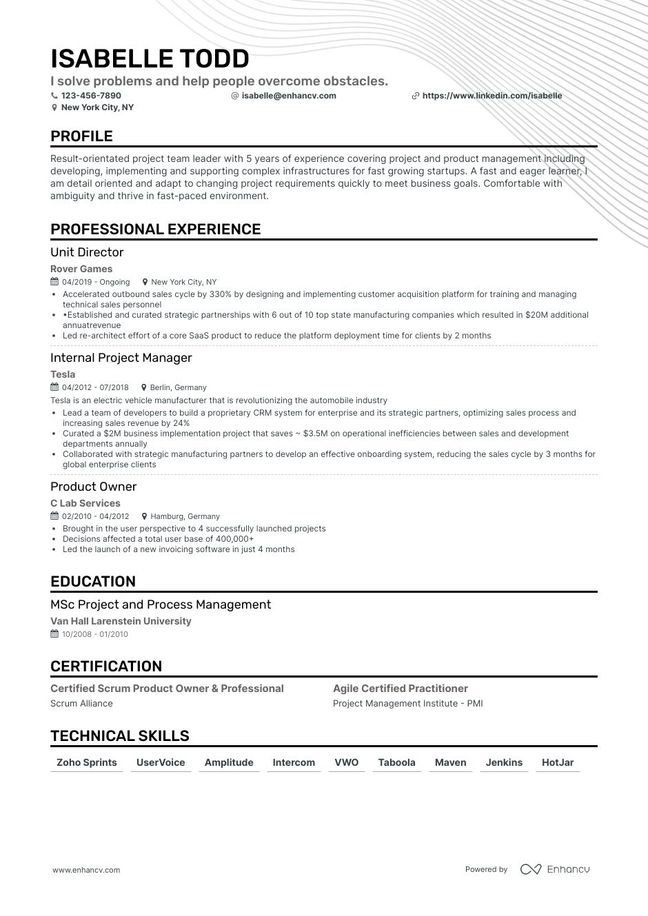
- Create Resume
- Terms of Service
- Privacy Policy
- Cookie Preferences
- Resume Examples
- AI Resume Builder
- Resume Summary Generator
- Resume Formats
- Resume Checker
- Resume Skills
- How to Write a Resume
- Cover Letter Builder
- Cover Letter Examples
- Cover Letter Templates
- Cover Letter Formats
- How to Write a Cover Letter
- Resume Guides
- Cover Letter Guides
- Job Interview Guides
- Job Interview Questions
- Career Resources
- Meet our customers
- Career resources
- English (UK)
- French (FR)
- German (DE)
- Spanish (ES)
- Swedish (SE)
© 2024 . All rights reserved.
Made with love by people who care.
Stack Exchange Network
Stack Exchange network consists of 183 Q&A communities including Stack Overflow , the largest, most trusted online community for developers to learn, share their knowledge, and build their careers.
Q&A for work
Connect and share knowledge within a single location that is structured and easy to search.
How can I properly describe my years of experience on my resume?
I have in total:
- 3 month contract at one employer
- 2 years, 6 months at anther employer ( mobile applications )
In total this is 2 years and 9 months of paid programming experience. It's not exactly 3 years but pretty close. I think saying 2 and 3/4 years is kind of odd.
That also doesn't include the practicum projects I've worked on.
On my resume I've said:
Software Developer with 3 years of experience programming applications in XYZ for mobile devices.
Could this be interpreted as a lie? I hope not. I don't want to come across that way.
How could I describe my experience better?
- professionalism
- software-industry
- hiring-process
- 3 Because it is a lie. Just say 30 months experience But why mention it - let them do the maths – Ed Heal Commented Jul 25, 2015 at 19:18
- 2 If you were a programmer in your freetime before you got hired, writing 3 years of experience is defninitely not a lie. Writing "about three years of experience" is probably the best way tho. – Mafii Commented Sep 18, 2017 at 9:22
2 Answers 2
Don't complicate your life: two years and nine months round up to three years, so you're not lying. What you did during those 2 years and 9 months are far more important and relevant to a prospective employer.
It's going to take at least several weeks at the earliest before you get another job, throw in a couple of weeks for your resignation notice and before you know it, you'll be so close to the actual 3 calendar years it's not going to be funny (to you).
I wouldn't sweat the 3 months you spend working for that other employer. For one thing, you may have learned some skills during those 3 months that are transferable to mobile programming. For another thing, given what we know about you through your multiple posts, you probably pulled in enough overtime in the 2 years and 6 months you spent working for your second employer to make it effectively 2 years and 9 months' worth of mobile programming. Make sure to say in your job description for your second employer that you put in say 50 hours a week.
On my resume I've said: "Software Developer with 3 years of experience programming applications in XYZ for mobile devices." Could this be interpreted as a lie? I hope not. I don't want to come across that way. How could I describe my experience better?
I suppose it could be interpreted as a lie, since you don't actually have 3 years of experience quite yet. I don't think most hiring managers would worry about it, but a few might.
To be sure, I'd probably prefer something like this for now: "Software Developer with nearly 3 years of experience programming applications in XYZ for mobile devices."
In a few months you can truthfully change it to: "Software Developer with over 3 years of experience programming applications in XYZ for mobile devices."
You must log in to answer this question.
Not the answer you're looking for browse other questions tagged professionalism resume software-industry hiring-process ..
- Featured on Meta
- Introducing an accessibility dashboard and some upcoming changes to display...
- We've made changes to our Terms of Service & Privacy Policy - July 2024
- Announcing a change to the data-dump process
Hot Network Questions
- A projectivity property in the category of groups
- A convergent, but large, sum of integer reciprocals
- Coupon Collector vs. Geometric Distribution: Catching All 150 Pokémon
- How to measure out fresh herbs when the recipe calls for 'a tablespoon of chopped herb'?
- Hard links on CIFS network mount (ext4) silently falls back to copy operation
- How could ocean liners survive in a major capacity after large jet airliners become common?
- Do hiveminds need an economy?
- Why is my single speed bike incredibly hard to pedal
- What is so special about JUICE's flyby with Earth and Moon?
- What purpose did the lower-right "Enter" key serve on the original Mac 128k keyboard?
- What's the difference between "Model detail" and "Texture detail" in Portal 1?
- Is it OK to call a person "sempai" who is actually much younger than you?
- The average of an infinite sequence
- Why would sperm cells derived from women's stem cells always produce female children?
- Why is “water takes the steepest path downhill” a common approximation?
- What role can scrum master have/take when product owners differ from opinion?
- Who checks and balances SCOTUS?
- Four Year Old Pushing and Positive Discipline Techniques
- Make a GCSE student's error work
- Does the volume of air in an air tight container affect food shelf life?
- How to proceed if my manager is ghosting me?
- How does one find historic prices for goods?
- A spaceship travelling at speed of light
- Confused with "per āera" in "Familia Romana"
How To Write a Resume Profile in Five Steps

Profiles vs. Objective Statements
The five steps to a profile, tying it all together, frequently asked questions about writing a resume profile.
The resume profile (or summary) describes your main credentials for your target job. Appearing at the top of the resume, it’s the first section hiring managers read and strongly influences whether they call you for an interview .
You may feel lost when developing your profile, especially if you’re just starting your resume. But it’s best to work on the profile after you’ve already drafted your professional experience, education, training, and other relevant areas. Then, you can develop your profile with a broader understanding of your career so far.
For a long time, the standard resume intro was an objective statement that would appear above or in place of the profile. Rather than describing an applicant’s key qualifications, the objective would state their end goal for their job search. An example is “Seeking a sales role where I can work on building win-win relationships with clients.” In recent years, the objective has fallen out of favor since it speaks to the job seeker’s needs rather than the hiring manager’s. So avoid using an objective and instead begin your resume with a profile summary of what you offer.
When you’re ready to start your profile, follow these steps:
Step 1. Write a simple statement of your job title and years of experience
For example, say you’re a sales manager who has risen through the ranks over 10 years. Start your profile with a line like:
Resourceful sales manager with over 10 years of advancement and experience.
But if you’re changing careers, use a more general intro statement that still relates to your goals and reflects your background. For instance, say you’d like to stay in sales but no longer in a leadership capacity. Use a broader line like “Resourceful sales professional with over 10 years of experience” to position yourself for the switch back to direct sales.
Step 2. Pinpoint and develop a common theme
Look over all your other resume sections and select three to five details that strike you as especially impressive or relevant. Then, review them all together. Does a common work theme or strength emerge? Write one or two profile sentences on that theme. For instance, if your highlights point to your expertise in engaging and collaborating with clients, that’s a great area to write about further.

Step 3. Avoid clichés by way of action verbs
At this stage, you may run into the problem of profile clichés. For instance (continuing the above example), you might describe your collaborative streak as “Excellent communication and collaboration skills.” But terms like this are overused and won’t add much value to your profile.
To avoid clichés and liven up your profile language, use complete sentences with action verbs. Think about what you actually do at work – the actions (or verbs) you take to generate results. This approach can turn a static word like “collaboration” into a specific, verb-powered phrase like “Collaborate with clients to find win-win product solutions.”
Step 4. Cite a specific achievement
If one or more of your highlights is a quantified achievement from your work history, you can repeat it in your profile to make the description more compelling and specific to you. Say one of your highlights is “Surpassed quota by 10% in 2013, 18% in 2014, 20% in 2015, and 22% in 2016 and 2017.” Consider adapting it to your profile with a phrase like “Achievements include surpassing quota by over 18% on average for five consecutive years.”
Putting together the steps so far, we have the basis for a strong profile:
Resourceful sales professional with over 10 years of experience. Collaborate with clients to find win-win product solutions, driving consistent revenue and profit growth. Achievements include surpassing quota by over 18% on average for five consecutive years.
Step 5. Plug in other key credentials
You can then round out your profile with one or two more statements on your other top qualifications. If one of your other highlights is an advanced degree or certification, that can give your summary a strong outro. Also, note that foreign language ability is often viewed as a key asset by employers, so if you have it, feature it in your profile.
After following these five steps, you should have a viable resume profile of your own, something on par with this finished example:
Resourceful sales professional with over 10 years of experience. Collaborate with clients to find win-win product solutions, driving consistent revenue and profit growth. Achievements include surpassing quota by over 18% on average for five consecutive years. Offer well-rounded business acumen and expertise, drawing on a recently finished MBA degree. Bilingual: fluent in English and French.
But then consider: Are you missing anything important? Have you left out a work highlight or skill area that’s key to your next job? If yes, add a sentence or two on those missing areas and take heart that you’re gaining an ear for the type of information a winning profile calls for.
Do I need a profile summary on my resume? -
Yes. Virtually any job seeker can improve their resume by adding a profile. A strong profile section catches a hiring manager’s attention by giving the key reasons you’ll thrive at their organization. In seconds, it assures the reader that you’re a strong candidate whose application is worth a closer look.
How long should my profile be? -
Many resume experts give strict parameters for profile length; three or four lines of text is the standard order. But profiles are more flexible than that. Don’t worry if your own profile comes in shorter or longer, given you’ve followed this process. And never add fancy language to your summary for its own sake.
What experience areas should I cite in my profile? -
Any, as long as they help present you as a strong candidate for your target job. Most job seekers will derive at least some profile content from their work experience. But you could also use details from your education, volunteer experience, or any other section of your resume.
Craft your perfect resume in minutes
Get 2x more interviews with Resume Builder. Access Pro Plan features for a limited time!

Jacob Meade
Certified Professional Resume Writer (CPRW, ACRW)
Jacob Meade is a resume writer and editor with nearly a decade of experience. His writing method centers on understanding and then expressing each person’s unique work history and strengths toward their career goal. Jacob has enjoyed working with jobseekers of all ages and career levels, finding that a clear and focused resume can help people from any walk of life. He is an Academy Certified Resume Writer (ACRW) with the Resume Writing Academy, and a Certified Professional Resume Writer (CPRW) with the Professional Association of Resume Writers & Career Coaches.

Build a Resume to Enhance Your Career
- How to Land Your Dream Job Learn More
- How to Organize Your Job Search Learn More
- How to Include References in Your Job Search Learn More
- The Best Questions to Ask in a Job Interview Learn More
Essential Guides for Your Job Search
- How to Build a Good Resume for Graduate School Learn More
- How to Build a Resume Learn More
- How to List a Degree on a Resume Learn More
- How to Include Personal and Academic Projects on Your Resume Learn More

All Formats
- Graphic Design
35+ Experienced Resume Format Templates – PDF, DOC
Did you know that sample resumes also keep up with the trend? As much as how important it is to keep our services resumes updated, it is also important that we comply with the styles of standard, industry-accepted resume formats that are preferred by hiring managers. And a candidate who has experienced at least one job interview, you know full well how resumes play a big part in landing a job. It is of utmost importance that we keep our professional resume updated, as it serves beneficial to us in the long run, especially when we decide to look for a better-compensating job or perhaps you found a company that just suits you best. And so, we’re providing resume samples to any beginner fresher, or a seasoned professional in finance, MBA, technical training, and more. Whether you’re a person with 1 year, 2 year, 3 year, 5 years, or 10 years of work experience, you’ll find templates perfect for composing your resume or CV templates .
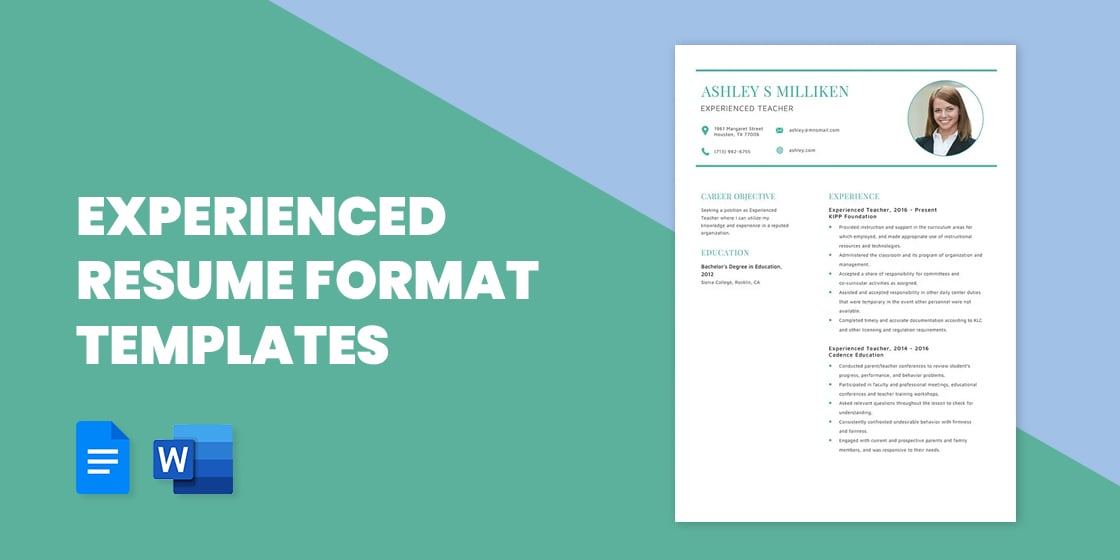
Standard Experienced Teacher Resume Template

Experienced Mechanical Engineer Resume Template
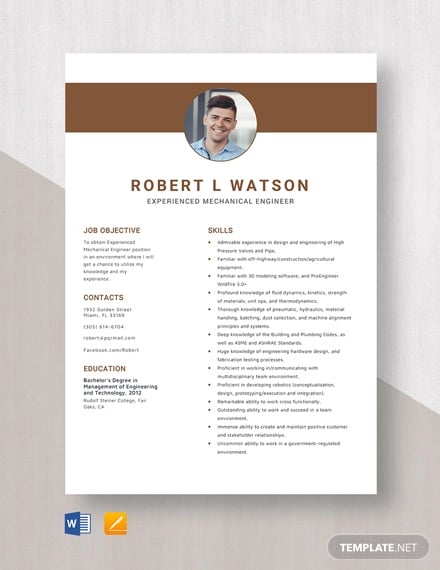
Customer Experience Associate Resume Template
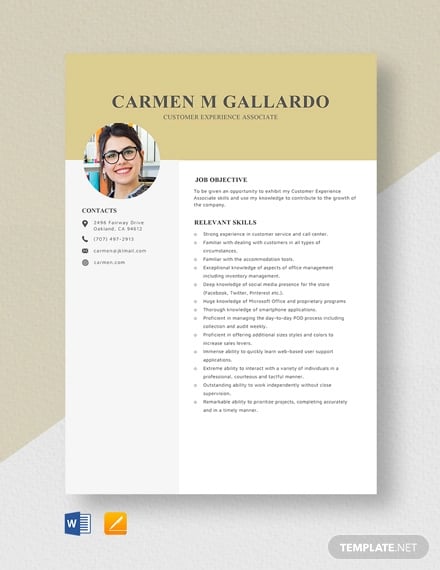
So You’re Writing a Resume . . .
Customer experience manager resume template.
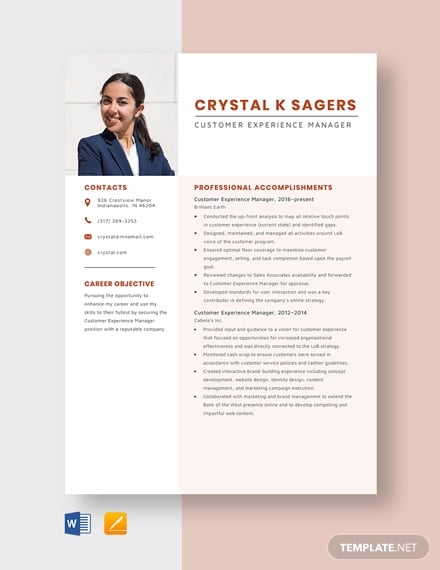
Experienced Senior Accountant Resume Template
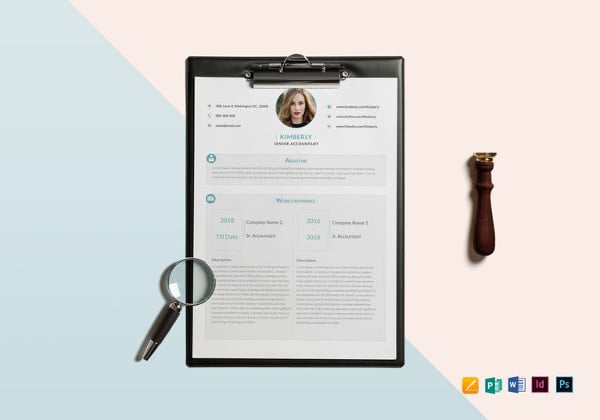
Experienced Chef Resume Template
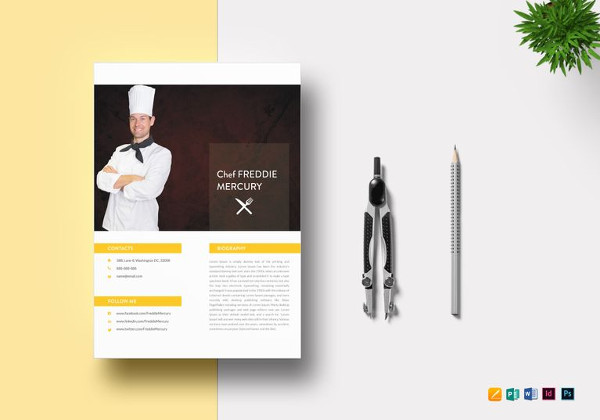
Free Experience Resume / CV Template
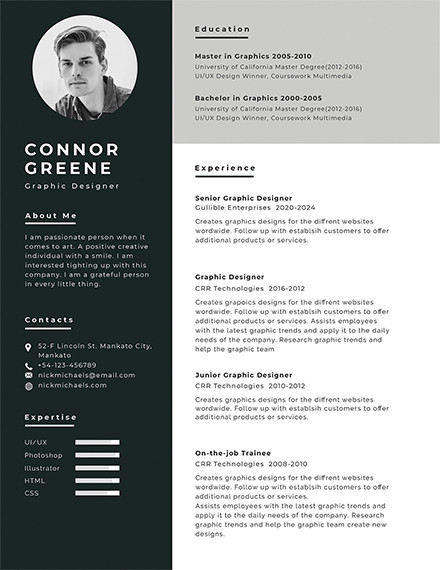
- Apple Pages
Free One Page Resume for Experienced
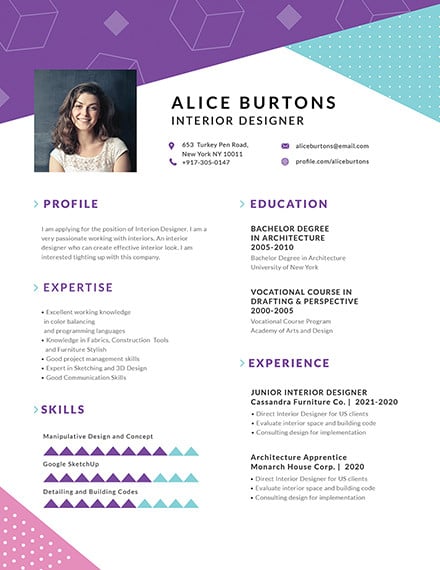
IT Professional Experience Resume

Experienced Accountant Resume Template
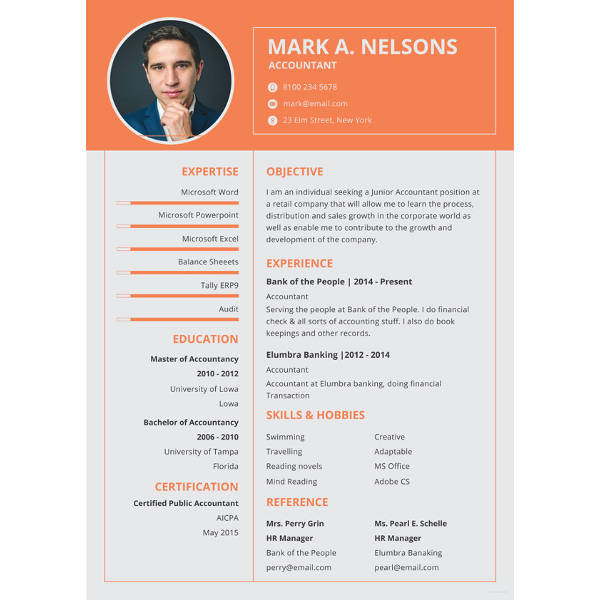
- Adobe Illustrator
Experienced HR Coordinator Resume Template
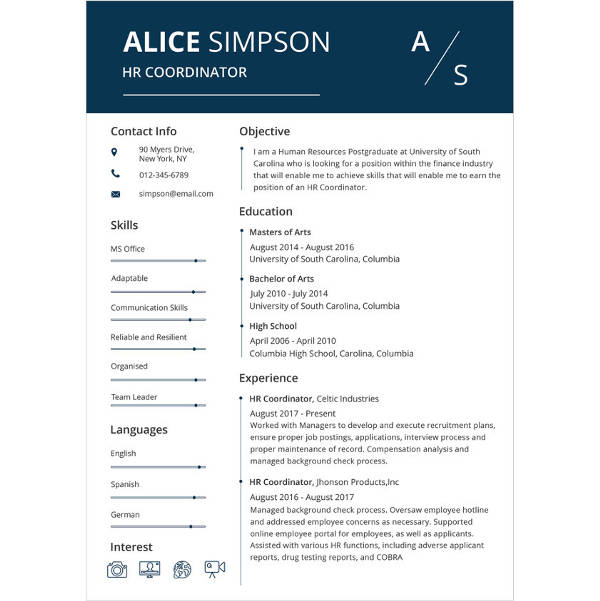
- Microsoft Word
- Microsoft Publisher
- Adobe InDesign
Technician Work Experience Resume Template
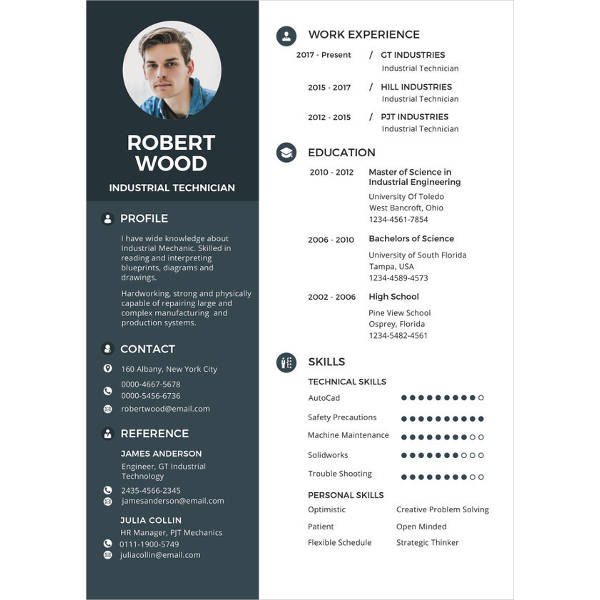
Senior Accountant Experience Resume Template
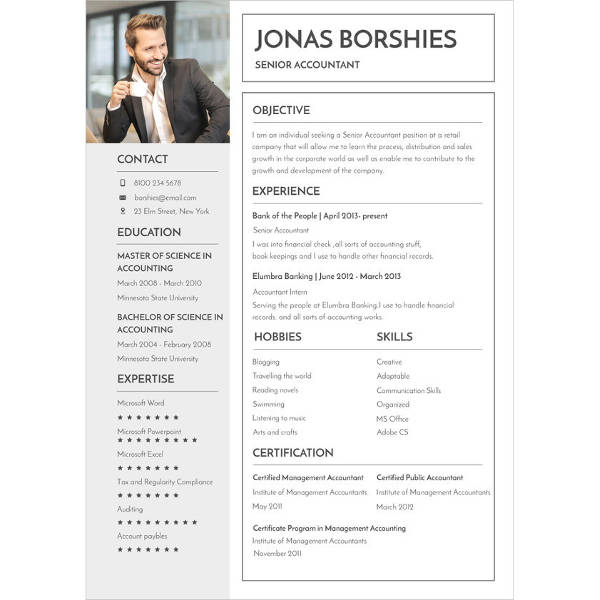
Simple Receptionist Experience Resume Template
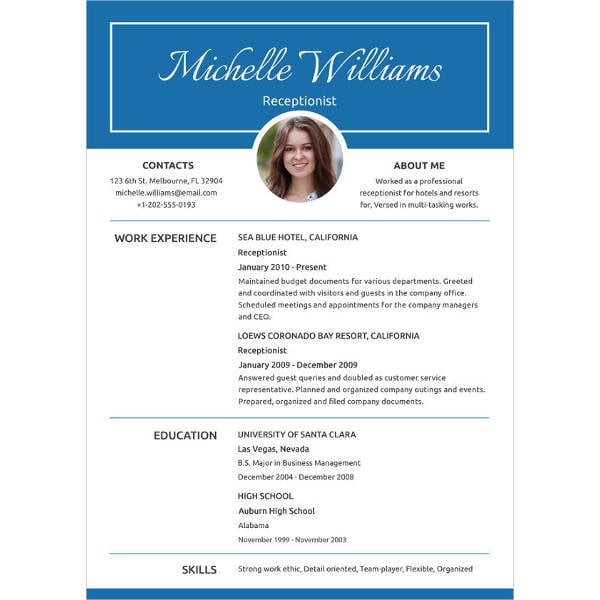
- Adobe Photoshop
Banking Resume for Experienced Template
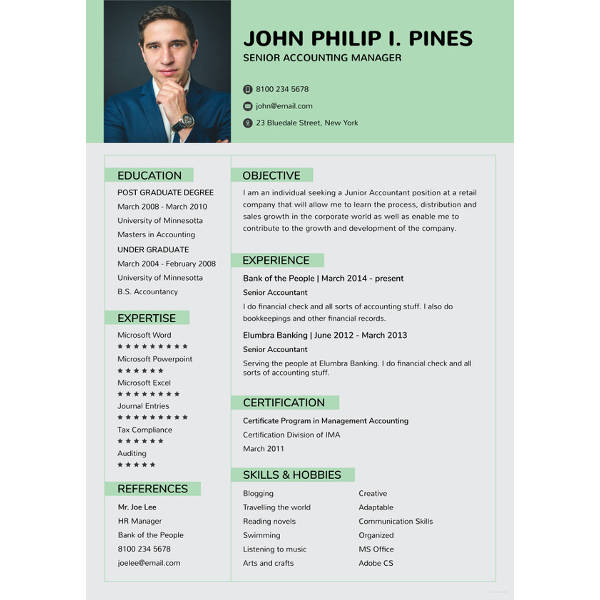
3 Years Experienced HR Resume Format Template
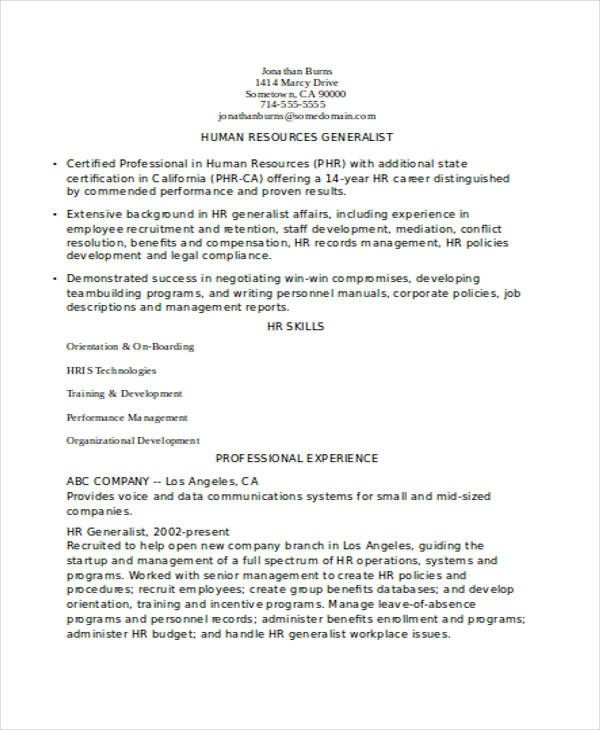
Experienced Technical Engineering Resume Format
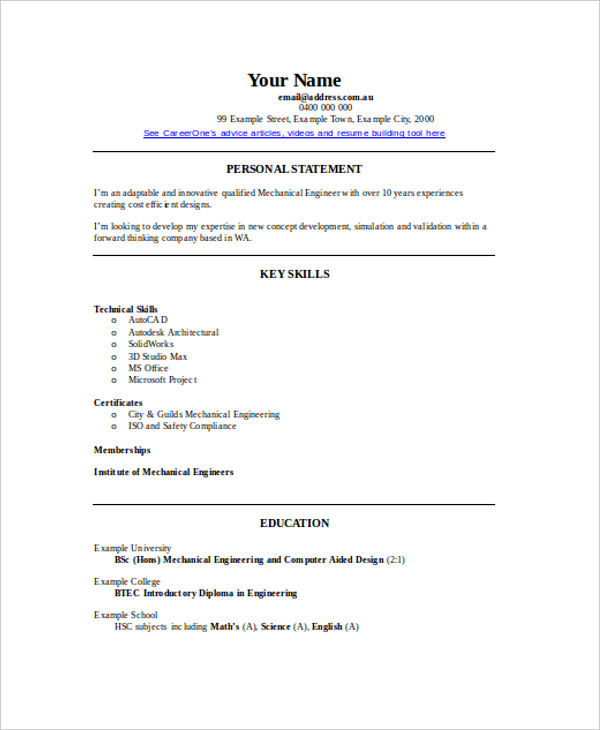
MBA Finance Experienced Resume Format
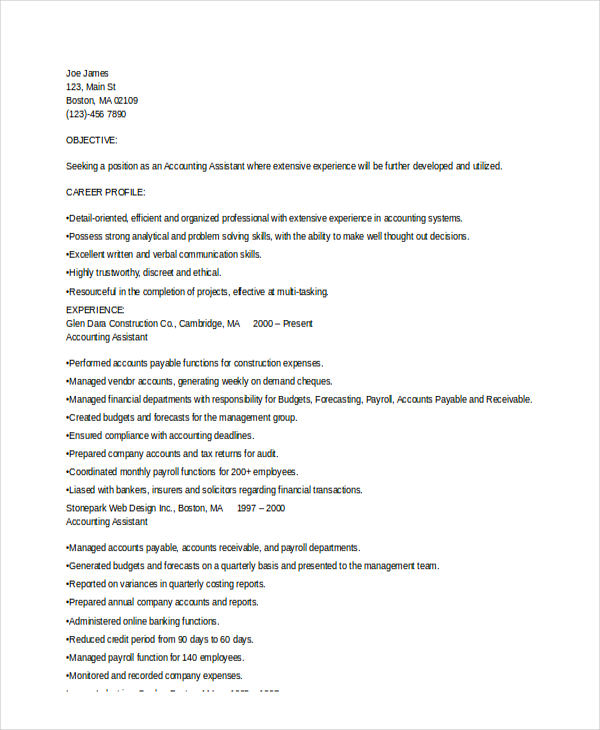
Working Experience
- Objective. The objective is a small space where you can write an overall sheet summary of your experiences, skills, achievements, and smart goals. As you gain more experience, your skills and achievements gain too.
- Working history. Having a concise and neat sample list of your working history until the most recent is essential. It allows your potential employer to see a working progression.
- Achievements. This one’s pretty simple. The more experience you gain, the higher your chances of achieving something new that comes along with it. If you have any new achievements gained and are relevant to the new role you are applying for, it is just as essential that you add them to your beginner resume.
- Skills and strengths. Working in a company for a certain period is just as natural as you learning new skills and testing your limits. If you can learn any and have proven to yourself that you’ve gained new strengths, then it is wise that you also add them to your custom resume .
Professional Experienced Candidate Resume Format

Marketing Person Experienced Resume in Word
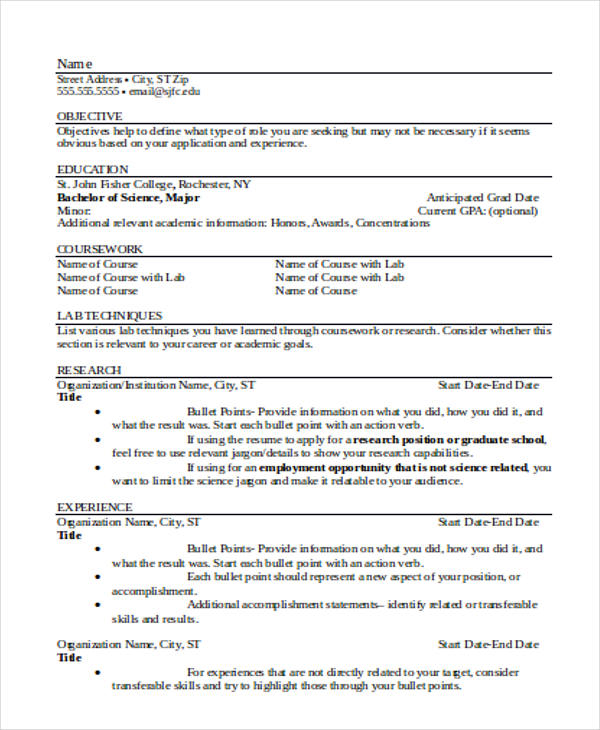
5 Years Experienced Resume for Software Developer
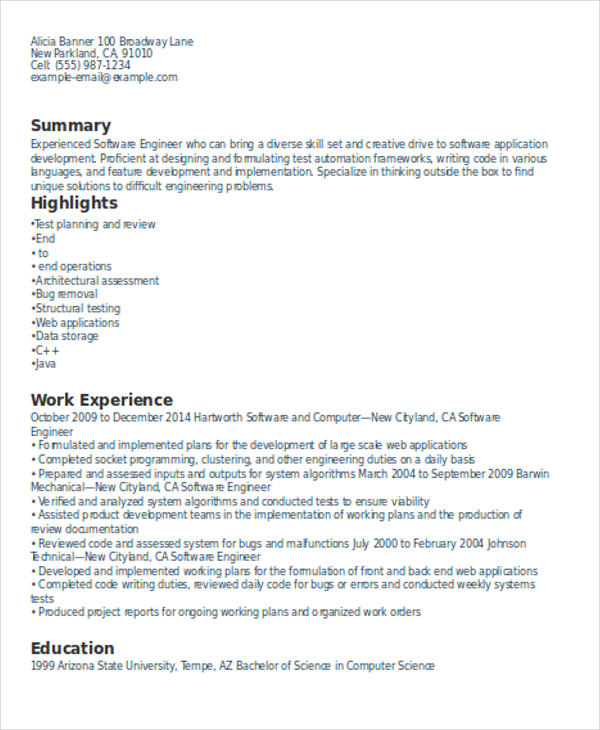
10 Years Experienced Resume for IT Professionals
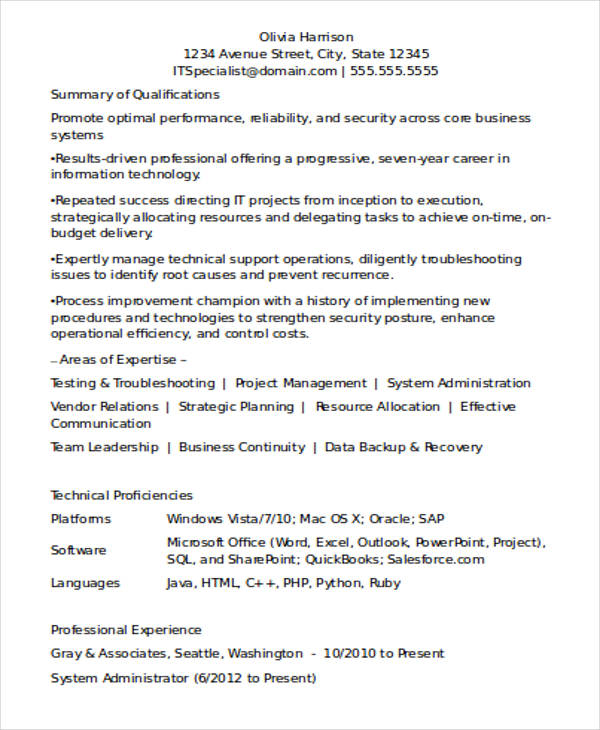
1 Year Experienced Resume Format for Job Interview
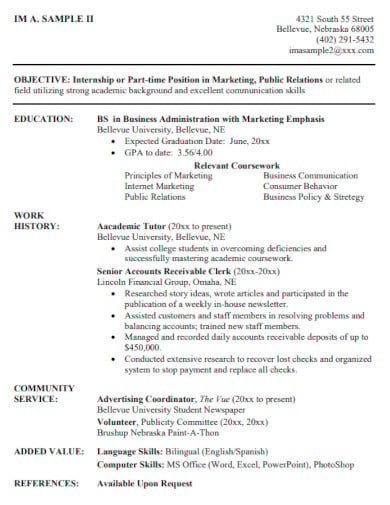
Beginner / Fresher Teacher Resume Format
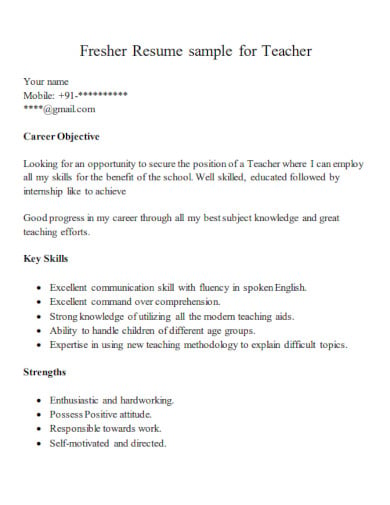
More in Resume
Experienced Mechanical Engineer Resume
Experienced photographer resume, experienced lawyer resume, experienced golf caddy resume, experienced administrative assistant resume, experienced school teacher resume, experienced civil engineer resume, experienced accountant resume cover letter, experienced teacher resume, experienced resume for teachers.
- 12+ HR Fresher Resume Templates
- 21+ Fresher Resume Templates
- 21+ Nurse Resume Templates – PDF, DOC
- 39+ Accountant Resumes in Doc
- 19+ Doctor Resume Templates – PDF, DOC
- 7+ Fresher Accountant Resumes
- 36+ Resume Format – Word, PDF
- 47+ Engineering Resume Templates in Word
- 13+ Computer Science Resume Examples
- 28+ Fresher Resume Templates in Word
- 10+ IT Fresher Resumes
- 48+ Resume Formats in PDF
- 50+ Best Resume Templates to Download
- 3+ Recruitment Consultant CV Templates in PDF
- 12+ Logistics Resume Templates in PDF | MS Word | Apple Pages
File Formats
Word templates, google docs templates, excel templates, powerpoint templates, google sheets templates, google slides templates, pdf templates, publisher templates, psd templates, indesign templates, illustrator templates, pages templates, keynote templates, numbers templates, outlook templates.
Build my resume
- Build a better resume in minutes
- Resume examples
- 2,000+ examples that work in 2024
- Resume templates
- Free templates for all levels
- Cover letters
- Cover letter generator
- It's like magic, we promise
- Cover letter examples
- Free downloads in Word & Docs
22 Data Engineer Resume Examples That Work in 2024
Data engineer resume.
- Data Engineer Resumes by Experience
- Data Engineer Resumes by Role
Writing Your Data Engineer Resume
Data engineer resume faqs.
You can build a data pipeline that ingests multiple data sources; you’re great at creating tools that everyone in your company can use. From data analysts to executives, you make the ETLs so they can easily consume data. You’re a master at thinking through the many complicated steps of turning messy data into something usable.
All in all, you’re a great data engineer.
You shouldn’t also have to be great at writing a resume or a data engineer cover letter , but that’s what it takes to get a data engineer job.
These data engineer resume templates are proven to help professionals land jobs at great companies like Stripe and Facebook . We’ll also give you a few expert resume tips to ensure you put your best foot forward to help you land your next data engineer role in 2024.
or download as PDF
Why this resume works
- Start your data engineering career by pursuing a bachelor’s degree in computer science. According to current job-seeking best practices, having a bachelor’s degree is a fundamental starting point guaranteed to land an applicant an internship.
- Your proven history of dedication and experience alone will pay off excellently when you’re moving from intern/junior to mid-level. From there, experience and skills are the only deciding qualifiers needed to continue climbing the ladder of seniority.
Entry-Level Data Engineer Resume
- A bachelor’s degree in computer science is a versatile tool to leverage, while an excellent GPA will catch the reader’s eye, underscoring your work ethic while in school.
- You can also add any awards you won in school, especially if they relate to engineering and computer science.
- And if you have any resume-relevant interests and hobbies , you can add them to highlight skills like curiosity, a passion for learning, and dedication (Plus, this gives you fun things to talk about in the interview!)
- Complementary to your bachelor’s degree, internships exist to provide current students and recent graduates with real job experience. While some internships and apprenticeships exist outside academia, a majority of employers require you to be a current or aspirational degree holder.
- You can also consider using a resume objective as an entry-level candidate to highlight your strengths in a potent, quantified nutshell that introduces your abilities and adds to an otherwise short resume.
Mid-Level Data Engineer Resume
- A mid-level position, regardless of industry, can be an extremely delicate situation to navigate. The fragile nature is due to mid-levels already having a substantial proven history of driving value and being on the cusp of senior-level positions, and needing to finalize their career niche.
- The first is asking yourself where you have most enjoyed the time spent in your previous positions.
- The second is where you would like to further hone your career path in aspiring for a specialized senior position.
- By analyzing your answers to those two questions, you will be able to leverage current market data to hone your resume skills and guide future learning toward your desired path of seniority.
Senior Data Engineer Resume
- Using a resume template will automatically format your resume according to industry standards, but if you choose to build your own resume, learn some resume formatting tips , such as putting your most recent position at the top of the page to ensure the hiring manager reads it.
- Start by scanning the job description for the position you want, then move on to other senior data engineer job descriptions. This will help you discover skills that will satisfy most senior data engineers, which you can then include in your skills section and bullet points.
Lead Data Engineer Resume
- In IT recruiting, the average amount of time a reader will spend on any given resume is roughly six seconds.
- Similar to a resume objective , a career summary exists to inform the reader (recruiter, hiring manager, etc.) of your qualifications, your interest in the position, and your relevant personality traits in an easy-to-understand format. However, a summary is for those who have 10+ years in the industry and want to highlight their specializations.
- When writing a career summary, focus on what makes your experience unique. What certifications do you have? What makes your goals for the position different from other candidates?
- Include quantifiable metrics wherever possible to give further overview and insight into your career without taking up too much space.
Python Data Engineer Resume
- Phrases like – implemented data quality checks in Apache Airflow DAGs and engineered scalable data solutions on AWS using EMR – run the show in Nina’s Python data engineer resume. They demonstrate her skillset in action and could give her that edge over her competitors.
PySpark Data Engineer Resume
- Taking a peek at Oscar’s PySpark data engineer resume, bolded and underlined phrases like – Enhancing data processing efficiency by 72%, saving $23,826 in annual computation costs, and expanded HDFS storage capacity by 198% – tell a compelling story of capability and success.
Databricks Data Engineer Resume
- A simple one-column layout fits the bill for a Databricks data engineer resume. Why? It’s a breath of fresh admittance for the recruiter’s eyes, who’s probably been squinting at a sea of sameness. And even better, it exudes professionalism, which could tip the scales in your favor.
Cloud Data Engineer Resume
- Got a computer science degree, maybe from a reputable institution like the University of Southern California? Let that gem shine bright in the EDUCATION part of your cloud data engineer resume. To amp the impressiveness, flaunt job-relevant technical skills (think Docker, Apache Hadoop, Talend, Tableau, etc.) and certifications, right there beneath your education creds.
GCP Data Engineer Resume
- You can hardly go wrong with an eye-catching color (like orange) for the header, your alma mater, and former/current places of work. A structured layout featuring bold, larger section subheadings and bullet point lists comes in handy for ensuring your competencies shine in their best light.
Snowflake Data Engineer Resume
- Matching your Snowflake data engineer resume to the job post is a breeze. Absorb the job description like a tech manual, pinpointing the keywords that resonate with the role. Then, incorporate these terms naturally and honestly into your resume so it mirrors the language and the requirements of the position you’re eyeing.
Data Center Engineer Resume
- Consider Alyssa’s data center engineer resume as a blueprint here —a single-column, one-page template that plays nice with the ATS and integrates the must-have sections (the header, work history, education, and skills). See how each section is tailored to delineate her technical acumen and achievements in data center operations without the clutter.
AWS Data Engineer Resume
- Any experience working with AWS should go straight to the top of your resume. It’s the fastest way to establish yourself as an expert in the platform.
Azure Data Engineer Resume
- Evidence your expertise in Azure to set yourself apart from the field of accomplished data engineers.
Big Data Engineer Resume
- Because of this skillset, your big data engineer resume needs to focus on one big (pun intended) thing: data.
- Quantifiable metrics are always a best practice when it comes to your resume, but BDEs take that to the extreme. By highlighting massive amounts of raw data for the resume reader, you instill confidence in your proven history. Adding these details isn’t as hard as it sounds, but our free resume checker can assist if you’re in doubt.
Senior Business Intelligence Data Engineer Resume
- The first is the job description’s list of required skills. This will give you the exact keywords needed to include in a resume maker (provided you possess those skills).
- Sometimes, data engineer job descriptions don’t include tidy lists of skills they require, but they do list requirements and expectations. Read between the lines to find skills they would need in their new hire.
- The second data source is senior business intelligence data engineer job descriptions focused on a specific geographic location. After evaluating the market’s desired skill requisites, you can adjust your expertise to the general “heartbeat” of what hiring managers in a given area are seeking.
Power & Performance Data Engineer Resume
- Management is a great skill to include, whether it’s self-management, managing a few team members, or supervising an entire department. Talk about a proven leadership experience to set you apart from other candidates.
- Pick a Google docs template or a resume template that looks tidy and highlights your strengths in the order best suited to the position.
Data Engineer Analyst Resume
- Additionally, a junior to mid-level role that you’ve held for several years will further prove a historical ability of driving value.
- You can design your data engineer analyst resume with a singular target role in mind. For example, if you convince the employer you have all the relevant skills for the job, you can easily land an interview, even if your years of experience are below the “ideal candidate” minimum.
Computer Vision Data Engineer Resume
- Quantify the impact you’ve brought to your previous computer vision data engineering roles within a resume template that promotes your professionalism. For example, did your data acquisition and visualization indicate any major trends? Was the data utilized on a massive scale or from a unique source?
- These can be rough estimates, as the main goal is to showcase your ability to drive high value in your positions. And again, strut your stuff in style with pre-made templates like our free Word resume samples or editable Google docs resumes .
Remote Data Engineer Resume
- Early career data engineers need to take every opportunity to demonstrate the depth and breadth of their industry knowledge.
- The key here isn’t reinventing the wheel but creating something dynamic and unique that can’t be easily replicated with a few Google searches and a video tutorial.
- When properly navigated, your first role will help define the rest of your career and help you secure any relevant position in the future.
- The key is to properly articulate your hard work, effort, and attention to detail in an organized way.
- We suggest a reverse-chronological resume format to successfully showcase your most current work history first on your remote data engineer resume.
Data & Platform Engineer Resume
- Whenever and wherever possible, it’s paramount to include key metrics and quantifiable high-performance indicators . In the broad data field, numbers and data are your “raison d’être” or your “reason for being.”
- Ensure your summary’s top-notch by customizing it to the target business, mentioning the company by name, and including relevant job description keywords.
Data Analytics Engineer Resume
- Analyze data engineer job descriptions and take note of consistent skill requirements. These can serve as a roadmap of what to include in your data analytics engineer resume .
- You can proactively optimize your resume for the ATS (Application Tracking System) by matching keywords (skills) commonly found in the majority of data engineer job descriptions.
- Specialize by taking the list of consistent skills and narrowing them down into a personalized resume skills section of 10 or fewer skills you possess. Pick the ones you’re most comfortable talking about in an interview to maximize your effectiveness.
Related resume guides
- Data Science Resume
- Data Analyst
- Cyber Security
- Computer Science
According to the US Bureau of Labor Statistics (BLS), the median salary for data engineers is $94,000 . At the same time, the expected annual growth rate is nine percent year over year (faster than average).
It’s no wonder software engineers are flocking toward data engineering roles, but data engineers require a rare combination of skills to succeed.
They need to be great developers and have an appreciation for how other members of their team use data. While data scientists need data that can be plugged into their predictive models, data analysts need a queryable database to create visualizations for executives.
It’s not easy to demonstrate in a single-page resume that you can build robust data pipelines, create ETLs for different data sources, and ensure uptime of all data congestion. How can you ensure you cover all your bases in your data engineer resume?
While there are no hard and fast rules, we’ve talked to hiring managers at top tech companies to distill what works and what doesn’t to help ensure you get that first-round interview. In short, here’s what you need to do:
- First and foremost, you should include the right skills in your resume skills section . Companies use automated software to weed out applicants at this stage, so use specific keywords in your skills section to get past these filters.
- Make sure your resume is in the right format. You have to not only get past the automated filters but also make your resume appealing to the hiring manager.
- Quantify the impact of your work experience. Numbers speak louder than words, so use quantitative metrics to shout about your qualifications for the role to which you’re applying.
- Tailor your resume to each role to which you’re applying. It does take a bit of time, but you will land significantly more interviews by customizing your resume to each data engineer job description .
The data engineer resume skills section
Believe it or not, the “skills” section of your resume is one of the most important. Why? Before a human reviews your resume, an automated filter scans it, and y ou need to appease the automation wizard .
Companies use an Applicant Tracking System (ATS) to manage all applicants they get for a given role. In addition to helping companies manage applicants, an ATS allows the hiring manager to filter out candidates based on certain keywords.
So first things first, you need to get past this filter before a person ever even considers your qualifications for the job to which you’re applying.
You need only to include the hard skills that qualify you for the given data engineering role . Exclude soft skills. For example, saying you have “strong communication skills” is meaningless without context.
For data engineers explicitly, there are more existing technical skills than you could ever have. For this reason, companies only use ATS filters to screen for hard resume skills. Here are some common ones you can list to get past the keyword filters.
Sample data engineer skills to include on your resume
- Programming languages : Python, Scala, Java
- Data processing : Spark
- SQL : Redshift, Postgres, MySQL
- NoSQL : MongoDB, Cassandra, ElasticSearch
- Storage : Parquet, Avro, Arrow, JSON
- Orchestration tools : Airflow, Luigi, Azkaban
- Cloud providers : AWS, Azure, GCS
- AWS tools : EMR, Lambda, S3, Athena, Glue, RDS
You would never be expected to have all of these. Instead, you should demonstrate a mastery of a few tools and languages instead of a light breadth of a whole host. Having a laundry list of skills is a big red flag to the hiring manager who will review your data engineer resume.
As a rule of thumb, only include skills for which you’d be comfortable being interviewed . A surefire way to get on an employer’s blacklist is if you lie on your resume. Don’t do it; it’s just not worth it. You would be much happier landing a data engineering job that you’re a good fit for than having to scramble on day one.
Format your resume correctly
Ensure the format of your data engineer resume format is appealing to the employer and consumable by the automated filters. To that end, here are some quick resume formatting tips :
- Keep your resume to one page.
- Don’t put your full address. Just your city and zip code.
- Avoid any graphics, images, or charts on your resume. The ATS can’t read these.
- Triple and quadruple-check for grammar and spelling errors. Don’t let this be the reason you’re skipped over for an interview.
- Only include a resume objective if you have a particular passion for the job you’re applying to or undergoing a career change. Otherwise, leave it out.
- If you’re fresh out of college looking for your first full-time data engineering role, include relevant classes you took.
- Every bullet on your work experience should be a complete thought. Avoid big blocks of text.
You should have one simple goal as your north star with your resume format: make the reader’s job as simple as possible.
Put yourself in the shoes of the person reviewing hundreds of resumes for a given role. You don’t want to read walls of text spanning multiple pages. You want to read something concise that conveys why the applicant is a good fit.
Education for senior vs. entry-level data engineers:
When you’re a data engineer with a few years of experience under your belt, your education matters less than your work experience.
For that reason, the education section of your resume will vary if you’re an experienced data engineer vs. fresh out of college or boot camp.
Education section differences
- Include relevant software engineer, statistics, or math classes you studied in school
- Include your GPA if it was greater than 3.2
- No need to include college classes on your resume; use this space to talk about your experience
- No need to include your GPA
Don’t waste space with classes you took in school. Since your goal should be to keep your resume to one page, optimize that space as a senior data engineer. Similarly, your GPA won’t make a convincing case of your qualifications once you have a few years of work under your belt.
As an entry-level data engineer, you need to demonstrate your capacity for learning new technical skills. What better way than talking about the tough classes you studied?
Resume objective for data engineers:
Most data engineers should not include a resume objective on their resume. Why? It comes back to the aim of making your resume one page.
Most resume objectives only mention generic information that can otherwise be gleaned by reviewing the rest of your resume.
As a rule of thumb, if you’re using the same resume objective for multiple job applications, just exclude it.
There are two instances in which it’s worth it to include a resume objective.
- If you have a particular interest in the role or company to which you’re applying
- You’re undergoing a career change
WRONG—generic resume objective
Looking for a data engineering role where I can leverage my Python knowledge to turn disparate data sources into actionable insights for a data-driven organization.
RIGHT—resume objective that conveys passion for the company’s mission
Data engineer seeking to leverage my experience in building data pipelines to contribute to the Stripe mission of making payments easy and accessible for small businesses across the world.
RIGHT—resume objective for a career change
Data engineer transitioning from a career in software engineering looking to work with Apple to leverage my experience with ETLs to create products that make it easier for non-coders to build businesses.
Quantify the impact of your work
You’re a data engineer, so using numbers is the best way to talk about your work experience. Data engineers are unique because you know exactly how much raw data you’re consuming and how much clean, polished data you’re pushing out to your data warehouses.
You need to convince the hiring manager that you’re the best fit for the data engineering role to which you’re applying. To make your data engineer resume better than 95 percent of others, quantify the impact of your work.
How to quantify your work as a data engineer
- Example: Built a data pipeline that ingested 3 billion rows of data daily from 17 different data sources and piped that data into Azure
- Example: Built a more efficient ETL using Airflow and Redshift that saved the company $320,000 annually
- Example: Created consistent data sources that were used by the data science team to create marketing mix models, resulting in $1.2M in annual revenue
- Example: Created monitoring alerts for data pipelines that improved the uptime of the network by 17% year over year
- Example: Used Spark Streaming to consolidate and clean transactional and event data, resulting in speed improvements of 24% in the production web app
Numbers are more convincing than vague accomplishment statements. Whenever you can (even if they’re estimates), try to quantify the impact of the work you did in previous roles.
No matter where the hiring manager looks on your resume, they should come away feeling that you deserve a phone interview. The best way to make such a convincing case is to let the numbers speak on your behalf.
Just to hammer home the point one more time, consider which work experience is more convincing:
WRONG—vague work experience
AT&T April 2015 – January 2018, New York NY Data Engineer
- Automated ETL processes to streamline data workflows
- Created data pipeline that ingested streaming and transactional data and output cleaned data to Redshift
RIGHT—quantify the impact of your work
- Automated ETL processes across billions of rows of data which reduced manual workload by a monthly 33%
- Maintained data pipeline up-time of 99.9% while ingesting streaming and transactional data across 7 primary data sources using Spark, Redshift, S3, and Python
Entry-level data engineer resume projects
If you’re an entry-level data engineer without any work experience (or “fresher,” as the kids call it these days), you need to convince the hiring manager that you’re worth interviewing.
Employers love to see candidates going above and beyond by highlighting personal projects they’ve worked on related to their careers. How can you do that? By talking about past projects on which you’ve worked.
For an entry-level data engineer, anything counts! As long as you were ingesting data and making it usable for another party, it’s worth including it on your resume.
If you have no such projects, now would be a great time to work on one. Here are some project ideas you can include:
Sample projects for entry-level data engineers
- Created web scraper in Python for fantasy football and developed a data pipeline to output that data into a MySQL database
- Created a stored procedure in the database for the D&D club to monitor the performance of all players over time
- Volunteered with a local flower delivery company to automate the ingestion of their vendor data, saving 25 hours of manual work each month
- Worked with the university theater company to create a database of all patrons who came to paid shows over the last 5 years
- Used the Rottentomatoes API to create a robust time-series database of all movie scenes since 2015
It doesn’t matter if the project you worked on is relevant to the role. Hiring managers just want to know that you have the know-how and passion for learning what it takes to become a successful data engineer for entry-level positions.
Tailor your resume for each job
We know it’s the news you didn’t want to hear. Unfortunately, customizing your data engineer resume for each job you apply to drastically improves your chances of getting an interview.
Fortunately, only 15 percent of data engineers customize their resumes for each job, so if you go that extra mile, you’re in the top 15 percent automatically (#math)!
How do you tailor your resume for a given job? First, read the job description, responsibilities, and qualifications. Do any projects you’ve worked on come to mind as you read those?
Similarly, does anything come to mind as you read about the company? Even if what you’re thinking about seems like a stretch, it’s worth including on your resume.
Another way to assess is by asking yourself how you can best frame your work experience to be relevant to the role for which you’re applying. For example, if you’re applying for a position seeking someone to build ETLs from scratch and have experience working for startups, you should talk about that as much as possible!
Here are some ideas for tailoring your work experience to a specific role:
AWS data engineer resume tips
- If you’re looking for an AWS data engineer role, you should be able to show you know the right tool or framework to use at the right time.
- AWS has so many different services and data offerings that it will make your head spin. Rather than trying to demonstrate a knowledge of all these tools, show the context in which you’ve used the tools with which you’re most comfortable.
Azure data engineer resume tips
- If you’re comfortable with any other cloud provider, you most likely can adapt to Azure.
- Having Azure on your resume will allow you to apply to any role looking for a data engineer with Redshift or GCP experience.
- Azure is the classic example of “if you know one, you know them all.”
Big data engineer resume tips
- We don’t mean to burst your bubble, but “big data” is a nonsense phrase used by business professionals to convince themselves that they know what they’re discussing.
- Including “big data” on a resume is a bit of a red flag for any discerning hiring manager. It makes the hiring manager think the data engineer is more buzz than substance. Only use “big data” if you can quantifiably back it up with solid metrics.
- Stick to tangible outcomes and results. Rather than saying “big data” on your resume, include the actual scale of data with which you worked. Again, numbers speak louder than words.
Only include hard skills (for example, MongoDB, Azure, and RDS) in your resume skills section that you’re comfortable discussing in an interview. In your work experience section, use numbers to convey the impact of prior work (like using ETL processes to reduce workload by 13%). And finally, tailor your resume to the job by highlighting projects that speak to the challenges and needs of the data engineering position you’re hoping to snag.
Running out of room? Save the extra details of how you used ETL processes when using a cover letter maker .
Read the job description to see what the company specifically wants in its next data engineer. Consider any programming languages, data processing, SQL, NoSQL, storage, orchestration tools, cloud providers, and AWS tools mentioned in the job ad, and in a brief list, honestly include the skills you have that match.
Your one-page resume should look professional—free of grammar and spelling errors and organized in a reverse-chronological format to share your data engineer career history logically and clearly. Using a resume template can help you order your data engineer experience and qualifications.
Management Resume Summary: 15 Examples to Help You Write Your Own

As the first section recruiters see, your resume summary should highlight your top accomplishments and skills, tailored to the specific position you’re applying for. This is especially important for management roles, where a standout management resume summary can help you get noticed in a competitive job market.
Let’s break down what a manager's summary should include and give you templates and resume summary examples to help you create a standout one for various roles.
What is a resume summary?
A resume summary is a concise section at the top of your resume that offers a snapshot of your professional profile. Unlike a detailed resume experience section , a good summary for a resume provides a high-level overview of your most significant accomplishments , skills , and qualifications.
The goal is to capture the attention of hiring managers and recruiters by highlighting your key strengths and achievements in a few sentences or bullet points. It acts as a quick pitch to persuade employers to continue reading and consider you for the role.
Get that resume summary out there! Browse open jobs on The Muse and find your dream job »
Resume summary for management: how is it different?
A manager resume summary is a focused version of a resume summary that highlights qualifications and experiences specific to management positions. It emphasizes your leadership skills , strategic thinking, and ability to deliver results in areas like project management, office management, operations, general management, or retail management.
How to write a management resume summary
Your resume summary should not only showcase your qualifications but also set the stage for the rest of your resume, demonstrating to potential employers why you are the ideal candidate for their management position.
Follow these tips when writing your management resume summary:
1. Keep it brief
A resume summary usually has three to five sentences or a few bullet points. It helps hiring managers quickly see if you’re a good fit for the job without having to dig through your whole resume.
2. Highlight your leadership skills
Emphasize your experience in leading teams, managing people, and overseeing projects or operations. This could include examples of how you motivated your team, resolved conflicts, or achieved team goals.
3. Emphasize strategic planning and execution
Highlight your ability to develop and execute strategies that contribute to organizational success. Mention specific strategic initiatives you’ve led or contributed to, and how they impacted the company’s bottom line.
4. Demonstrate operational management skills
Showcase your expertise in managing day-to-day operations, optimizing processes, and ensuring efficient workflow. This could involve experience with budgeting, resource allocation, or process improvements.
5. Include quantifiable achievements
Include quantifiable achievements that demonstrate your effectiveness as a manager. For instance, if you're writing a project manager summary for your resume, you might mention increases in productivity, revenue growth, or successful project completions.
(Here's how to quantify your resume bullets —even if you don't work with numbers.)
6. Personalize industry-specific knowledge
Tailor your resume summary to reflect the industry you’re applying for. This can include specific industry-related skills, certifications, or knowledge of best practices. It should also include keywords and skills relevant to the job description, making it easier for Applicant Tracking Systems (ATSs) to identify your resume as a match.
Resume summary template
Here’s a general resume summary template you can use:
[Adjective] and [adjective] management professional with [number] years of experience in [industry]. Proven ability to [relevant skill] and [relevant skill] to achieve [specific result]. Adept at [specific management activity], with a strong focus on [key area of expertise]. Looking to leverage my expertise in [desired role] at [company name].
15 resume summary examples for management roles
Need more inspiration? Check out these 15 well-crafted management resume summary examples for different types of managers—one of them might be exactly what you're looking for.
Example #1: Project manager resume summary
Detail-oriented and strategic project manager with 10 years of experience in IT and software development. Proven ability to lead cross-functional teams and manage multimillion-dollar projects to successful completion. Adept at risk management and resource allocation, with a strong focus on meeting project deadlines and budget requirements. Looking to leverage my expertise in agile methodologies at XYZ Tech.
Find project manager jobs here on The Muse
Example #2: Office manager resume summary
Organized and proactive office manager with over 7 years of experience in administrative support and office operations. Demonstrated success in streamlining office procedures, improving communication, and enhancing overall efficiency. Skilled in team management and office software, looking to bring my strong organizational skills to ABC Corp.
Find office manager jobs here on The Muse
Example #3: Operations manager resume summary
Results-driven operations manager with 12 years of experience in manufacturing and logistics. Expertise in optimizing production processes, reducing costs, and improving quality control. Proven track record of leading teams to exceed performance targets and implement continuous improvement initiatives. Seeking to apply my operational leadership skills at DEF Manufacturing.
Find operations manager jobs here on The Muse
Example #4: General manager resume summary
Visionary and dynamic general manager with 15 years of experience in retail and hospitality. Known for driving business growth and enhancing customer satisfaction through strategic planning and team development. Skilled in financial management and operational efficiency, eager to lead the expansion of GHI Retail.
Find general manager jobs here on The Muse
Example #: Retail manager resume summary
Customer-focused retail manager with 8 years of experience in high-end fashion retail. Proven ability to increase sales through exceptional customer service and staff training. Strong background in inventory management and merchandising. Looking to bring my retail expertise to JKL Fashion Store.
Find retail manager jobs here on The Muse
Example #6: Assistant project manager resume summary
Efficient and supportive assistant project manager with 5 years of experience in construction. Known for assisting in the successful completion of projects by managing schedules, coordinating teams, and ensuring compliance with safety regulations. Seeking to contribute to the ongoing success of MNO Construction.
Find assistant project manager jobs here on The Muse
Example #7: Marketing manager resume summary
Innovative and strategic marketing manager with 9 years of experience in digital marketing and brand management. Proven track record of developing and executing marketing campaigns that increase brand awareness and drive sales. Skilled in data analysis and customer segmentation, looking to bring my marketing expertise to PQR Marketing Agency.
Find marketing manager jobs here on The Muse
Example #8: Sales manager resume summary
Ambitious and results-oriented sales manager with 10 years of experience in B2B sales. Demonstrated success in driving revenue growth, developing sales strategies, and leading high-performing sales teams. Adept at relationship building and market analysis, seeking to leverage my sales expertise at STU Corporation.
Find sales manager jobs here on The Muse
Example #9: Human resources manager resume summary
Compassionate and strategic human resources manager with 12 years of experience in employee relations and talent acquisition. Proven ability to develop and implement HR policies that improve employee satisfaction and retention. Skilled in conflict resolution and performance management, eager to join the HR team at VWX Enterprises.
Find human resources manager jobs here on The Muse
Example #10: Financial manager resume summary
Detail-oriented and analytical financial manager with 10 years of experience in corporate finance and accounting. Expertise in budgeting, financial planning, and risk management. Proven ability to optimize financial performance and provide strategic insights. Looking to bring my financial expertise to YZ Finance Group.
Find financial manager jobs here on The Muse
Example #11: Product manager resume summary
Innovative and customer-centric product manager with 8 years of experience in product development and lifecycle management. Proven track record of launching successful products and driving market penetration. Skilled in market research and cross-functional collaboration, seeking to apply my product management skills at ABC Tech.
Find product manager jobs here on The Muse
Example #12: Hospitality manager resume summary
Guest-focused and organized hospitality manager with 10 years of experience in hotel management and customer service. Proven ability to enhance guest satisfaction and operational efficiency. Skilled in staff training and event planning, looking to bring my hospitality expertise to DEF Hotels.
Find hospitality manager jobs here on The Muse
Example #13: Logistics manager resume summary
Proactive and efficient logistics manager with 7 years of experience in supply chain management and distribution. Proven ability to optimize logistics operations, reduce costs, and improve delivery times. Skilled in inventory management and vendor relations, eager to join the logistics team at GHI Logistics.
Find logistics manager jobs here on The Muse
Example #14: IT manager resume summary
Tech-savvy and strategic IT manager with 9 years of experience in IT infrastructure and project management. Proven ability to lead IT teams, manage budgets, and implement technology solutions that drive business growth. Skilled in cybersecurity and network management, looking to bring my IT expertise to JKL Tech Solutions.
Find IT manager jobs here on The Muse
Example #15: Customer service manager resume summary
Empathetic and results-driven customer service manager with 8 years of experience in customer support and team leadership. Proven ability to improve customer satisfaction and reduce response times through effective training and process improvements. Skilled in CRM software and conflict resolution, seeking to join the customer service team at MNO Services.
Find customer service manager jobs here on The Muse
Key takeaways
Your resume summary is a critical component of your management resume, serving as your first impression to potential employers. Use the examples and template provided in this guide to craft a compelling resume summary that showcases your management expertise and sets you apart from the competition.

IMAGES
VIDEO
COMMENTS
1. Entry-level. In an entry-level resume, you can include your relevant work experience by highlighting your educational training, volunteer experience or any internships that you may have completed. You might consider positioning this section just under your introduction or career objective. Additionally, you might consider the following ...
Experienced Job Seeking Tips. Professional 1. When you are applying for jobs, the first impression you make is going to be based entirely on your resume. This list of tips and strategies will help you write a strong resume so you can feel confident as you search for jobs as an experienced worker. Try to keep your resume shorter than two pages.
Essential tips: Make the first section your professional summary. For a highly experienced candidate like Jonathan, adding a professional summary at the very top is a quick way to concisely convey ...
Focus on results of your job history in the past. Only list work experience on a resume that is relevant to the job you're applying to. Stand out with strong action verbs. Get specific: use numbers, facts, and figures. Speak in the past tense when the job is complete, present when you're still doing the work.
1. Start by creating a professional layout. If you're not too keen on using free resume templates, you must make the layout from scratch. Begin making the resume format for an experienced candidate by taking the below steps: Set the resume margins to 1 inch on all sides and make line spacing 1 or 1.5 wide.
Your professional summary is your chance to sell yourself to your potential employer. And with 10 years of experience behind you, you have a lot to offer. The professional summary is a short statement that presents your strengths, years of experience, and professional goals. It might be hard, but try to keep it up to 3-4 sentences.
When listing your work experience on your resume, it's important to stay within the past 10 to 15 years of your career. For instance, if you have over 20 years' experience working in your career field, you will want to highlight only 10 to 15 years of your career. If you have work experience within different jobs and industries, though, it's ...
For most job seekers using a chronological or combination resume format, you should list your past jobs within your experience section (or sections) in reverse chronological order. For each item you list—full-time jobs or other types of experience—include the following: Position details: List your job title, company name, location, and ...
1. Put it under a clear, legible heading. Make sure your work experience section is clearly visible and has its own heading. You can name this section "Work Experience", "Experience" or "Employment History". 2. Place it right under the resume summary or objective.
So, here's how to list work experience on a resume, step by step: 1. Make the Section Heading Stand Out. Label your resume work experience section with one of the following titles: Work Experience. Experience. Employment History. Work History. Make the section title larger than the rest of your job descriptions.
Provides examples of quantifiable achievements. Throughout the experience section, this example uses specific numbers and percentages to demonstrate the candidate's impact. For example, "Create 10+ financial reports per week," "Manage a $350,000 budget, with a reduction of costs totaling 15% over 2 years," etc.
Best resume format example. The chronological resume format is what most job seekers should be using when applying for jobs: Download a Chronological Resume. When to use this format: You have no obvious gaps in your employment and want to emphasize your career progression. The chronological resume format is the most common type of resume.
Resume format 1: Chronological resume. Image description. A chronological resume lists your work experience in reverse-chronological order, starting with your most recent position at the top. This is the most traditional resume format and for many years remained the most common.
These resume templates are meant to make that selection process easier for you. Software engineer resume template PDF. Marketing resume template PDF. Human resources (HR) resume template PDF. Accountant resume template PDF. Nursing resume template PDF. Business analyst resume template PDF.
Combination Resume Format for 10 Years of Experience. Balances chronological and functional formats. Highlights both career progression and key skills. Increasingly accepted in various industries. Offers flexibility for tailoring the resume to job requirements. High compatibility with ATS, suitable for online job applications.
If you want to make an executive work experience resume, then you are in the right place! This website will provide you helpful tips on making personal experience resume. Here is how: 1. Decide On Your Experience Resume Format. There are three common types of resume formats that you can utilize—chronological, functional, and combination. For ...
Tested on all major ATS software, Enhancv resume templates help you create a professional resume fast. Choose from 40+ free & premium modern, basic, traditional and minimalist resume templates for a job-winning resume! ... (1-3 years of experience) Senior (3-7+ years of experience) Executive. 10+ years of experience) Intern. Entry Level (no ...
Just mentioning the city and the state is sufficient. If any of your past work experience was work from home, you can either mention your current location or simply write ' remote work ' in the job location part. 3. Specify the dates of employment. Next, you should mention the start and end dates of each employment.
These resume samples are proven to help qualified Java devs get more job interviews in 2024. Resumes. AI resume builder . Build a better resume in minutes . ... Experienced Java developer with 9+ years of experience participating in all phases of the software development lifecycle, including estimating, technical design, implementation ...
In total this is 2 years and 9 months of paid programming experience. It's not exactly 3 years but pretty close. I think saying 2 and 3/4 years is kind of odd. That also doesn't include the practicum projects I've worked on. On my resume I've said: Software Developer with 3 years of experience programming applications in XYZ for mobile devices.
So avoid using an objective and instead begin your resume with a profile summary of what you offer. The Five Steps to a Profile . When you're ready to start your profile, follow these steps: Step 1. Write a simple statement of your job title and years of experience. For example, say you're a sales manager who has risen through the ranks ...
Photographer Resume [18+ Templates To Download] 9+ Sales Manager Resume Templates. Use a Sample in DOC, PDF, or Other Format to Compose a Resume or CV for a Seasoned Job Candidate in IT, Marketing, Sports, etc. You'll Find Standard Example Documents Suitable for a Person with 1 year, 2 year, 3 year, 5 years, or 10 years of Experience.
22 Data Engineer Resume. Examples That Work in 2024. Stephen Greet July 22, 2024. You can build a data pipeline that ingests multiple data sources; you're great at creating tools that everyone in your company can use. From data analysts to executives, you make the ETLs so they can easily consume data. You're a master at thinking through the ...
Example #9: Human resources manager resume summary. Compassionate and strategic human resources manager with 12 years of experience in employee relations and talent acquisition. Proven ability to develop and implement HR policies that improve employee satisfaction and retention.
Let's Eat, Grandma - Best Resume Builder for Range of Career Service. Star Rating: 4/5. Let's Eat, Grandma is an inventive and progressive tool for creating impressive resumes. The platform ...